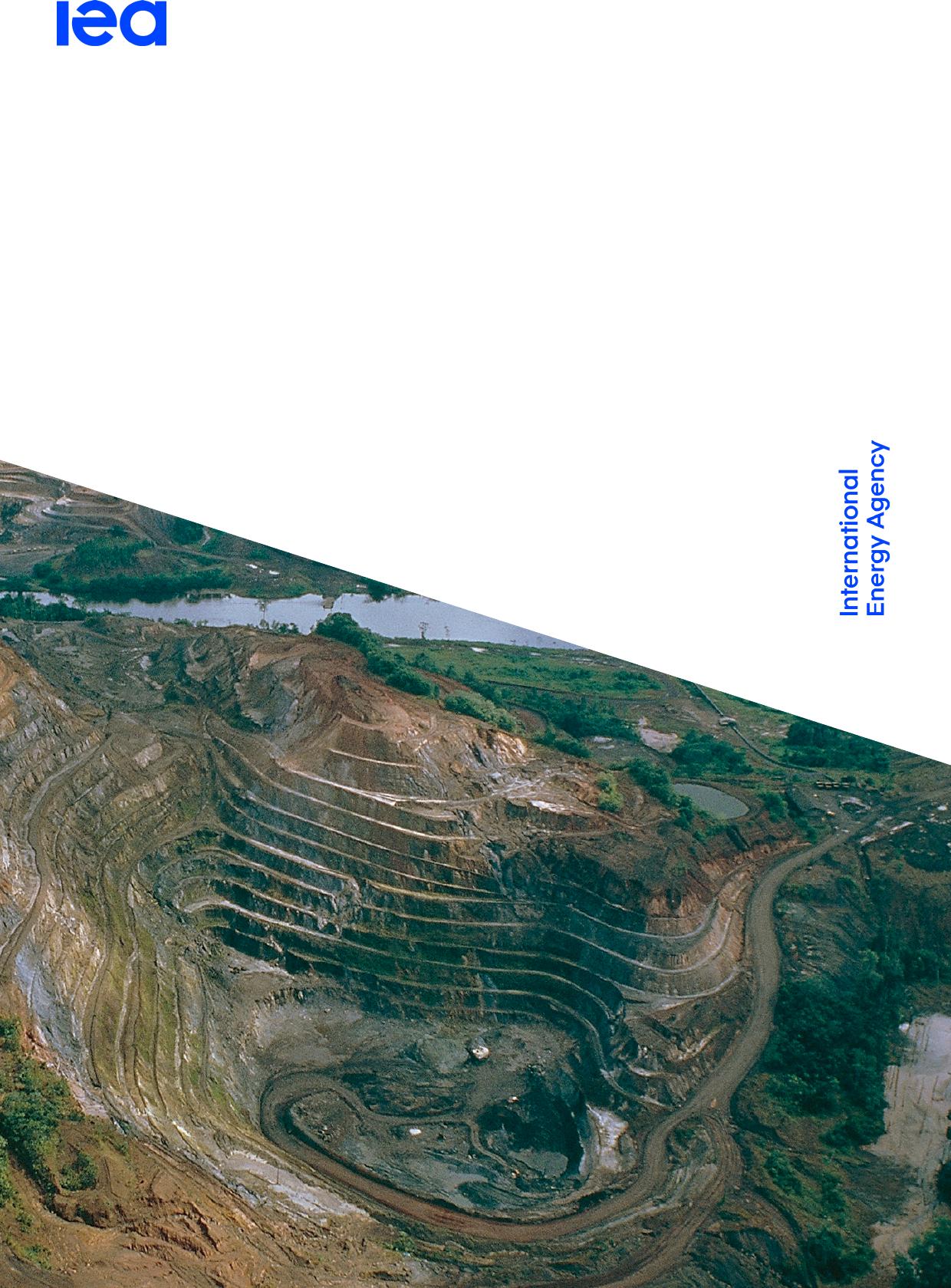SustainableandResponsibleCriticalMineralSupplyChainsGuidanceforpolicymakersINTERNATIONALENERGYAGENCYTheIEAexaminestheIEAmemberIEAassociationfullspectrumcountries:countries:ofenergyissuesincludingoil,gasandAustraliaArgentinacoalsupplyandAustriaBrazildemand,renewableBelgiumChinaenergytechnologies,CanadaEgyptelectricitymarkets,CzechRepublicIndiaenergyefficiency,DenmarkIndonesiaaccesstoenergy,EstoniaKenyademandsideFinlandMoroccomanagementandFranceSenegalmuchmore.ThroughGermanySingaporeitswork,theIEAGreeceSouthAfricaadvocatespoliciesthatHungaryThailandwillenhancetheIrelandUkrainereliability,affordabilityItalyandsustainabilityofJapanenergyinitsKorea31membercountries,Lithuania13associationLuxembourgcountriesandbeyond.MexicoNetherlandsThispublicationandanyNewZealandmapincludedhereinareNorwaywithoutprejudicetothePolandstatusoforsovereigntyoverPortugalanyterritory,totheSlovakRepublicdelimitationofinternationalSpainfrontiersandboundariesandSwedentothenameofanyterritory,Switzerlandcityorarea.RepublicofTürkiyeUnitedKingdomUnitedStatesTheEuropeanCommissionalsoparticipatesintheworkoftheIEASource:IEA.InternationalEnergyAgencyWebsite:www.iea.orgSustainableandResponsibleCriticalMineralSupplyChainsAbstractAbstractAsdemandgrowsforcriticalmineralstosupportcleanenergytechnologydeployment,potentialnewminesandprocessingfacilitieswillputgrowingpressureonpeople,theenvironment,communitiesandIndigenousPeoples.Thisreportexploreshowtheenvironmental,socialandgovernanceimpactsofminingandprocessingoperationscanlimitthecriticalmineralsuppliesneededforcleanenergytransitionsandoutlinesfivekeyrecommendationsforpolicymakerstoensurethatcriticalmineralsupplychainsaresustainableandresponsible.Italsoincludesdeepdivesonsixpriorityareasthathaveimportantimplicationsforsupplysecurity:water,greenhousegasemissions,biodiversity,humanrights,communitiesandcorruption.ThisreportisreleasedalongsideanupdatetotheCriticalMineralsPolicyTracker.The2023updateincludesover200newpolicies,lawsandregulationsandincludesaspecialfocusonpoliciesaimedatenvironmental,socialandgovernanceissues.PAGE3IEA.CCBY4.0.SustainableandResponsibleCriticalMineralSupplyChainsAcknowledgementsAcknowledgementsThisreportwaspreparedbytheInternationalEnergyAgency(IEA)OfficeofLegalCounsel(OLC).ThisreportwaspreparedincloseconsultationwithandwiththesupportoftheEnvironmental,SocialandGovernanceTaskForceoftheCriticalMineralsWorkingParty(CMWP).Thereport’sprincipalauthorswereK.C.Michaels,AlexandraHegartyandJoyceRaboca,withamajorcontributionbyTomásdeOliveiraBredariol.OtherIEAcolleagueswhocontributedtothisworkincludeEricBuisson,JulietteDenis-Senez,NoahGipson,LisaShakhnazaryanandSofieUlrix.TimGould,Tae-YoonKimandPascalLaffontprovidedinvaluablecommentsandfeedback.ColleaguesfromtheOrganisationforEconomicCo-operationandDevelopment(OECD)CentreforResponsibleBusinessConductalsoprovidedindispensableinputandreview,includingBenjaminKatz,CäcilieLeGallic,LouisMaréchal,KenMenzandEmilyNorton.Valuablecommentsandfeedbackwerereceivedfromexternalexperts,including:CarolineAvanBusinessHumanRightsResourceCentreCassieBoggsMininglawexpertGrantBromhalUnitedStatesDepartmentofEnergyOliverBrownUnitedNationsEnvironmentProgrammeElisabethCaesensResourceMattersEllenCareyCirculorAsshetonCarterFairCobaltAllianceBenChalmersTheMiningAssociationofCanadaVincenzoConfortiGlencoreAidanDavyInternationalCouncilonMiningandMetalsPierreDePascalTheInitiativeforResponsibleMiningAssuranceStefanDebruyneSQMKristiDisneyBrucknerTheInitiativeforResponsibleMiningAssuranceSebastianDunnettUnitedNationsEnvironmentProgrammeJasonFarrOxfamKatieFedosenkoTeckResourcesSusannahFitzgeraldNaturalResourceGovernanceInstituteAnne-MarieFleuryGlencoreDiegoFrancescoMarinEuropeanEnvironmentalBureauGudrunFrankenInstituteforGeosciencesandNaturalResources,GermanyCatherineGirardRenaultPAGE4IEA.CCBY4.0.SustainableandResponsibleCriticalMineralSupplyChainsAcknowledgementsEmilyGreenspanOxfamSolangeHarphamParisPeaceForumDanielHillNaturalResourcesCanadaAbigailHunterSAFEFredKabandaAfricanDevelopmentBankSophieLuHSBCCeciliaMatteaTransportandEnvironmentFerdinandMaubryTeslaSusannahMclarenCobaltInstituteTomMoerenhoutCenteronGlobalEnergyPolicyatColumbiaUniversityMarcellaMunroTeckResourcesZubeydeOysulSAFELauraPlatchkovFederalOfficefortheEnvironment,SwitzerlandIsabelleRamdooTheIntergovernmentalForumonMining,Minerals,MetalsandSustainableDevelopmentRobinRoelsEURawMaterialsCoalitionYblinRomanEscobarSIRGECoalitionSebastianSahlaExtractiveIndustriesTransparencyInitiativeMatthieuSalomonNaturalResourceGovernanceInstitutePayalSampatEarthworksKatherineShapiroNaturalResourcesCanadaVeronikaShimeNationalMiningAssociationMatthewTehAustralianCriticalMineralsOfficeJimWormingtonHumanRightsWatchFinally,thanksalsototheIEACommunicationsandDigitalOffice(CDO)fortheirhelpinproducingthepublication,particularlytoJethroMullen(ActingHead),AyaAbuShaqra,PoeliBojorquez,CurtisBrainard,AstridDumond,ClaraValloisandThereseWalsh.ErinCrumeditedthemanuscript.PAGE5IEA.CCBY4.0.SustainableandResponsibleCriticalMineralSupplyChainsTableofcontentsTableofcontentsExecutivesummary..................................................................................................................7Introduction.............................................................................................................................11PartI:Leversforpolicyaction..............................................................................................171.Ensuringrobustregulatoryregimes..................................................................................172.Directedpublicspending...................................................................................................203.Trackingandmonitoringperformance..............................................................................244.Makingsupplychainsmoretransparent...........................................................................295.Supportforvoluntarysustainabilitystandards..................................................................36PartII:Focusareas................................................................................................................441.Water.................................................................................................................................452.Greenhousegasemissions..............................................................................................523.Biodiversity........................................................................................................................614.Humanrights.....................................................................................................................715.Communities.....................................................................................................................806.Corruption.........................................................................................................................88Annex.......................................................................................................................................98Abbreviationsandacronyms.................................................................................................98PAGE6IEA.CCBY4.0.SustainableandResponsibleCriticalMineralSupplyChainsExecutivesummaryExecutivesummaryCriticalmineralsupplychainscannotbetrulysecure,reliableandresilientunlesstheyarealsosustainableandresponsible.Growingdemandforcriticalmineralsarisingfromthecleanenergytransitionwillmeannewmines,processingfacilitiesandrefineries,whichcanbringattendantrisksofharmtotheenvironment,workers,communitiesandsocieties.Theseharms,ifnotadequatelyprevented,reducedormitigated,candisruptsupplyandhindertherapidscale-upofcleanenergytechnologies.Thefirstandforemostreasontoaddresstheenvironmental,socialandgovernancerisksinthemineralsupplychainistoprotectpeople,communitiesandtheenvironment.Addressingtheserisksallowsforthedevelopmentofsustainableandresponsiblesupplychains,whichcanhelpcommunitiesmorefullycapturethebenefitsofmineraldevelopmentandensurethatcleanenergytransitionsarepeople-centred.Growthinthecriticalmineralssectorcanleadtoinvestment,taxrevenue,andjobs.Atthesametime,adoptingsustainableandresponsiblepracticesbolsterssecurityofsupply.Forexample,comprehensivelyaddressingcommunityconcernsaboutwateruseandbiodiversityimpactsmakesprojectslesslikelytoencounterlocaloppositionthatcanhaltprojectdevelopmentordisruptoperations.Similarly,eliminatingorreducingtheincidenceofcorruptioncanhelpavoiddelaysandincreasedprojectcostsassociatedwithinstancesofbribery.Ontheotherendofthesupplychain,ifcompaniesareunabletodemonstratethattheyhavetakenarisk-basedapproachtopreventhumanrightsviolationssuchaschildandforcedlabour,theymayfaceregulatorybarriersorreputationalrisks.Governmentsandcompaniesalikehavearoleindrivingimprovementsagainstenvironmental,socialandgovernancestandards.Companiesarelikelyinthebestpositiontoexpandsustainableandresponsiblepracticesandtotransparentlyreportonprogress.Inparallel,governmentscanensurethatcompanieshavetherightincentivestoactandcreateanenablingenvironmentthatfacilitatesimprovedperformance.Consideringtheavailableleversforaction,wehaveidentifiedfivekeyrecommendationsforpolicymakerstoensurethatcriticalmineralsvaluechainsaresustainableandresponsible:First,ensurerobustlegalandregulatoryprotectionsfortheenvironment,workersandcommunities.Mostcountrieshaveexistingregulatoryframeworkstargetingminingandprocessing.Asthecriticalmineralslandscapechanges,therePAGE7IEA.CCBY4.0.SustainableandResponsibleCriticalMineralSupplyChainsExecutivesummarymaybeaneedtorevisittheseframeworkstoreducepermittingleadtimesandtoensureadequateregulatoryprotectionsareinplace.Waterandgreenhousegasemissionstargets,wheretheyexist,canbemadetoimproveovertime.Enhancedrequirementsformeaningfulandcontinuousengagementwithlocalcommunitiesandusingfree,prior,andinformedconsentasbestpracticeforIndigenousPeoplescanfacilitateasociallicensetooperate.Adequateinvestmentinenforcementandimplementationisalsoneeded.Second,channelpublicspendingtoencouragethedevelopmentofbetterpracticesandtorewardgoodactors.Initiativestobolstersecurityofsupplyarebeingbackedwithpublicmoney,andgovernmentscantietheseexpenditurestosustainabilityandsocialresponsibilityrequirements.Forexample,publicprocurementandinvestmentdecisionscanbeconditionedonhighsustainabilityperformance.Innovationfundingcanbedirectedtowardstechnologiesthatimproveoperationalefficiency,reduceemissions,orfacilitatemappingandtracingofmineralsthroughthesupplychain.Third,strengthenthecollectionandreportingofgranularandstandardiseddatatoenablebenchmarkingandprogresstrackingacrosstheindustryandthroughoutthesupplychain.Governmentshavethecapacitytoinfluenceindustry-wideperformancebyissuingmethodologicalguidelinesandrecommendationsforsustainabilityandsocialresponsibilitymetricsdrawingonindustrybestpractice.Further,publiclydisseminatingsuchdataisacriticalleverthatcanequipstakeholderswiththerequisiteinformationtomakesustainability-focusedsourcingandinvestmentdecisions.Forsmallerenterprises,technicalassistancemaybeneededtoguaranteerobustness,accuracyandrepresentativenessofdatamonitoring.Fourth,encourageorrequirecompaniestoimprovetransparencythroughoutthesupplychain,includingbyundertakingduediligenceandreportingpubliclyonrisksandmitigationactions.Greatertransparency,alongsideeffortstomitigateidentifiedrisks,canalleviateenvironmental,socialandgovernanceriskswhileensuringthatpurchasers,customersandpolicymakershavebetterinformationonpotentialbottlenecks.Governmentscandomoretoencouragetransparencyincriticalmineralsupplychains,includingbyincorporatingduediligenceintolegalrequirementsbasedonresponsiblebusinessconductstandardssuchasthosepublishedbytheOrganisationforEconomicCo-operationandDevelopment(OECD).Particularattentionshouldbepaidtothesmeltingandrefiningsector,wheregreatertransparencyisneeded.Fifth,supportthedevelopmentofcrediblevoluntarysustainabilitystandardsandencourageharmonisedapproachesconsistentwithinternationalstandards.Sustainabilitystandardsandothersustainabilityinitiativescanplayacomplementaryroletolegalandregulatoryrequirements.Thesesystemsprovideavenuestoimprovetheperformanceofcompaniesbeyondregulatoryrequirements,providedthattheyalignwithinternationalframeworksandcredibilitycriteria.BysupportingtheadoptionandimprovementPAGE8IEA.CCBY4.0.SustainableandResponsibleCriticalMineralSupplyChainsExecutivesummaryofstandards,governmentscanhelpdriveupenvironmentalandsocialperformancewithoutdisplacingtheroleforlegalandregulatoryprotections.Thesefiverecommendationsarecross-cuttingandapplytoalltypesofenvironmental,socialandgovernancerisks.Someoftheserisksareespeciallylikelytohindersupply,withimplicationsfortheviabilityofrealisingcleanenergytransitions.Inthisreport,wehaveidentifiedsixpriorityareasthathaveimportantimplicationsforsupplysecurity:water,greenhousegasemissions,biodiversityhumanrights,communities,andcorruption.Improvingwaterstewardshipcanreducesupplyrisks,especiallyforcriticalmineralswithhighwaterrequirements.Lithiumandcopperminesareoftensituatedinregionscharacterisedbyelevatedwaterstress,necessitatingaheightenedcommitmenttowaterstewardship.Developinginfrastructurethatensuressecurewateraccessforlocalcommunitiescanhelpcompaniespreventconflictswherewateraccessislimited.Policyresponsesthatcanencouragebetterwaterstewardshipincludeconditioningpublicinvestmentonachievingspecifictargetsforwateruseefficiencyandqualityandsupportingresearchanddevelopmentonwater-efficienttechnologies.Reducinggreenhousegasemissionsfrommineraldevelopmentactivitiescanincreasesocialacceptabilityofminingprojectsandpreparetheindustryfortheproliferationofcarbonpricing.Miningemissionsarelikelytobeincreasinglyscrutinisedandcompaniesthatdonotreduceandpubliclyreportonsupply-chainemissionsarelikelytofacemarketaccessandreputationalrisks.Governmentscanincentiviseemissionsreductionsbyimprovingorexpandinggreenhousegasreportingrequirementstoensurethatdataonemissionsispubliclyavailable,whilesupportingindustryinitiativesthatseektoharmonisereportingmethodologies.Addressingimpactstobiodiversitycanhelpminingoperationsmeetincreasinglystringentregulatoryrequirements.Operationsthatfailtoaddresstheseimpactsmayfaceregulatorybarriersandreputationalandinvestmentrisksasmoreattentionispaidtotheincreasinglossofbiodiversityduefromnewminingprojectsinundisturbedareas–especiallyformineraldepositslocatedinkeybiodiversityareas.Toencourageimprovedbiodiversitypracticesalongthesupplychain,governmentscanstrengthenbiodiversityprotectionsinminingregulationsandpermitsandimprovemonitoringanddisclosureofbiodiversitydata.Enhancingtheimplementationofhumanrightsstandardsinminingoperationscanmitigateoperationaldisruptionsandreducedivestmentthatcanresultfromhumanrightsviolations,includingchildlabourandforcedlabour.Criticalmineralsupplierswithinadequatehumanrightsrecordsmayfacereputationaldamageandlegalconsequencesaswellascommunityoppositionintheformoflabourstrikes,protestsandblockades.Tofosterresponsiblecriticalmineraloperationsgovernmentscandeveloplegalandotherregulatoryframeworksthatenablesupplychaintransparencybyembeddinghumanrightsrisksinduediligencesystems,whilesupportingthecontinuedimplementationandenforcementofPAGE9IEA.CCBY4.0.SustainableandResponsibleCriticalMineralSupplyChainsExecutivesummaryregulatoryprotections.Governmentscanalsodevelopmetricstoassesshumanrightsrisksandintegratetransparencyrequirementsintotradeandinvestmentagreements.MeaningfulengagementwithlocalcommunitiesandIndigenousPeoplescanhelpprojectsobtainandmaintainasociallicensetooperate.LocalcommunitiesandIndigenousPeoplesaredirectlyimpactedbymining,withmuchoftheworld’sproduction,reservesandresourceslocatedonornearIndigenousland.Oppositionfromthesecommunitiescanleadtoprotests,litigation,andpermitdenials,whichcanhindernewdevelopmentsanddisruptoperationsatexistingfacilities.Governmentscanfacilitatemeaningfulconsultationbysupportingthemonitoringandreportingofsite-leveldataonengagementandusingconsultationprocessesbasedonfree,priorandinformedconsentofIndigenousPeoplesasabestpractice.Reducingcorruptionandgovernanceriskscanfacilitateinvestmentandimprovepublicconfidenceinminingoperations.Thegrowingdemandforcriticalmineralscouldexacerbateincentivesforcorruptpractices,whichcanleadtolegalliabilityforcompanies,introducepermittingoroperationaldelays,andcontributetoinstabilityandleadtolong-termdisruptions.Governmentscanimprovegovernanceandreducecorruptionrisksby,forexample,ensuringthattransparencyprovisionsinminingcodesinlinewiththeExtractiveIndustriesTransparencyInitiativeStandardthatrequiredisclosureofpublicpermits,licenses,andcontracts,companybeneficialownership,andpaymentstogovernmentsareeffectivelyenforced.Itisimperativeforgovernmentsandindustryaliketodomoretoavoidthemistakesofthispast.Therearemyriadexampleswheredevelopmentofresourceshasnotledtosustainableeconomicgrowthorhascausedcorrespondingenvironmentalandsocialharm.Mitigatingthesepitfallsofthepastwillbenecessarytoensurethatcleanenergytransitionsareequitableandpeople-centredandtoavoidsupplydisruptionsthatcanslowcleanenergydeployment.Asconsumersandinvestorsareincreasinglydemandingthatcompaniestaketheseissuesseriously,industryhasaclearbusinesscasetopursuebetterenvironmentalandsocialperformancetomaintainasociallicencetooperate.Governmentscanplayanimportantroleinpromotingimprovementsbyincorporatingtherecommendationsofthisguidanceintotheirpolicyandinvestmentdecisions.PAGE10IEA.CCBY4.0.SustainableandResponsibleCriticalMineralSupplyChainsIntroductionIntroductionGrowingdemandforcriticalmineralswillputincreasingpressureontheenvironment,workersandcommunitiesAstheworldtransitionstowardsnetzeroemissions,therapidscale-upofcleanenergytechnologiesisexpectedtoboostdemandformanymineralsandmetals,includinglithium,nickel,cobalt,graphite,copper,aluminiumandrareearthelements.UndertheIEA’sStatedPoliciesScenario,demandforcriticalmineralsforcleanenergytechnologiesissettogrowbyjustovertwotimes.IntheIEA’sNetZeroEmissionsby2050Scenario(NZEScenario),whichlimitsglobalwarmingto1.5°C,fasterdeploymentofcleanenergytechnologiesimpliesanearlyfourfoldincreaseindemandforcriticalmineralsin2030fromtoday’slevel.Asthemarketrespondstogrowingdemand,thiswillmeannewmines,processingfacilitiesandrefineries.IntheNZEScenario,developmentof164newminesproducinglithium,nickelandcobaltisneeded.Thisexpansioncancreatejobsandgeneraterevenueforgovernmentsandcommunitiesinproducereconomies.However,theseeconomicbenefitscanberealisedonlyifsustainableandresponsiblepracticesareintegratedthroughoutthesupplychain.Despitetheprogressmadeintheminingindustry,significantconcernsremain.Miningisassociatedwithahostofnegativeconsequencestotheenvironmentfromhighlevelsofwateruse,greenhousegasemissions,lossofbiodiversity,andincreasedwater,landandairpollution;toworkersthroughsafetyincidentsandhumanrightsabuses;tolocalcommunitiesandIndigenousPeoplesduetodisplacement,failuretoengageandfailuretorespectrights,damagescausedbytailingsdamfailuresandlocalair,humanrightsabuses,waterandnoisepollution;andtosocietiesfrominstancesofcorruption,diversionofpublicresources,corrosionofgovernanceandtheruleoflaw,contributionstoarmedconflict,andadverseimpactsonwomen.Environmental,socialandgovernanceimpactsofminingmaylimitprogressonclimateItisimperativetoimprovetheenvironmental,socialandgovernanceperformanceofminingandprocessingoperationstoprotectpeople,communitiesandtheenvironment.Butinaddition,failuretoaddresstheseconsequencescanhinderthesupplyofmineralsneededforthecleanenergytransition.Poorperformancecan:limitmarketaccessorcreatelegalbarriersformaterialsoroperationsthatcannotmeetregulatoryrequirementsPAGE11IEA.CCBY4.0.SustainableandResponsibleCriticalMineralSupplyChainsIntroductiondiscourageinvestmentbyincreasingthecostofcapital,diminishingreturnsandintroducingriskssuchaspotentiallegalliabilityforindividualincidentsdamagereputation,deterringinvestorsandbuyersincreasethelikelihoodofoppositionfromlocalcommunitiesandotherstakeholderswherecompaniesfailtoobtainandmaintainasociallicencetooperatephysicallypreventminesandprocessingfacilitiesfromoperatingfollowingincidentsofenvironmentaldegradation,safetyfailures,humanrightsabusesorcorruption.Withoutseriouseffortstomitigatetheenvironmental,socialandgovernancerisksassociatedwithmineralsupplychains,theremaynotbesufficientsuppliestosupporttherapidscale-upofcleanenergytechnologiesthatareneededtoreachnetzerogoalsandaverttheworsteffectsofclimatechange.Inadequatesuppliesmayalsohindereffortstobroadenenergyaccessandthefacilitationofsustainableeconomicdevelopment.Thisalsohasimportantimplicationsforenergysecurity.Aswemovetowardsaworldwheremineralsareincreasinglyimportantforenergyuses,disruptionsofmineralsupplieswillhavealargermaterialimpactonenergysupplychainsthantheycurrentlydo.Thisriskisexacerbatedwheresupplyisconcentratedinhigh-riskareasandwhereenvironmental,socialandgovernanceimpactsareunmitigated,particularlyinareaswherelocalregulationsareinsufficientlyrobustorlackingsufficientmeansofenforcement.Further,theseimpactscancomplicateeffortstoimprovesupplychainsecuritytotheextentthatbarrierstodevelopingnewfacilitieshindereffortstodiversifysupply,whichisanimportantconditionforsupplychainsecurity.Asaresult,mineralsupplychainscannotbetrulysecure,reliableandresilientunlesstheyarealsosustainableandresponsible.Withoutstrongeractiontoensureallminingandprocessingactivityisundertakeninaresponsiblemannerthatmitigates,minimisesorpreventsthenegativeconsequencesofminingtogetherwithactionstoreducedemandandenhancecircularity,itwillnotbepossibletotransitiontocleanenergytechnologiesquicklyenoughtomeetglobalclimategoals.Sustainableandresponsiblesupplychainsareessentialtorealisingsocio-economicbenefitsandensuringthatcleanenergytransitionsarepeople-centredTheroleofmineralsinthecleanenergytransitionpresentsamajoropportunitytocapturesocio-economicbenefitsforpeople,communitiesandcountries.Thesebenefitsincludeinvestment,taxrevenueandjobsdirectlyassociatedwithmineralsupplychainprojectsaswellasindirectbenefitsarisingfromthedevelopmentofsupportingindustriesandinfrastructureinareasthatmightotherwiselacktheseresources.PAGE12IEA.CCBY4.0.SustainableandResponsibleCriticalMineralSupplyChainsIntroductionOnamacroeconomicscale,theminingsectorrequireslargeamountsofinvestment,andthiscanincreasethemoneyflowingintotheeconomy.IntheIEA’sNZEScenario,from2022to2030miningproductionrequiresUSD360billiontoUSD450billion(inreal2021dollars)ininvestmenttoreachtheprojectedrequiredlevelofproduction.MostofthecurrentanticipatedmininginvestmentsrequiredtoreachtheproductionrequirementsintheNZEScenarioareinAfrica,CentralandSouthAmerica,andAsiaPacific.Fortheprocessingsegmentofthevaluechain,betweenUSD90billionandUSD210billionisneededoverthe2022-to-2030periodtoreachprojecteddemandundertheNZEScenario.Withpropertaxregulatoryframeworks,robustnaturalresourcerevenuesharingandbenefits-sharingagreements,theseinvestmentsintoprojectscanleadtoanincreaseinrevenueflowsfromroyalties,taxcontributionsandotherfeesthatcanbeusedforgovernmentspendinginareasthatimprovesocio-economicwell-being.Afocusoninvestmentinmid-andupstreamcanalsoensurethatcommunitiesretainthelargestvalue-addedsegmentofthesupplychainforcriticalminerals.Theshifttoaminerals-basedenergyeconomyalsohasthepotentialtoboostemploymentintheminingsector.In2022,800000peopleworkedintheminingofcopper,cobalt,nickelandlithium,up25%year-over-yearduetoarecordjumpindemandfrombatterymanufacturers.IntheNZEScenario,theglobalcriticalmineralsextractionworkforcenearlydoublesbetween2022and2030.Theminingindustrycanalsoprovideindirectemploymentopportunitieswithserviceprovidersandothertypesofbusinessesnecessarytorunaminesite.Miningcanalsoincreaseskillsandeducationalattainmentforlocalworkers,particularlywherethereispreferentialhiringandcompaniesdirectlyprovidetraining,educationalandskilldevelopmentopportunities.Anextensiveliteraturehasshownthelinkbetweenincreasedskillsandanimprovementofthesocio-economicwell-beingofworkers,theirfamiliesandfuturegenerations,includingMitra2022,Zabel2018,andKaushal2014.Miningprojectsoftenrequirelargeamountsofcapitaltoflowintoacommunityasminesoftenrequirenewinfrastructure,especiallywhenlocatedinremoteareas.Thismayincludepowersupplyforoperationalneeds;transportationnetworkssuchasroads,trains,orportsforconstructionandtoaccessmarkets;andhousing,businessesandservicesforworkers.Infrastructuredevelopmentnotonlycreatesjobsbutalsohasthepotentialtoindependentlybenefitcommunitiesbeyondthedirectvaluetoamineandbeyonditslifetime.Miningcompaniesoftenalsospendmoneyoncommunityinvestmentssuchasrenewableelectricity,internetconnectivity,educationandtraining,healthcare,sportsandrecreation–allofwhichcanbenefitcommunities.Ensuringthatsupplychainsaresustainableandresponsibleisessentialtorealisethesocio-economicopportunitiesofminingsothatcleanenergytransitionscanbetrulypeople-centred.Forexample,mitigatingcorruptionensuresthatthefullinflowPAGE13IEA.CCBY4.0.SustainableandResponsibleCriticalMineralSupplyChainsIntroductionofcapitalintocommunitiesandcountriesisrealised;stronghumanrightsprotectionscanensuredecentjobsthatkeepworkerssafe;andconsultationwithcommunitiescanbuildtrustandallowcompaniestoequitablysharesocio-economicbenefits,whichcanreducetheriskofensuingconflictsandensurethatinfrastructureinvestmentsaredirectedtowardsthegreatestneeds.Enablingthefairandevendistributionofeconomicbenefitswillinitselfalsobevitaltoavoidsupplydisruptions.Withoutanyrealisedbenefittolocalcommunities,miningprojectsmayfacebacklashanddelaysfromlocalopposition,whichcanpotentiallyhinderenergytransitions.ThisguidanceexploreshowpolicycanencourageasustainableandresponsiblemineralvaluechainwhileensuringsuppliesaresecureandresilientAgrowingnumberofjurisdictionshaveannouncednationalorregionalstrategiestoensureastable,secureandresilientsupplyofcriticalminerals.Throughthesestrategies,governmentshaveannouncedpolicyactionsatthenationalleveltodiversifymineralssupplies,attractnewinvestment,andexpandresearch,developmentanddemonstration.Attheinternationallevel,theIEA’smembercountrieshaveannouncedthelaunchofavoluntarycriticalmineralssecurityprogramme.Inannouncingmeasurestoensuresecurityofmineralsupplies,manycountrieshavesimultaneouslycommittedtoensuringthatthesepoliciesencouragesustainableandresponsiblepracticessuchasthroughtheMineralSecuritiesPartnershipandtheSustainableCriticalMineralAlliance.Somestrategies,suchastheAustralianCriticalMineralsStrategy,2023-2030,theCanadianCriticalMineralsStrategyandtheEuropeanUnion’sCriticalRawMaterialsAct,identifyimprovingperformanceonenvironmental,socialandgovernanceissuesasanexplicitgoal.Inlinewiththesecommitmentsandbuildingontheexperiencethusfar,thisguidanceexploreshowpolicymakerscanincorporatesustainableandresponsiblesupplyconsiderationsintopoliciesaimedataddressingsecurityofsupply.Takingaccountoftheavailablepolicylevers,wehaveidentifiedfivekeyrecommendationsforpolicymakers.Ensurelegalandregulatoryprotectionsfortheenvironment,workers,IndigenousPeoplesandcommunities,supportedbysufficientmeansofimplementationandenforcementregimes.Channelpublicspendingtoencouragethedevelopmentofbetterpracticesandtoincentivisegoodperformance.Strengthenthecollectionandreportingofgranularandstandardiseddatatoenablebenchmarkingandprogresstrackingacrosstheindustryandthroughoutthesupplychain.PAGE14IEA.CCBY4.0.SustainableandResponsibleCriticalMineralSupplyChainsIntroductionEnsurethatcompaniesimprovetransparencythroughoutthesupplychain,includingbyenhancingtraceability,undertakingduediligenceandreportingpubliclyonrisksandmitigationactions.Supportthedevelopmentofinitiativesthathelpcompaniesdemonstratethattheiroperationsaresustainableandresponsiblewhileensuringcross-compatibilityandinteroperability.Whileeachrecommendationhasimplicationsforallcountries,theimplementationmaydifferbetweencountriesdependingontheirrelativepositionwithinthesupplychain.Forexample,producingcountriesmayfocusmoreheavilyonimprovinglegalandregulatoryregimesthatgovernmining.Consumingcountries,ontheotherhand,maydirecttheirattentiontowardsstrategicinvestmentconditions,procurementsourcingcriteriaorsupplychainduediligence.Somecountriesserveasbothconsumersandproducers,necessitatingareviewofregulationstoalignwithcurrentandfutureneedsforappropriateaction.SomerisksaremorelikelytohindersupplythanothersWhileitisimportanttoaddressallthepotentialnegativeimpactsofmineralproduction,certainrisksareespeciallylikelytocreateissuesforsecurityofsupplybydisruptingshort-termsupplyoractingasabarriertonewdevelopments.Inthisreport,wehaveidentifiedsixfocusareasthathaveimportantimplicationsforsupplysecurity:Waterscarcitycanleadtodisputeswithlocalcommunitiesorshortagesofwater,whichisneededinlargequantitiesforminingactivities.Greenhousegasemissionsfromminingandprocessingcanunderminethecasefornewdevelopmentsandcontributetoregulatoryandfinancialrisks.Impactsonbiodiversitymayposegrowingregulatoryandfinancialriskascriteriaconcerningbiodiversityimpactsareintroduced.Humanrightsviolationscanposemajorreputationalandlegalrisksforcompaniesthatdonotdoenoughtoensuretheirsupplychainsdonotcontributeorarelinkedtoabuses.Failuretomeaningfullyengagewithcommunities–includingrespectfortherightsofIndigenousPeoples–canengenderlocaloppositionandleadtoprotestsorblockadesthatstopproductionormakeitdifficulttoobtainpermitsorbeginoperationsevenwiththerequiredpermits.Instancesofcorruptioncanleadtoprotracteddelaysinnewprojects,andperceivedrisksmaydeternewinvestmentincertainregions.Tobesure,thereareotherrisksassociatedwithmineralsproductionthatcanposeissuesforsecurityofsupply,includingtailingsdisposal,contributiontoarmedconflict,airandwaterpollution,unequaltreatmentofwomenandinjuriestoworkers.PAGE15IEA.CCBY4.0.SustainableandResponsibleCriticalMineralSupplyChainsIntroductionInordertomaximisetheresilienceofsupplychains,governmentswillneedtoadoptaholisticapproachthataddressesalloftheserisks.Inparallelwithefforttoimproveminingpractices,greaterinvestmentinalternativesisneededWhilenewmines,processingfacilitiesandrefineriesareneededintheneartomediumterm,overtimerecyclingandothersecondarysuppliesmayplayalargerrole.Inthelongterm,thecriticalmineralsindustrycanbetruly“sustainable”onlyifthesupplychainisfullycircular,withallorclosetoallmaterialre-enteringthesupplychainatitsendoflife.Whilethisreportfocusesonwaystomitigatethenegativeconsequencesofexistingandnewsourcesofprimarysupplyforthecleanenergytransition,thereisaparallelneedforpolicymakersandindustrytofocusonreducingthedemandforprimarysuppliesaswell.Thiscancomethroughdemand-sidereductionssuchasefficiencyimprovementsandbehaviouralchanges,orthroughafocusoncircularityandrecycling.Theseeffortscanalsoworktoreducethenegativeimpactsofmining,createbenefitsthroughjobcreationandinfrastructureinvestments,andfostersustainableandresponsiblesupplychainsandpractices.AboutthisguidanceThisguidancehasbeenpreparedundertheguidanceofadedicatedTaskForceoftheIEAWorkingPartyonCriticalMinerals(CMWP).ThisguidancehasalsobenefitedfromconsultationsandinputfromotherdelegatestotheCMWP,aswellasconversationswithcivilsociety,includingorganisationsrepresentingIndigenousPeoples,industryassociationsandindustryrepresentatives.Whiledirectedprimarilyatgovernments,theguidanceisintendedtobenefitotherstakeholdersthatarecurioustounderstandhowthedifferentrisksaredefinedbycurrentstandardsandregulatorylandscape.Theguidanceisstructuredasfollows.PartIaddressesthekeyleversforpolicyactionandisorganisedaroundthefivekeyrecommendationsoutlinedabove.PartIIconsistsofananalysisofsixfocusareasthathaveparticularimplicationsforsecurityofsupply.PAGE16IEA.CCBY4.0.SustainableandResponsibleCriticalMineralSupplyChainsPartI:LeversforpolicyactionPartI:LeversforpolicyactionTherearemanypotentialactionsavailablethatcandriveimprovementsinIEA.CCBY4.0.sustainableandresponsiblepracticesacrossthecriticalmineralsindustry.Inpractice,effectivelymitigatingenvironmental,socialandgovernanceriskswillrequireactionfrommanydifferentactors,includinggovernments,regulators,industryandotherstakeholders.Thispartfocusesonwhatgovernmentscandotosetexpectations,enactrequirementsandcreateincentivestoensurethatindustryeffectivelymitigates,minimisesorpreventstheenvironmental,socialandgovernanceimpactsofmineralsproduction.Tothisend,itidentifiesfivekeyrecommendationsforpolicymakersthatcanhelptobringpositivechangesacrosstheindustry.1.EnsuringrobustregulatoryregimesMostcountrieshaveexistingregulatoryframeworksthattargetminingandprocessingactivities.Theseincludefiscalregimesthatestablishroyaltiesandotherchargesforconcessions,socialregimesrequiringengagementwithaffectedcommunitiesandinfrastructuredevelopment,occupationalsafetyandhealthrequirementstoprotectworkers,andenvironmentalmeasuresrequiringimpactassessmentsandplacinglimitsonairpollution,waterpollutionandotherimpacts.Thefirstleverforactionshouldbetoensurethatexistinglegalregimesarefitforpurpose,incorporatingrobustandeffectiveprotectionsfortheenvironment,workers,IndigenousPeoplesandcommunities,coupledwithstringentenforcement;theseregimesmustbeevaluatedfortheireffectivenessandregularlyrevisedwherenecessary.RegulatoryframeworksmayneedtoberevisitedtoensuretheyincorporaterobustprotectionsThegrowingdemandforcriticalmineralsislikelytobringachangeinthelandscapeofproducers,withsomecountriesdevelopingminingandprocessingoperationsthatpreviouslyhadnone.Countrieswithexistingminingsectorsmayalsoseeashiftofproductionintonewgeographicalareasandintomineralsthatwerepreviouslyproducedonlyinlowvolumes.Thosewithmatureregulatorysystemsmayneedtorevisitexistingframeworksandtoolsatalllevelstoensurethatenvironmental,socialandgovernanceissuesassociatedwithcriticalmineralsarewellcovered.Regulatoryregimescanincludeperformance-oroutcome-basedrequirementsforwateruseefficiency,waterpollution,greenhousegasemissionsandotherairPAGE17SustainableandResponsibleCriticalMineralSupplyChainsPartI:Leversforpolicyactionpollution.Inmanycases,theseregulationsarebasedon“bestavailabletechnologies”,andmayneedtobereviseddependingonthemineraltotakeaccountoftechnologicaldevelopmentsthatcanenablebetterperformance.ManycountriesalsohaverequirementsforcommunityconsultationandconsentfromIndigenousPeoples.ItisnecessarytoensurethatcompaniesundertakemeaningfulandcontinuousconsultationandrespectIndigenousPeoples’rightstofacilitateobtainingandmaintainingasociallicencetooperate.Regulatoryregimescanalsorequireorsettransparencyexpectationsforbothindustryandgovernmentactivities.Mandateddisclosuresbymineralrightsholders–includingcompanies,governmentsandstate-ownedenterprises–regardingcontractsandlicences,beneficialownership,andpaymentstogovernments,alongsidetransparencymeasuresaimedathowgovernmentsmanageandallocaterevenueassociatedwithmineralsproduction,canhelpreduceincidentsofcorruptionandbuildmutualtrustamongstakeholders.Giventheamountoftimeneededtoreviselegislativeandregulatoryframeworks,countriesshouldconsiderundertakingafullreviewofenvironmental,socialandgovernanceprotectionstoidentifygapsandensurethatexistingframeworksarefitforpurpose.Wheregapsareidentified,countriescanexplorerevisionstolawsandregulationsasappropriate.LegalprotectionscannotbeeffectivewithoutsufficientenforcementandaccountabilityWhiletheremaybeaneedtoreviseandupdatethewrittenlaws,thereisaparallelneedtoprioritiseeffectiveimplementationandenforcementofexistingprotections.Aschanginglawscanbealengthyprocess,itisessentialtoexploreenforcementneedsbeforeconsideringrevision,whichcanhelpidentifywhetheragapneedstobefilledinthelawsinthefirstplace.Someproducershavehighstandardsbutlowcapacityandresourcestoenforcethestandards,posingarisktothesupplychain.Consequently,therevisionprocesscanincludeanassessmentofresourceneedstoensurethatenforcementauthoritieshavethenecessarystaffandotherresources.Policymakersshouldalsoexplorewhetherthelegalregimeprovidessufficientaccountabilityforprivateactors.Insufficientaccountabilityorgrievancemechanismscanleadtolowcomplianceandalsolimitaccesstojusticeandcompensationofaffectedstakeholders.Adoptingcorporateaccountabilityrulescanaddresstheseissues,guaranteeingthatenergytransitionsarepeople-centredwhilemitigatingsupplyrisks.Grievancemechanisms,whetherjudicialornon-judicial,arealsoimportanttoensurethatstakeholdershaveanaccessiblewaytoexpressconcernsandseekredressforrightsviolationsorotherissuesoccurringatminesites.PAGE18IEA.CCBY4.0.SustainableandResponsibleCriticalMineralSupplyChainsPartI:LeversforpolicyactionPolicymakersshouldensurethatexpeditingpermitleadtimesdoesnotcompromiseregulatoryprotectionsConsideringtheamountoftimeneededtomoveminingfromexplorationtoproduction–anaverageof16yearswhenanalysingminesthatcameonlinebetween2010and2019–governmentsarefacingsignificantpressuretoexpeditepermittingprocesses.Thelengthoftimetoobtainapermitdependsonthejurisdictionandmine;forexample,ittakesanaverageofseventotenyearsintheUnitedStatesandaroundtwoyearsinAustraliaandCanada.Withthepaceofdevelopmentrequiredtomeetglobalclimategoals,thereisnoquestionthatthetimetoobtainapermitneedstocomedown.However,ifreducedprocessingtimeiscausedbylaxregulatoryprotections,thismayjeopardiselong-termsupplysecurityandputanysocio-economicbenefitsoftheprojectatrisk.Aspastdelayshaveoftenbeenassociatedwithcompliancewithregulatoryrequirements,theremaybeatemptationtoreduceprocessingtimesbyrelaxingenvironmental,socialandgovernanceprotections.However,weakerprotectionsincreasethelikelihoodofsupplydisruptionsfromwaterdisputes,communityprotests,tailingsdisasters,incidentsofbriberyandotheradverseimpacts.Andinfact,insomecases,strengtheningaspectsoftheseprotectionsmaybolsterprojecttimelines,suchasinthecaseofgovernance,wherestrongergovernancehasbeenfoundtodecreaseleadtimes.Somestrategieshavebeenproposedtoreducepermittingtimes.TheUnitedStatesInflationReductionActprovidesfundingtovariousgovernmentagenciestohirenewpersonnelanddeveloptoolsandguidancetostrengthenandaccelerateenvironmentalreviews.Separately,theUnitedStatesreleasedaPermittingActionPlanoutliningkeyactions,includingbetterinternalco-ordination,trackingofreviewprogress,enhancingoutreachandprovidingtechnicalassistancetoaffectedstakeholders.TheEuropeanUnion’sproposedCriticalRawMaterialsActwouldallowcertainprojectstobedesignatedas“strategic”thatwouldhaveastreamlinedpermittingprocess.AdvancedeconomiescanhelpdevelopingeconomiesimproveregulatoryprotectionthroughtargetedtechnicalassistanceandcapacitybuildingDevelopingeconomiesmaybelesslikelytohaveeffectivelegalregimes,duetocapacityconstraintsandrule-of-lawchallenges.Advancedeconomiescanassistinrevisingandupdatingthelegalregimesofthesecountriesandstrengtheningenforcement.Thiscantaketheformofbilateralassistanceprogrammes,suchastheUnitedStates’CommercialLawDevelopmentProgramorassistanceprovidedbytheGermandevelopmentagency,GIZ,orthroughmultilateralinitiativessuchastheIntergovernmentalForumonMining,Minerals,MetalsandSustainablePAGE19IEA.CCBY4.0.SustainableandResponsibleCriticalMineralSupplyChainsPartI:LeversforpolicyactionDevelopment(IGF),theExtractiveIndustriesTransparencyInitiative(EITI),theEnergyResourceGovernanceInitiative(ERGI)andtheWorldBank’sExtractivesGlobalProgrammaticSupport(EGPS).However,thereremainssignificantneedforsupportamongemerginganddevelopingeconomiestofurtherdevelopregulatoryprotectionsandenforcementcapacityacrossanumberofenvironmental,socialandgovernanceissues.RecommendationsProducercountriescanundertakeamulti-stakeholderreviewofexistingregulatoryframeworksandtheirimplementationtoidentifygapsanddeterminewhethertheytakeaccountofthelatestpracticesandtechnologiestoreduceconsequencesofminingandprocessing.Wheregapsareidentified,producercountriescanexploreupdatestolawsandregulationstoensureadequateprotections,implementationandenforcementregimes,includingcorporateaccountabilitymechanisms.Producercountriescanmaintaincommitmentstoenvironmental,socialandgovernanceprotectionsinanyeffortstospeeduppermittingofnewminesandprocessingfacilities.Advancedeconomies,particularlythosewithwell-establishedminingindustries,shouldconsiderofferingtechnicalassistance,technologytransferandcapacitybuildingtohelpimproveminingcodesandregulatoryframeworks,includingenforcementsupport,andupdatethemwherenecessary.Allcountriescansupportinternationalco-operationonlegalandregulatoryprotectionsthroughinitiativessuchasIGF,EITI,ERGIandEGPS.2.DirectedpublicspendingGovernmentsarealreadyspendingmoneyonenergydevelopment,withanincreasingproportionofthisbeingdirectedatcriticalminerals.Meanwhile,countriesaredevelopingnewsecurityofsupplyprogrammesaimedatdiversifyingsupplies,supportingstrategicprojectsandreducingtherisksofsupplydisruption.Thiscreatesanopportunityforproducerandconsumergovernmentsaliketousepublicspendingtoencouragethedevelopmentanddeploymentofbetterenvironmental,socialandgovernancepracticesandincentivisegoodperformance.PAGE20IEA.CCBY4.0.SustainableandResponsibleCriticalMineralSupplyChainsPartI:LeversforpolicyactionPublicfinancingcanhelpcompaniesimprovepracticeseveniftheydonotreceiveapremiuminthemarketWhilecompaniesareincreasinglyfacingreputationalrisksrelatedtoenvironmental,socialandgovernanceperformance,manycompaniesreportthattheystillwouldnotexpecttoreceiveapremiumforadoptinggoodenvironmental,socialandgovernancepractices.Asthesepracticescanbecostly,thismeanstherearelimitedimmediatepriceincentivesforcompaniestoinvestinactionsdesignedtoreducethenegativeconsequencesoftheiractivitiesbeyondwhatisrequiredbylaw.However,asinvestors,companiesandgovernmentsincreasinglyfocusonenvironmental,socialandgovernanceissues,companiesstandtofinanciallybenefitfromstrongperformancebyattractingawiderpoolofinvestmentandbuyersandcreatingalargerpoolofaccessiblemarkets.However,studieshavealsoindicatedthathighperformancecanpositivelyimpactsharepricesandreturnswhilelowperformancecannegativelyimpactshareprices,meaningabroaderfinancialincentivecanexist.Publicfinancingorfinancialleverscanplayarolebydirectlysupportingeffortstoreduceconsequencesfortheenvironment,workers,communitiesandsociety.Asinvestorandconsumerscrutinyontheseprojectsincreases,theseeffortscanhelpcompaniesensurethattheyremaincompetitiveagainstprojectsthatcannotdemonstrategoodenvironmental,socialandgovernanceperformance.Further,reducingtheseharmscandeliversupplysecuritybenefitsasindividualprojectswillbelesslikelytofacesupplydisruptions.ThereareopportunitiestotailorsecurityofsupplypoliciestoreinforceresponsiblesupplyobjectivesCountriesarealreadyusingpublicfinanceinsupportofsecurityofsupplyprogrammes.Someadvancedproducereconomieshaveannouncedfinancialsupportintheformofgrants,loansorloanguaranteesforstrategicprojectsdomestically,suchastheAustralianCriticalMineralsDevelopmentProgram,theUnitedStatesInfrastructureandJobsActandInflationReductionAct,andtheCanadianStrategicInnovationFund,andmultilateralsupportundertheumbrellaoftheMineralsSecurityPartnership.TherearealsoexportfinancemechanismssuchastheAustralianCriticalMineralsFacilityandsimilarfundingopportunitiesavailablefromtheUnitedKingdom.Somecountrieswithoutdomesticproductionalsomakefinancingsupportavailableforoverseasprojects,forexampleJapan,orthroughdirectequityinvestmentsthroughsovereignwealthfundsorstate-ownedenterprises,asinSaudiArabiaandthePeople'sRepublicofChina(hereafter,"China").Somegovernments,includingJapan,KoreaandtheUnitedStates,holdstockpilesofcertainmineralstoguardagainstsupplydisruptionsofmaterialsneededforPAGE21IEA.CCBY4.0.SustainableandResponsibleCriticalMineralSupplyChainsPartI:Leversforpolicyactioncleanenergytechnologiesorotherpurposes.Tobuildandmaintainthesestockpiles,itisnecessarytoperiodicallypurchasematerialsforthestockpile.Thesefinancingandstockpilingprogrammesaregenerallydesignedtosupportoneormoresecurityofsupplyobjectives,suchaspreparingforacutedisruptions,developingdomesticcapabilities,orde-riskinginvestmentsinnewtechnologiesorhigher-riskjurisdictions.However,producerandconsumergovernmentsalikecanencourageresponsibleminingpracticesthroughthesearrangementsbyincorporatingsustainableandresponsiblesourcingconditions.Forexample,procurementcontractstosupportnationalstockpilescanincludereportingrequirementsonabroadrangeofperformancemetricscoveringenvironmental,socialandgovernanceimpacts,suchasgreenhousegasandwateruseintensity.Similarly,financingarrangementsforinvestmentsinprojectstobolstersecurityofsupplycouldincludeconditionsonsupplychaintransparencyandsetexpectationsonsustainableandresponsiblesourcingpractices.Otherconditionscouldrequirecompaniestoperformsupplychainduediligenceorrequirethattheydemonstrateperformancethroughacredibleindustrystandard.Onthefinancingside,supportforprojectscanincludefavourabletermsforgovernmentsloansorfinancialbenefitssuchastaxincentivesorsubsidieslinkedtomeetingspecifiedenvironmental,socialandgovernancetargets.Governmentscouldalsoprovidespecificguidelinesforwhatpracticesorperformanceisexpectedofgrant,loanortaxincentiverecipientsalongthelinesoftheInternationalFinanceCorporation’s(IFC's)PerformanceStandardsonEnvironmentalandSocialSustainability.Thesecouldalsobeextendedtoincentivisingco-productionofcriticalminerals,investmentintorecycling,andremediationofandproductionfromwaste,allofwhichcouldhelptoreduceprimarydemandextractionandimprovesustainabilityperformance.Tyingfinancinginstrumentstoperformancestandardsortargetscanprovideastrongincentiveforcompaniestonotonlyimprovetheirpractices,butalsotodemonstratetheirperformancepublicly.InvestingininnovationandnewinfrastructurecancreateasupportiveenvironmentThereremainssignificantscopeforinnovationinminingandprocessingtechnologiesthatcouldreducethenegativeimpactsofmineralsproduction.Forexample,moreenergy-efficienttechniquescouldreducetheenergyintensity,andinturnthegreenhousegasintensity,ofminingandprocessingactivities.Similarly,newertechnologiesforwatermanagementcanreducetheamountneededforprocessingandmaximisewastewaterreuse.Traceabilitytechnologies,suchasblockchain-basedchainofcustodysystemsandgeo-basedfingerprintingmethods,couldfacilitatetransparencyandco-ordinationacrosssupplychainsbyfollowingtheflowofmaterialsfromupstreamtodownstream.TheseinnovationsPAGE22IEA.CCBY4.0.SustainableandResponsibleCriticalMineralSupplyChainsPartI:Leversforpolicyactionmayalsoprovideadditionalbenefitsthroughcostsavingsoroperationalefficienciesalongthesupplychain,furtherreinforcingresponsibleandsustainablepractices.Governments,particularlyinadvancedeconomies,havelongplayedanimportantroleinfinancingandsupportingresearchanddevelopmentforcleanenergytechnologies,particularlywherethereexistsapublicbenefittoinnovation.Newprogrammesaimeddirectlyatsupportingtechnologiesthatcanreducetheimpactsofminingcouldimprovethestateoftheartandensurethesetechnologiesreachmarket.Inparallel,existingfundingprogrammescouldincorporatecriteriaindicatingthatprojectsdesignedtoimproveenvironmental,socialandgovernanceoutcomesareeligibleandencouraged.Governmentscanalsosupportcommercialisationoftechnologiesthatcanreduceimpactsbyworkingwithinternationalpartnerstoidentifypotentialbusinesspartnersandtofacilitatedevelopmentofnewmarketsabroad.Targetedinfrastructureinvestmentscanalsofacilitateenvironmental,socialandgovernanceperformance.Manyminingprojectsrequirenewinfrastructuredevelopment,suchasroads,raillines,andcommunityserviceslikeschoolsandmedicalfacilitiestosupportworkers.Innovativetechnologiesmayrequirefurtherdigitalisation,necessitatinginformationandcommunicationtechnologiesinfrastructure.Regardlessofwhethergovernmentsundertaketheseinvestmentsorrelyonindustrytofinancethis,concentratingonensuringthatinvestmentsimproveconditionsforworkersandsurroundingandaffectedcommunities,andsupportingprojectsthatutilisetechnologiesthatreducenegativeimpacts,canalleviateenvironmentalandsocialpressures.Investmentinacleanerelectricgridinregionswithmining,refiningorsmeltingfacilitiescanhelptobringdowngreenhousegasemissionsandfacilitatelocaleconomicdevelopment.AustraliaisfundingeffortsatcertainminestoboostrenewableelectricitygenerationtosupportthecriticalmineralssectorthroughthePoweringAustraliaPlanandthePoweringtheRegionsFund.Bringingdownemissionsatminescanhelpthoseminesbecomemorecompetitive,particularlyascountriesincreasinglyapplycarbonpricingtosupplychainemissions,considercarbonborderadjustmentmechanismsfortradedcommoditiesandintroducetraceabilitypolicies,suchasbatterypassportrequirements.Moreover,powercanbesharedfromsuchgridstolocalminingcommunitiesatlowcost,allowinghouseholdaccesstocleanenergy.PAGE23IEA.CCBY4.0.SustainableandResponsibleCriticalMineralSupplyChainsPartI:LeversforpolicyactionRecommendationsProducingcountriescanoffertargetedfinancialsupportformeasuresdesignedtoprevent,minimiseormitigatenegativeimpactsatexistingorproposedcriticalmineralsprojectsontheenvironment,workers,communitiesandsociety.Countrieswithnationalstockpilescanincorporateenvironmental,socialandgovernanceperformancerequirementsintopublicprocurementcontractsthatsupportstockpiles.Countriesthatofferpublicfinancialsupportforcriticalmineralminingandprocessingprojectscanincludeincentivesorfavourabletermslinkedtomeetingspecifiedenvironmental,socialandgovernancecriteriainrelevantagreements.Advancedeconomiescansupportresearch,development,commercialisationandadoptiononimprovedenvironmentalpractices,resourceefficiency,traceabilitytechnologiesandotherenablingtechnologieswithpublicinnovationfunding.Allcountriescaninvestininfrastructureordevelopstrategicfinancingmechanismsthatcanfacilitateimprovementsinenvironmental,socialandgovernancepractices.3.TrackingandmonitoringperformanceThorough,accurateandtransparentdataonenvironmental,socialandgovernancemetricsareneededtotrackindustryprogresstowardssustainableandresponsiblemineralsupply.Informationallowscompanies,policymakersandotherstakeholderstoidentifytrendsandtailorpoliciesandprioritiesfortheindustry.Governmentscanstrengthenthecollectionandreportingofgranularandstandardiseddatatoenablebenchmarkingandprogresstracking.Currentminingcompanyreportingdoesnotallowforanindustry-wideassessmentofprogresstowardssustainableandresponsiblesupplychainsTheIEAconductedaninitialassessmentofcompanyprogressacrossvariousenvironmental,socialandgovernancedimensionsbasedonthepublicsustainabilityreportspublishedby20majorminingcompaniesthathaveastrongPAGE24IEA.CCBY4.0.SustainableandResponsibleCriticalMineralSupplyChainsPartI:Leversforpolicyactionpresenceinenergytransitionminerals.1Theanalysisrevealsthatreportingonthesemetricsvariessubstantiallyinbothconsistencyandbreadth.Somecompaniesprovideverygranularreporting,acrossseveralyears,withdataforhundredsofcategoriesanddetailedregionalinformation.Othersprovideonlyhighlightsonanaggregatelevel,coveringonlyahandfulofareas.Altogether,overalldimensionsreviewedduringthisassessment,lessthanhalfweredisclosedbymorethan15companies(seetablebelow).Totalenergyconsumption,scope1and2greenhousegas(GHG)emissions,injuries,femaleshareofthetotalworkforce,andcommunityinvestmentwerethemost-reportedcategories.Inotherareas,suchasduediligencechecks,recycledwaste,genderdiversityinmanagementandenvironmentalprotectioninvestment,onlyasmallpercentageofthe20majorcompaniesdisclosedinformation.Evenwheredataareavailable,itisdifficulttocompareperformanceofcompaniesproducingthesamemineralsorwithinthesameregion.Mostcompaniesaggregatetheirreporteddatainsomeformoranother,oftenatthecompanylevel.Thismeansitisoftennotpossibletodifferentiateperformanceforspecificmineralsorgroupsofminerals,particularlyforcompanieswhoseproductionisdominatedbyhigh-volumecommoditiessuchasironoreandcoal.Itisalsonotoftenpossibletoaccesssite-levelinformation,makingitchallengingtoassessperformanceofassetsindistinctregionsorcountries.Thechallengeofunderstandingandcomparingindustry-wideperformanceisfurthercomplicatedbythelimitedpublicreportingobligationsofstate-ownedenterprisesandunlistedcompanies.1The20companiesconsideredareAlbemarle,AngloAmerican,BHP,CMOC,Codelco,FirstQuantumMinerals,Freeport-IEA.CCBY4.0.McMoRan,GanfengLithium,Glencore,KGHM,MineralResources,NoriliskNickel,PilbaraMinerals,RioTinto,SouthernCopper,SQM,TeckResources,TianquiLithium,ValeandZhejiangHuayou.PAGE25SustainableandResponsibleCriticalMineralSupplyChainsPartI:LeversforpolicyactionReportingonselectedenvironmental,socialandgovernancemetricsby20majorminingcompaniesEnvironmentalEmissionsandenergyconsumptionTotalenergyconsumption19Totalscope1+2GHGemissions19WaterSOxemissions16LandPMemissions13Waste12NOxemissions12SocialHealthandsafetyRenewableenergyconsumption10Scope3emissionsGenderGHGintensity6CommunityWaterconsumption13Waterwithdrawal13GovernanceWaterreuseandrecycling11Landarearehabilitated10LandareadisturbedHazardouswaste9Wastegeneration17Recycledwaste16Injuries2Occupationaldiseases19Fatalities11FemaleshareoftotalworkforceFemalemanagement5Communityinvestment18EnvironmentalprotectioninvestmentPayablestogovernments3Duediligence182105IEA.CCBY4.0.Notes:SOx=sulphuroxides;PM=particulatematter;NOx=nitrogenoxides.MetricswereselectedbasedonanIEAassessmentofrelevantmetricsandwhatwasavailableacrosscompanysustainabilityreports.Abroaderanalysiswouldberequiredtocommentonindicatorsnotcoveredinreports.The20majorminingcompaniesincludedare:Albemarle,AngloAmerican,BHP,CMOC,Codelco,FirstQuantumMinerals,Freeport-McMoRan,GanfengLithium,Glencore,KGHM,MineralResources,NorilskNickel,PilbaraMinerals,RioTinto,SouthernCopper,SQM,TeckResources,TianqiLithium,ValeandZhejiangHuayou.Reporteddataareforalloperationsandarenotlimitedtocriticalminerals.Source:IEAanalysisbasedonpubliclyavailablecompanysustainabilityreports.Whilethereisgrowingrecognitionthatreportingonenvironmental,socialandgovernancemetricsisimportantnotonlyforinvestorsbutformarketaccessandsocialacceptability,somecompaniesdonotreportonsustainabilityatall.Forexample,sixofthetoptencobaltcompanies,togetheraccountingforalmost40%ofglobalcobaltproduction,didnotpublishasustainabilityreportordatafor2022.Additionally,thepracticeofvoluntaryandselectivereportingwithinconsistentmetricscanskewindustryperformanceassessments,ascompaniesmaybelikelytoreportonareaswheretheyexcel.GuidelinesforamorecohesiveandcredibleapproachtotrackingandmeasuringprogressWhilevoluntaryreportingprovidesinformationabouthowcertainelementsoftheindustryaredoing,overall,improvementsareneededtoenableaccurategaugingortrackingofindustry-wideprogressonenvironmental,socialandgovernancePAGE26IEA.CCBY4.0.SustainableandResponsibleCriticalMineralSupplyChainsPartI:Leversforpolicyactionissues.Policymakerscanplayaninfluentialroleinsettingnormsandexpectationsoncommonindicatorsformeasurementandreporting.Governmentcanalsoprovidesupportforcompaniestodeliver.Policymakerscancollaboratetoprovideguidelinesandrecommendationsforperformanceindicators,ideallyinaco-ordinatedmannerthatensuresinternationalacceptanceandcompatibilitywithdatareportingrequirementsinexistingstandardsandregulatoryrequirements.Byannouncingexpectationsregardingthenecessarysustainabilityandsocialresponsibilitymetrics,governmentscanencourageindustrytomakeadditionaldataavailable.Specificrecommendationsonhowtoincludeindicatorsthatutilisemultipledatapointstoprovideinformationabovesimplemeasuresofperformancecanencouragemoreinformativeandconsistentreporteddata.Forexample,wateruseperminedoutputcangiveadeeperunderstandingofrelativewateruse,allowingforbettercomparabilityacrosscompanies,andpercentageofwomeninleadershiprolesgivesbetterunderstandingofdiversityandinclusivityinoperations.Theseindicatorscanbemademineral-,project-orsegment-specifictoaccountforthefactthatsomemetricsaremorerelevantincertaincontexts.Forexample,itmaybemoreimportanttofocusonbiodiversitymetricsforopen-castnickelmininginforestedareas,whereasperformanceonwaterusecouldbemorerelevantforbrine-basedlithiumproductioninwater-stressedregions.Methodologicalguidelinesfordatacollectionandreportingalsohelptoimprovecomparabilityacrosscompanies.Thesecanbeparticularlyrelevantforharder-to-quantifymetrics.Inclusionofbenchmarkingbestpracticesandanemphasisonreportingacrossmultipleyearscanenableprogresstrackingovertime.Notallcompanieshavethecapacitytoimplementdatacollectionandreportingstructures,particularlysmallercompanies.Sometimes,acompany’slackofrelevantdatacanevenbeabarriertoseekingapprovalsduringthepermittingprocess.Technicalassistancecanhelpcompaniessetupsuchstructuresandbuildcapacitytomeetreportingstandards.Publicreportingplatformsmayalsofacilitatecollectionofdataanddisseminationtothepublic,ratherthanrelyingsolelyonindustrytomakeinformationpublic.Makingpertinentinformationavailablepubliclycanalsosupporteffortstostreamlinepermittingprocesses.Insomecases,governmentsalreadyrequireenvironmental,socialandgovernancereporting.Forexample,manycountriesrequirecompaniestoreportGHGemissions,includingCanada,France,SouthAfricaandtheUnitedStates,whileothersencouragedisclosureunderavoluntaryscheme,includingIndiaandBrazil.Therearealsoexamplesofregionalandglobalco-operationforGHGtrackingandassessment,includingtheEuropeanUnion’sbatteryregulationsandincomingmandateforabatterypassportandtheGlobalBatteryAlliance,whichPAGE27IEA.CCBY4.0.SustainableandResponsibleCriticalMineralSupplyChainsPartI:LeversforpolicyactionhasreleasedaGreenhouseGasRulebookforthebatterypassport.Fordisclosurerequirementsonsocialandgovernanceperformance,somecountrieshavetheseforcoveredcompaniesalongsideotherdisclosurerequirements,suchasinAustralia,Germany,NorwayandtheUnitedKingdom.Generaldisclosurerequirementsforcompaniesalsoexist,bothmandatoryandvoluntary.TheEuropeanUnion’sCorporateSustainabilityReportingDirective(CSRD)willmakeitmandatoryforalllargeEuropeancompaniesandcompanieslistedonEU-regulatedmarketstoreportonselectedenvironmental,socialandgovernancemetrics.TheCSRDisworkingtoreleasesector-specificrequirements,includingfortheminingsector.TheGlobalReportingInitiative(GRI),oneofthemostwidelyusedvoluntaryreportingstandards,includesdirectiononhowenvironmental,socialandgovernancemetricsarereported.TheGRIisworkingtodevelopasector-specificstandardforminingthatwillhaveabroaderrangeofmeasures.Notably,forboththeCSRDandtheGRI,therefiningsectionofthevaluechainisnotcovered.Countrieswithoutdisclosurerequirementsforcompaniescouldimplementsimilarrequirementsandconsiderexpandingtocoveradditionalelementsofsustainableandresponsiblecriticalmineralsupplychains.Accessibleandcomparablesite-levelenvironmental,socialandgovernanceperformanceindicatorswouldassistpolicymakersandpurchasersinevaluatingtheirexposuretoenvironmental,socialandgovernancerisks.Animprovedreportingframeworkcouldalsosupportdifferentiatedpricesbasedonenvironmental,socialandgovernanceperformance.RecommendationsBothproducingandconsumingcountriescanprovideguidelinestocompaniesthroughoutthesupplychainonwhichenvironmental,socialandgovernancemetricsthatbothunlistedandlistedcompanieswithintheirjurisdictionshouldreport.Thesecouldincludemineral-andsegment-specificrecommendationstoaddressrelevantrisks.Countriescanworktogethertoissuemethodologicalguidelinesfordetaileddatacollectionandreportingbasedoninternationalbestpractice,withafocusonbenchmarkingandreportingovermultipleyearstotrackprogressovertime,aswellasbestpracticesonverificationanddisaggregation.Allcountries,butparticularlyadvancedeconomies,canprovideorfacilitatetechnicalassistancetocompaniesthatdonothavetheresourcesforimplementationofperformancemonitoringandcollection.PAGE28IEA.CCBY4.0.SustainableandResponsibleCriticalMineralSupplyChainsPartI:LeversforpolicyactionAllcountriescanexploreintroducingadditionalreportingrequirementsandpublicreportingplatformsthataggregateanddisseminatesustainabilityandsocialresponsibilitymetricsacrossthevaluechainandacrossdifferentmetalsandlocations.Countrieswithexistingdatacollectioneffortscanexplorewhetherexistingstandardsandreportinginitiativescanmakedatapubliclyavailableinauser-friendlyformat.4.MakingsupplychainsmoretransparentIEA.CCBY4.0.Improvingtransparencythroughoutthesupplychainhasimportantbenefitsbothintermsofmitigatingnegativeimpactsandforsecurityofsupply.Greatertransparencyensuresthateffortstounderstandsupplychainsandmitigateriskscanbedemonstratedandverified,whichenablespurchasersandcustomerstoundertakeduediligence,allowsgovernmentstoverifycompliancewithregulatoryrequirements,andfacilitatesperformanceandprogresstracking.Itcanalsoallowforproductandbranddifferentiation,potentiallycreatingacompetitiveadvantageforcompanieswithresponsiblesourcing.Atthesametime,traceablesuppliessupportedbytransparentreportingonrisksandmitigationactionscanaidindustryplayersandgovernmentsingaugingsupplychainrisk.Supplychaintransparencycanalsoimprovesecurityofsupplyasitenablesindustryplayersandgovernmentstotrackrisksthatmaycausesupplydisruptions.Tofacilitategreatertransparencyandmoreresponsiblecriticalmineralssupplychains,governmentscanencourageorrequirecompaniestoimprovechainofcustodyandtraceabilityinformation,undertakeduediligence,andreporttransparentlyonrisksandmitigationactions.CompaniesareexploringdifferentapproachestoenhancingtransparencyAcriticalstepinbringinggreatertransparencythroughoutthesupplychainisforcompaniestobuildabetterunderstandingofwherethematerialstheysourcegenuinelycomefrom.Alackofawarenessofthelinksinthesupplychaincouldhinderregulatorycomplianceandaccesstocapitalandmarketincentives.Forinstance,toreceivetaxcreditsunderSection45XoftheInflationReductionAct(whichlimitstaxcreditstovehiclebatteriesusingcriticalmineralssourced,processedorrecycledfromspecificregions)wouldrequireacompanytobeabletodemonstratetheoriginofitsminerals.Thiscanbeachievedthroughdifferentmeans,includingthroughtraceability,chainofcustodysystemsoridentificationofupstreamactors.PAGE29SustainableandResponsibleCriticalMineralSupplyChainsPartI:LeversforpolicyactionInmanycases,companiesthatmanufacturecleanenergytechnologiespurchasethematerialstheyneedthroughanintermediary–insupplychainparlance,a“tier1”supplier.Thatintermediarymaysourceitsmaterialsfromadifferentcompanywhomayalsosourcefromyetanothercompany–“tier2”and“tier3”suppliers.Thesesourcesmaycomefrommultiplefeedsources,leadingto"blendedsupply".Forexample,electricvehiclemanufacturersmaypurchasebatterycellsthatalreadyincorporatelithium,cobalt,nickelandothermaterials.Eventhosethatmanufacturebatterycellsthemselvesmaypurchasethosematerialsfromacommoditiestraderorothermaterialssupplier.AnillustrationofthisistheplatformbuiltbyResourceMatters,whichmapsoutthecobaltsupplychainofsomelargecompaniesfromextractiontoproduction.However,supplychainsaredynamicandchangeregularly.Ifthetier1supplierisregularlypurchasingthelowest-costavailablematerials,thenthesourceofthematerialsitdeliversmaychangemanytimesperyear.Becauseofthesechanges,asnapshotofamomentintimemaynotpresentanaccuratepictureofthepotentialrisks.Onewaytoaddressthisproblemisforintermediariestoprovideanup-to-date,verifiedlistofpossiblesuppliersoveragiventimeframe.Evenifthisdoesnotshowthesourceofaspecificindividualshipment,thiscanenablecompaniestoassesstherisksacrossallpotentialsuppliers.Alternativeapproachesincludeactive,continuoustracing,whichcanallowpurchaserstoknowwherethematerialsarecomingfromforparticularshipments.Companiesareincreasinglyrecognisingtheneedtodevelopanaccuratepictureoftheirsupplychains.Somecompanies,includingparticularlylargeautomanufacturers,havetakenamoreactiveapproachtomanagingtheirsupplychainsforsomecriticalmineralsratherthanrelyingsolelyoncommoditiesbrokersorotherintermediaries.Thesecompanieshaveenteredintolong-termofftakeagreementsdirectlywithminingcompanies,whichcanprovidegreaterassuranceabouttheupstreamsourceofmaterials.Somecompanieshavealsobegunmakingdirectinvestmentsinminingactivitiesforrelevantmineralstoensuretheyhavefullcontrolovertheirsupplies.Thiscanallowthosecompanieswithsufficientmarketsizeandleveragetoengagemoredirectlywithenvironmental,socialandgovernanceissuesatalocallevel.PAGE30IEA.CCBY4.0.SustainableandResponsibleCriticalMineralSupplyChainsPartI:LeversforpolicyactionInvolvementoftop-sevenelectricvehicleandbattermakersinthecriticalmineralssupplychainEVmakersLong-MiningRefiningBatteryLong-MiningRefiningBYDtermmakerstermofftakeofftake●●●●●●●●●●●●CATL●●●●●●●●●●Tesla●●●●●●LGEnergySolutionIEA.CCBY4.0.Volkswagen●●●●●●BYD●●General●●●●Panasonic●●MotorsStellantis●●●●SKOn●●Hyundai●●Samsung●●SDIBMW●●●●CALB●Before2021●Since2021Note:EV=electricvehicle;CATL=ContemporaryAmperexTechnologyCompanyLimited.Source:IEA(2023),WorldEnergyOutlook2023.TechnologicaldevelopmentsintraceabilitytoolsAgrowingnumberofcompaniesnowoffermaterialtraceabilityservices,whichessentiallyinvolvesworkingwithtier1,2,3suppliers(andbeyond)tonotonlyidentifytheparticipantsintheirsupplychains,butalsodigitallytrackthosesourcesuptothepointofincorporationintoanendproduct.Thistypeofcontinuoustracingofinformationcanallowanassessmentofrisksandofenvironmental,socialandgovernanceperformanceasitattachesinformationoncountryoforiginanddataonperformancetothematerialalongthesupplychain.Themostcommoncurrentapplicationoftracingdataonenvironmental,socialandgovernanceperformanceisongreenhousegasemissions,whichenablescompaniestotrackscope1,2and3emissionsalongthevaluechain.Intheory,thiscouldbeexpandedtootherelementsofsustainablesupplychainsaswell,suchaswaterintensity,enablingafulllife-cycleassessment.Policymakersandcompanies,however,shouldbeawareofthelimitationsofend-to-endproducttraceability.Sophisticatedtechnologicalsolutions,whileappropriateinsomecontexts,maynotbefitforpurposeinsmall-scale,high-riskorinformalsegmentsofthesupplychain–allsignificantsourcesofsupplyforcriticalminerals–andmakingthemabaselineexpectationmaythereforelimitsupplychaindiversificationandundercutresponsiblesourcingstrategiesPAGE31IEA.CCBY4.0.SustainableandResponsibleCriticalMineralSupplyChainsPartI:Leversforpolicyactionbeneficialtotheworkersandaffectedcommunities.Costimplicationsofcontinuoustraceabilitymustbefullyconsidered,and,whereappropriate,ariskmitigationapproachmaybemorebeneficial.Inaddition,duetothenatureofbothaggregationandblendinginmineralsupplychains,particularlyatthesmeltingandrefinerystageofthesupplychain,traceabilityisnotalwayspossibleorpractical.Inorderfortraceabilitytechnologytoolssuchasdecentraliseddatabases,blockchainsandsmartcontractstobeusefultoolstosupportsustainableandresponsiblesupplychains,cleardefinitionsanddefinedobjectivesarenecessary.Thisincludesspecifyingrecipientsofanyaggregateddata,establishingaccountabilityfordataproducersandtraceabilitytechnologycompanies,andassessingwhetherregulatoryrequirementsandenforcementneedtobeadjustedforthesepurposes.ExistingframeworkscanprovideguidanceforIEA.CCBY4.0.companiestoundertakesupplychainduediligenceThemostwidelyrecognisedinternationalstandardsthatcansupportcompaniesinlookingmorecloselyatenvironmental,socialandgovernanceissuesintheiroperationsandsupplychainsaretheOECDGuidelinesforMultinationalEnterprisesonResponsibleBusinessConduct(hereafter“OECDMNEGuidelines”),theUNGuidingPrinciplesonBusinessandHumanRights,theOECDDueDiligenceGuidanceforResponsibleBusinessConduct(hereafter“OECDRBCGuidance”),andtheOECDDueDiligenceGuidanceforResponsibleSupplyChainsofMinerals(hereafter“OECDMineralsGuidance”).Theseinstrumentsweredevelopedthroughamulti-stakeholderprocesswithin-depthengagementfromgovernments,includingnon-OECDMembercountries,industryandcivilsociety,andtheyhavebeenadoptedandapprovedbyOECDmembercountriesalongwithseveralothercountries.WhiletheOECDMNEGuidelinesandtheOECDRBCGuidancearethemostcomprehensivestandardsforminimisingadverseimpactsthatmaybeassociatedwithenterprises’operations,productsorservicesacrossallsectorsoftheeconomy,theMineralsGuidanceprovidesrecommendationsonsupplychainduediligenceonspecificrisks,includingsomeofthemostsevere.In2023,theOECDpublishedaHandbookonEnvironmentalDueDiligenceinMineralSupplyChains(hereafter“OECDEnvironmentalHandbook”)inordertoprovidepracticalrecommendationstocompaniesonusingtheseinstrumentstoaddressrelatedrisksinthemineralssector.TheOECDMineralsGuidanceisdesignedspecificallyforcompaniesinvolvedinsourcingmineralsinconflicted-affectedandhigh-riskcontexts.ItisglobalinscopePAGE32SustainableandResponsibleCriticalMineralSupplyChainsPartI:Leversforpolicyactionandappliestoallmineralsupplychains.Itprovidesdetailedrecommendationstohelpcompaniesrespecthumanrightsandavoidcontributingtoconflictandseriouseconomiccrimesthroughtheirmineralpurchasingdecisionsandpractices.Theguidancelaysoutafive-stepframeworkforrisk-baseddiligence.2Five-stepframeworkforcompaniestoundertakerisk-basedduediligenceAdoptinternalduediligencepoliciesandimplementthemwithemployees,suppliersandbusinesspartners.Publiclyreportonsupply512ReviewsupplychainstochainduediligencepoliciesCommunicateEstablishIdentify,identifyredflagsthatwarrantandpractices.Respondtoandreportonassessandduediligencestrongprioritiseenhancedduediligence.stakeholderquestions,managementForanyredflags,maptheconcerns,andsuggestions.risksfactualcircumstancesandsystemssetrisk-basedpriorities.Risk-basedduediligenceCarryoutthird-partyauditsto43DisengageonlyfromsupplyensurethatduediligenceAuditcontrolManageriskschainsassociatedwiththemostharmfulimpacts.Inotherpracticesareeffectiveatkeypointscases,increaseleveragetosupplychaincontrolpoints,preventormitigaterisks.suchasrefinersandsmelters.IEA.CCBY4.0.Source:BasedonOECD(2016),OECDDueDiligenceGuidanceforResponsibleSupplyChainsofMinerals.Itisdesignedtoenableinvestmenttoflowinfragilecontexts,providingtheneededflexibilityforcompaniestoimplementtailoredriskmitigationstrategiesandensureproductionandtradeofmineralresourcesiscarriedoutsustainablyandresponsibly.Itdoesnotprescribethatbusinessesshoulddisengagefromallconflict-affectedandhigh-riskareas.Onthecontrary,theguidanceassistsbusinessesinrecognisingandaddressingtheserisksfollowingarisk-basedapproach.Itisalsobroadinscopeandappliesequallytoallstagesinthechain—fromextractiontosmeltingtomanufacturing.Consideringtherolethatsmeltersandrefinersplayaschokepointsinmineralsupplychains,theOECDMinerals2OtherOECDinstrumentsandhandbooksonresponsiblebusinessconductthatweredevelopedafteradoptionoftheOECDIEA.CCBY4.0.MineralsGuidancehaveincludedanadditionalstep:step6,providefororco-operateinremediationwhenappropriate.TheOECDEnvironmentalHandbooklikewiseincludesthisstep.Withinthecurrentfive-stepframeworkoftheMineralsGuidance,andbasedonevolvinginterpretation,remedyshouldbeimplementedaspartofstep3regardinghowcompaniesinthemineralssupplychainmanageandrespondtorisks.PAGE33SustainableandResponsibleCriticalMineralSupplyChainsPartI:LeversforpolicyactionGuidancealsosetsoutadivisionofresponsibilitybetweenupstreamanddownstreamcompaniesinthisregard,withthemeasurestakenbeingcommensuratetotheseverityandlikelihoodpotentialadverseimpacts.Whileimplementationofduediligencecanandshouldbetailoredtoparticularcompanyactivitiesandrelationships(suchastheirpositionsinthesupplychain),theguidanceprovidesaframeworkforallcompaniestoensurethattheydonotcontributetohumanrightsabuses,seriouseconomiccrimesorconflict.Further,theduediligenceapproachisnotlimitedtorisksassociatedwithconflictandwarfare.Althoughitwasinitiallydevelopedwithafocusonconflict-affectedareas,thesameapproachcanbeappliedtoawidevarietyofrisksandpotentialimpacts,includinghumanrightsabuses,corruptionandgovernancerisks,environmentaldamageandpollution,labourrisksandsecuritymanagementrisks.Itcanalsobeausefulcompliancetool,helpingcompaniesensurethattheyobserveinternationallawandcomplywithdomesticlegalandregulatoryrequirements.Inmanycases,marketrulesandlegalrequirementsmeanthatduediligenceisnolongeroptionalOECDRBCinstrumentsarebeingincreasinglyreferencedandadoptedinlegislation.Forexample,theOECDMineralsGuidancehasnowbeenwidely,andtovaryingextents,integratedintoregulatoryframeworks,notablyintheUnitedStatesandtheEuropeanUnion,aswellasinproducingandtradingcountriessuchastheDemocraticRepublicofCongo,RwandaandtheUnitedArabEmirates.Incorporationintolegislationhasdrivenasignificantincreaseinuptakeanddisclosureacrosstheindustry.IntheUnitedStates,theDodd-FrankActhasrequiredsupplychainduediligenceinrelationtotin,tantalum,tungstenandgold(3TG)originatingintheDemocraticRepublicoftheCongooranadjoiningcountrysince2011.In2021,theEuropeanUnionalsointroducedsupplychainduediligencerequirementsthroughitsConflictMineralsRegulation.Thisregulationappliestotin,tantalum,tungstenandgoldsourcedfromanycountryorareathatisconflict-affectedorhigh-risk.TheserequirementshavebeenfurthercomplementedbytheEU2023BatteriesRegulation,whichincludessupplychainduediligencerequirementsforcriticalrawmaterialsusedinbatteries(i.e.cobalt,naturalgraphite,lithium,nickelandtheirchemicalcompounds).TheEuropeanCommissionproposalforanewEUCriticalRawMaterialsAct,likewise,wouldrequirealignmentwithOECDResponsibleBusinessConductinstrumentsformeetingthesustainabilitycriteriaforEUrecognitionandsupportto"strategicprojects"inthirdcountriesaimingtodiversifyandsecurecriticalrawmaterialsupplychains.PAGE34IEA.CCBY4.0.SustainableandResponsibleCriticalMineralSupplyChainsPartI:LeversforpolicyactionInparallelwiththesepolicydevelopments,supplychainduediligenceprinciplesareincreasinglybeingintegratedintoindustryguidelinesandmarketrequirementsaroundtheworld.Forexample,theChinaChamberofCommerceofMetals,MineralsandChemicalsImportersandExporters,whichcountsover6000members,hasdevelopedaduediligencestandardaimedatChinesecompaniesthatisbasedonOECDstandards.Further,theLondonMetalExchangehasalsostartedenforcingmandatoryrequirementsonsupplychainduediligenceforallmetalstradedontheexchangesince2022basedontheMineralsGuidance.AdditionalduediligencestandardshavebeendevelopedinlinewithOECDstandardsforspecificsupplychainssuchascobaltandgraphite.TheLondonPlatinumandPalladiumMarkethassimilarrequirements.Overtime,expectationsforenvironmentalandhumanrightsduediligencearelikelytocontinuetogrowduetopressurefromgovernments,investors,purchasersofcommodities,andconsumersofthefinalproduct.MandatoryduediligencelegislationisalreadyinplaceinFrance,Germany,NorwayandSwitzerlandandisbeingdiscussedinothercountries.IntheEuropeanUnion,theEuropeanCommission’sProposalforaDirectiveonCorporateSustainabilityDueDiligencewouldrequireEU-basedcompaniestocarryoutduediligenceinordertoidentifyandmanageadverseimpactsonhumanrightsandtheenvironmentintheiroperationsandvaluechains,referencingOECDRBCstandardsastheinternationalbenchmark.NewEuropeancorporatesustainabilityreportingrequirementsanddisclosurelegislationforthefinancialsectoralsoreferenceOECDRBCduediligencestandards.Asnewlegislationemerges,oftenwithbroadhorizontalscope,companiescanalreadyget“aheadofthecurve”byputtinginplacerobustduediligenceprocessesconsistentwithinternationalstandardsthatcanhelpthemtobettermanageandrespondtorisksandimpactsalongtheirsupplychains.Theywillthenbewellplacedtobuildonandtailorexistingsystemsandprocessestothespecificitiesofnewregulatoryrequirements.SomeindustrysegmentsposespecialchallengesArtisanalandsmall-scalemining(ASM)posesparticularchallengesintermsoftransparency.Fromamappingperspective,itcanbedifficulttoproperlytracktheoriginofmaterialsfromASMbecauseitisofteninformaloroutsideoftheregulatoryframework.Whilesophisticatedcompaniesmaybeabletoparticipateinduediligenceandsupplychaintracingprogrammes,thiscanbechallengingforindividualASMactors.Further,thereputationalrisksmayencouragecompaniestoseektoremoveASMfromtheirsupplies,whenamoreeffectiveapproachmaybetoengagemoreactivelytomitigaterisks.AlthoughASMhasbeenmostprominentintungsten,tantalumandcobalt,othercriticalmineralssuchascopperandlithiumareseeinggrowingamountsofmaterialscomingfromASM.PAGE35IEA.CCBY4.0.SustainableandResponsibleCriticalMineralSupplyChainsPartI:LeversforpolicyactionThemidstreamsectorhasbeenparticularlydifficulttogathercompleteinformationaboutinrecentyears.Auditsofsmeltersandrefinersmaybedifficulttoverify,withdownstreamconsumersoftennothavingaccesstodetailedauditreportsorhavingfewavenuesforconfirmation.Giventheimportanceofthesefacilitiesinthesupplychain,alackoftransparencyatsmeltersandrefinerscanintroducerisksevenwhereconsumershavegoodinformationaboutotherlinksinthechain.RecommendationsEncourageorrequireallcompaniestoadopttransparentresponsiblebusinessconductpracticesinsourcingdecisions,includingundertakingrisk-basedduediligenceconsistentwithinternationalstandards,institutingsystemsofcontrolsandtransparencytoobtaininformationonthesourcesoftheirsupplies,andreportingtransparentlyonprocesses,activitiesandoutcomes.Ensurethatcompanyapproachestoduediligenceplacefirstemphasisonmitigationandpreventionwhenrisksorimpactsareidentifiedandwithdisengagementasmeasureoflastresort,consistentwithOECDResponsibleBusinessConductinstruments.Forpublicprocurementorinvestmentdecisions,includingpurchasesforpotentialpublicstockpilingprogrammes,requireduediligenceforalltypesofenvironmental,socialandgovernancerisks.Ensureappropriatefunding,resourcingandcapacitybuildingofnationalauthoritiesmandatedwiththeenforcementofduediligencerequirements.5.SupportforvoluntarysustainabilityIEA.CCBY4.0.standardsWell-designedandcrediblevoluntarysustainabilitystandardscan,dependingontheirscopeandactivities,supportcompaniesinachievingspecificenvironmental,socialandgovernancecriteriaandincarryingoutduediligencethatcanprovidesourcingcompaniesvaluableinformationonwhetheranindividualsupplierorprojectmeetsthesecriteria.Broadersustainabilityinitiativescansupportcompaniesinotherways,forexamplethroughenablingduediligence,providingbestpracticetoolsandguidance,collaborativeapproaches,traceabilityorchainofcustodysystems,site-levelriskinformation,orstakeholderengagementactivities.Governmentscansupportthedevelopmentofcrediblevoluntarysustainabilitystandardsandencourageharmonisedapproachesconsistentwithinternationalstandards,providedthatthesedonotresultinover-reliancebycompaniesorgovernmentsoninitiativesasindicatorsofcomplianceorresponsibleconduct.PAGE36SustainableandResponsibleCriticalMineralSupplyChainsPartI:LeversforpolicyactionCompaniescanusevoluntarystandardssystemstosupporttheirownenvironmental,socialandgovernanceobjectivesThecurrentlandscapeofsustainabilityinitiativesiscomplexandfragmentedastheyvarysignificantlyinscope,ambitionandactivities,aswellasinthequalityoftheirauditandassurancemethodologies,governanceandoversightsystems,levelsoftransparency,stakeholderengagement,andoverallcredibility.Asaresult,companieslackclarityaboutwhatparticularschemesdoanddonotdoandtherolethatanindividualschemecanplayinmakingtheiroperationsorsupplychainsustainableandresponsible.Someinitiativesprimarilyexisttosupportcompanyduediligence,whereasothersexisttosetrequirementsforperformance.Anintroductiontotherangeofcategorisationsofinitiativesandstandardscanbefoundintheboxbelow.Thisreportfocusesprimarilyonvoluntarysustainabilitystandards.Industryandmulti-stakeholdervoluntarysustainabilitystandardsthatsetrequirementsforcompaniesandassessperformanceorproductsagainstthemformineralprojectshaveproliferatedinrecentyears,mirroringthegrowingattentionpaidtotheneedforsustainableandresponsiblemineralextractionandrefining.Therearemanytypesofthesestandards,includingdisclosurestandards,lender-drivenstandardsandissue-specificstandards,eachwithdifferentpurposesandwithvaryingdegreesofuptakeamongtheindustry.Notably,voluntarysustainabilitystandardsthatfocusonthemidstreamorwholeofthesupplychainarenowherenearasprolific.Inallcases,companiesretainultimateresponsibilityfortheirownperformanceandforhowtheyutilisevoluntarysustainabilitystandards.Theyshouldmakegood-faitheffortstounderstandtheprecisescopeandactivitiesthattheinitiativescover,andareresponsibleforbuildingon,tailoringandactingontheinformationtheyreceivefromorcollectforthepurposesofthestandard.Companiesshouldalsohavesystemsinplacetocheckthequalityoftheinformationandtheoverallcredibilityofthethird-partyinitiative.Governmentscansupportcompaniesbyencouragingtransparencyonwhatindividualstandardsdoanddonotcover,theirdegreeofregulatoryalignment,andoverallcredibility.Forexample,theycanprovidecompanieswithcentralised,publicinformationonthescopeandcredibilityofindividualvoluntarysustainabilitystandards,whichsomegovernmentshavealreadydone,includingGermany’sInstituteforGeosciencesandNaturalResources(BGR)’sSustainabilityStandardSystemsforMineralsResources.GovernmentscouldalsoutiliseavailablealignmentassessmentsbyorganisationssuchastheOECD,ISEALorotherthird-partyassessorstohelpprovideclarity.PAGE37IEA.CCBY4.0.SustainableandResponsibleCriticalMineralSupplyChainsPartI:LeversforpolicyactionTypesofsustainabilityinitiativesTherearemultiplecategorisationsofthebroadspectrumofstandards,initiativesandschemesthatexisttosupportsustainableandresponsiblesupplychains:Sustainabilityinitiativescoverabroadcategoryofinitiativesand,asdefinedbytheOECD,canbemulti-stakeholder-,government-orindustry-led.Theycanprovidevariousresourcessuchastools,informationandcapacitybuilding.Theirfunctionscanincludesettingrequirements,monitoring,auditing,verifying,assuring,certifying,benchmarkingorassessingbusinesspracticesorproductsbasedonsustainabilitygoals.Examplesincludegovernment-supportedsectordialogues,globalframeworkagreements,duediligenceandresponsiblesourcinginitiatives,reportingframeworks,andcertifications.Theycanbebroadlycategorisedintosubsets:Verificationinitiatives:schemestocertify,assure,benchmarkorassessbusinesspracticesorproductsagainstspecificrequirements,allowingformeasurementofacompany’spoliciesandpracticesagainsttheadoptedstandard.Facilitationinitiatives:schemesthatplayamorecollaborativeorfacilitativeroleinsupportingcompanies’duediligence,butdonotactivelymonitor,assess,assure,verifyorcertifyacompany'sperformance.Theymayestablishenvironmentalorsocialtargetsormetricsforcompaniestofollowandprovideparticipatingcompaniesortheirbusinesspartnerswithtraceabilityorchainofcustodysystems,country-levelriskmapping,site-levelmonitoring,riskassessmentandpreventiontools,reportingframeworks,orcomplaints-handlingmechanisms.Sustainabilitysystemsrefertoarangeoforganisationsthatdefinesustainabilityperformancelevelsorimprovementpathways,includingmeasuring,monitoringorverifyingperformanceorprogress,asdefinedbyISEAL.Voluntarysustainabilitystandardsareprivatestandardsthatsetandassessperformanceforproductsoroperationstomeetspecificeconomic,socialandenvironmentalsustainabilitymetrics,asdefinedbytheUNForumonSustainabilityStandards.PAGE38IEA.CCBY4.0.SustainableandResponsibleCriticalMineralSupplyChainsPartI:LeversforpolicyactionSite-levelstandardsusedbythetop10companieswitha2022sustainabilityreportbytype6Averagenumberofstandardsperreport42NickelLithiumCobaltDisclosureISOResponsibleminingandsourcingIssue-specificIEA.CCBY4.0.Note:TypesofstandardsaregroupedbasedonaselectionofstandardsanalysedbySRKConsulting:issue-specificincludestandardsfocusedonissuessuchastheVoluntaryPrinciplesonSecurityandHumanRights(VPSHR);responsibleminingandsourcingincludestheInternationalCouncilonMining&Metals(ICMM),MiningAssociationofCanada’sTowardsSustainableMining(TSM)initiative,andInitiativeforResponsibleMiningAssurance(IRMA),amongothers;ISOreferstotheInternationalOrganizationforStandardization‘sstandardsonenvironment,healthandsafety,risk,andsocialresponsibility;anddisclosureincludesnon-financial/sustainabilityreportinginitiatives,climate-specificdisclosuresandotherdisclosureinitiatives.Source:IEAanalysisusingcompanysustainabilityreports.Thisanalysisfocusesprimarilyonvoluntarysustainabilitystandardsthatcoverthemostrelevantenvironmental,socialandgovernancerisksandthatareimplementedwithasystemrequiringindependentthird-partyverificationorcertification.TheseincludetheICMM‘sMiningPrinciplesandrelatedperformanceexpectations,IRMA‘sStandardforResponsibleMining,theTSMinitiative,theResponsibleMineralsInitiativeandtheCopperMark’sRiskReadinessAssessmentCriteriaGuide(theCopperMark).However,theintentionisnottopromotecomprehensiveapproachesoverstandardswithnarrowfocusinallcircumstances;standardscanbeeffectivepreciselybecausetheyspecialiseandfocustheirresourcesandexpertise,forexampleonspecificriskissues,segmentsofthesupplychainorgeographies.Whileingeneralthesestandardscanallleadtoincreasedtransparencyregardingsustainabilityperformance,asnoted,therearemajordifferencesbetweenstandardsystemsintheoverallstringencyofrequirements,thescopeoftheirapplication,thespecificapproachtocomplianceandreporting,uptakeandinoversightandassurancesystems.ThemostcomprehensivereviewofthesestandardsisfromBGR,whichaimstoprovideacomparativeoverviewofsustainabilitystandardsystemsaswellastheiruptakeandimplementation,andwhichwaslastupdatedin2022.PAGE39IEA.CCBY4.0.SustainableandResponsibleCriticalMineralSupplyChainsPartI:LeversforpolicyactionStandardsshouldbeassessedbasedonarangeofcredibilitycriteriaVoluntarysustainabilitystandardscanbeausefulsourceofinformationforcompanies,butparticipationormembershipinastandardcannotguaranteeresponsibleorsustainableconduct,norshoulditbeconsideredareplacementforproperduediligencealignedwithinternationalduediligencestandards.Numberofhumanrightsallegationsandshareofcompanieswithahumanrightsallegationthatmeetatleastonestandard20152015notcertified201620162017201725%50%75%20182018Sharewithcertification2019201920202020202120212022202202550751000%100%NumberofhumanrightsallegationsIEA.CCBY4.0.Note:Includescompaniesthathavemetoneofthefollowingstandardsforatleastonesite:IRMA,ICMM,TSMandCopperMark.Sources:IEAanalysisbasedondatacollectedbytheIEAandBusiness&HumanRightsResourceCentre(2023),TransitionMineralsTracker.Asvoluntarysustainabilitystandardsareprimarilydesignedtoenablecompaniestodemonstratehowtheyareperformingagainstspecificcriteriaorrequirements,thespecificrelevanceandvalueofagivenstandardisafunctionof,amongotherthings,itsscopeandhowcredibleitistoitsintendedaudience–whetherinvestors,purchasers,governments,civilsocietyorthepublic.Thereisgrowingdemandfromgovernmentsandotherstakeholdersforharmonisedapproachestocredibilitycriteriaorprinciplesforthebroaderrangeofinitiativesasthelandscapegrowsincomplexity.ISEALhasdevelopedCredibilityPrinciplesthatdefinethecorevaluesofcredibleandeffectivesustainabilitysystems.MeanwhileOECDadherentgovernmentsandtheEuropeanUnionPAGE40IEA.CCBY4.0.SustainableandResponsibleCriticalMineralSupplyChainsPartI:LeversforpolicyactionrecentlycalledontheOECDtodevelopharmonisedcredibilitycriteriaforsustainabilityinitiatives(currentlyunderdevelopment).3NotingtheworkoftheOECDandISEALonthistopic,aswellasongoingdebatesaboutwhatcredibilitycriteriaareappropriateforallinitiatives,factorsthatmayaffectcredibilityinclude:Degreeofalignmentwithrelevantinternationalframeworks.Relevantrequirementsand/oractivitiesandmanagementsystemsofthestandardareconsistentwithinternationalstandardsonduediligence,includingcorerisk-basedprinciplesofprogressiveimprovementandproportionality,containadequatedetailandarecontextuallyappropriate.Clarityonscope.Theinitiativecommunicatesitsscopepubliclyandclearly,includingintermsofsubjectareas,geographies,activitiesandentitiescovered.Transparency.Leveloftransparencyoftheinitiative,includingwhetherthereportsandoutcomesofactivities,auditsorotherassessmentsandinformationontheinitiative’sgovernanceandoversightsystems,assurancemechanisms(whererelevant)andstakeholderengagementarepubliclyavailable.Multi-stakeholderengagement.Theinitiativeincludesapproachestomeaningfulconsultation,participationandengagementwithrelevantstakeholders,suchasworkers,communitiesandunions,includinginrelationtothedesignandrevisionoftheinitiative’sstandardsandpolicies,monitoringandevaluationsystems,andimpactassessments.Qualityofassurancemechanism,whereincluded.Whereanassurancemechanismexiststoassessandassureorcertifythequalityofcompanyperformance,itshouldberobustwithappropriatesafeguardstoensuretheindependenceofauditsorotherassessmentsandmeaningfulparticipationintheauditorassessmentfromrelevantcommunitiesandworkers.SeeforexampleISEAL’sAssuranceCodeofGoodPractice.Whilethesefactors,amongothers,canhelpstakeholderstomakedeterminationsaboutaninitiative’scredibility,thereisstillnocommonapproachtocredibilityandlimitedpubliclyavailableinformationabouttheextenttowhichindividualinitiativeswouldmeetcredibilitycriteria.Existingbenchmarksanddatabases,suchastheInternationalTradeCentre’sStandardsMap,aswellasISEAL’sownassessments,tendtorelyonself-reportingordesktopreviewofdocumentsratherthanevaluationsofhowinitiatives,includingassurancesystems,operateinpractice.TheOECDAlignmentAssessmentsofsustainabilityinitiativesdoprovideauniqueimplementationcomponent,includingthroughstakeholderinterviewsandsite-levelshadowassessments.3TheOECDisintheprocessofdevelopingcredibilitycriteriaforsustainabilitystandardsandothertypesofmulti-stakeholderIEA.CCBY4.0.andindustryschemes,followingarecentmandatesetoutintheMinisterialDeclarationonPromotingandEnablingResponsibleBusinessConductintheGlobalEconomy,adoptedbytheEuropeanUnionand51adherentgovernmentson15February2023.TheOECDisconsultingISEALonthecontentofthecriteria.PAGE41SustainableandResponsibleCriticalMineralSupplyChainsPartI:LeversforpolicyactionVoluntarysustainabilitystandardscansupportsustainableandresponsiblesupplychainpractices,butgreatertransparency,harmonisedapproachestocredibilityandappropriateincentivesareneededWhiletherecanbesignificantreputationalandcommercialbenefitsforcompaniestovoluntarilyjoinandparticipateinstandards,thespecificincentivesdependonarangeoffactors–includingthelegislativelandscape,demandssetbybuyers,thespecificgeography,thecommodityandthesupplychainsegment.Policymakerscanplayaroleinsupportingandpromotingthedevelopment,coherence,transparencyand,insomecases,adoptionofcrediblestandardsandapproaches.Someindustryassociationsorbodieshaveadoptedstandardsasamandatoryrequirementfortheirmembers.Forexample,arequirementformembershipwiththeMiningAssociationofCanada(MAC)istheadoptionofTSM.Thishasbeenadoptedby14otherminingassociationsworldwide,whereakeyrequirementforaffiliationwithTSMismandatingadoptionbyallmembersoftheassociatingorganisation.AkeyfactorofTSMisthateachassociationcanadaptthesystemtotheirownlocalneedsoutsideofthesevencorerequirements.TheCanadiangovernmenthasplayedanactiveroleinsupportingTSM,particularlyinadoptionbyorganisationsoverseas.CanadaalsohaslentitssupporttotheTSMstandard,withaprogrammethatprovidesmatchingfundsforcompaniespursuingthehighestlevelsofperformanceundertheTSMClimateChangeProtocol.Aprimarydriverforstandardsuptakeismarketpressure.Standardswereoriginallydevisedasinvestmenttoolstoassessriskbasedoncorporatesustainabilityattheoperationallevel,giventhenegativereputationofminingamonginvestors.Selectivepressureonthemarketcanencourageordiscourageuptakeofstandardsbasedonconsumerandinvestorpreferences.StandardssuchastheOECD'sDueDiligenceGuidancearegoodexamplesofthosethatareadopted(atleastinitially)becauseofmarketpressuresandinvestmentconsiderations.Investors,stakeholdersandconsumershaveincreasinglybeenputtingpressureoncompaniestoconformtothesestandardsintheircriticalmineralsupplychains.Incorporatingstandardsrequirementsintospendingdecisions,includingforpublicprocurement,couldhelpensuretherearemarketincentivesforgoodperformers.Legislationhasalsobeenakeydriverforcompaniestoimplementandreportongood-practicestandards.4Somenationalandregionalgovernmentshaveinstitutionalisedstandards,effectivelygivingthemtheforceoflaw.Forexample,4TheEuropeanUnion'sadoptionoftheOECD'sDueDiligenceGuidanceandrecentbatteryregulationdecisionsareexamplesofformerlyindependentstandardsbeingadoptedintogovernanceframeworks,whereintroductionofanenforcementmechanismcausedindustry-wideadoptionofthestandard.PAGE42IEA.CCBY4.0.SustainableandResponsibleCriticalMineralSupplyChainsPartI:LeversforpolicyactiontheUSSecuritiesandExchangeCommission’sproposedClimateDisclosurerulewouldrequirecompaniestoquantifygreenhousegasemissionsandbuildsonothervoluntaryclimate-relatedframeworks,suchasthosebytheTaskForceonClimate-RelatedFinancialDisclosuresandtheGreenhouseGasProtocol.Governmentaloversightinstandardsettingisstillnecessary,however,toensurepublicinterestrepresentation,accountability,andlong-termviabilityinthestandard-settingprocess.Somestandard-settingbodiesandcommentatorshavepushedbackagainstthisapproach,claimingthatstandardsarenotdesignedforregulatorypurposes.Rather,thepurposeofstandardsistoimprovethepracticesofcompaniesbeyond(andnotwithin)governmentregulation.Nonetheless,standardssystemscanplayaroleinestablishingindustryexpectationsanddemonstratingwhatispossible,whichcanpavethewayformorerobustregulatoryaction.RecommendationsPromotecollaborativeapproachestoalignvoluntarysustainabilitystandardswithinternationalframeworksandcredibilitycriteria,whilesupportingtransparencyonthescopeandcredibilityofindividualinitiatives.Activelyencouragetheadoptionandimprovementofcrediblevoluntarysustainabilitystandardsandothertypesofsustainabilityinitiativesthatcomplementlegalframeworksandalignwithrelevantinternationalstandards,agreementsandlegislation.Setexpectationsforcompaniestoreviewandevaluatesustainabilityinitiativestheyparticipateinforcredibility,alignmentwithinternationalstandards,agreementsandlegislation,andtotakeresponsibilitytoensureparticipationinstandardsismeaningful.Encouragestandardssystemstoclearlycommunicatetheirscopeandimprovealignmentandcompatibilityamongcrediblestandardstoclarifythelandscapeandsimplifyimplementationbycompanies.Wherepossible,developcentralisedpublicdigitalplatformstoprovidecompaniesandotherstakeholderswithinformationonthescope,degreeofalignmentandcredibilityofsustainabilitysystems.Considerprovidingaccesstofinancialsupporttoreducebarriersforcompaniesparticipatingincrediblevoluntarysustainabilitystandards,particularlyforsmallenterprisesthatmayfindthemcost-prohibitiveornothavethesystemsinplacetoimplementthem,subjecttoevaluationofcredibilityandtakingintoaccountmarketimplications.PAGE43IEA.CCBY4.0.SustainableandResponsibleCriticalMineralSupplyChainsPartII:FocusareasPartII:FocusareasItisimportanttominimiseharmfromalltypesofenvironmental,socialandgovernanceriskstoensurethatcriticalmineralsuppliesaresustainableandresponsible.Mitigatingtheseriskscanhelpprotectpeople,communitiesandtheenvironment.Inaddition,comprehensivelyaddressingtheseriskscanbolstersecurityofsupply.Environmental,socialandgovernanceimpactscandisruptcurrentandfuturesupplyindifferentways:physicallypreventingaminingorrefiningoperationthroughmaterialconstraintstooperationregulatoryandlegalrequirementspreventingpermitsfrombeingissued,leadingtoshutdowns,blockingaccesstomarkets,etc.reputationalimpactsleadingtodivestmentorbeingabarrierfornewinvestmentsocialpressureleadingtoprotests,litigationandblockageofsupplyifthereisalackofacceptanceorconsent.Whiletheseimpactsarepossibleforalltypesofrisk,somerisksraisemoresecurityofsupplyconcernsthanothers,withimplicationsfortheviabilityofrealisingcleanenergytransitions.Thissectionexploressixfocusareasthatcanimpactsupplysecuritythroughoneormoreofthesedisruptionpathways:water,greenhousegasemissions,biodiversity,humanrights,communitiesandcorruption.Foreachrisk,thissectioncharacterisesthepotentialimpactsassociatedwiththeriskandtheimplicationsforsupplysecurity,supportedbyillustrativeexamplesofdisruptiveevents.Weofferasnapshotofhowtheindustryisperformingrightnowbasedonavailabledata,followedbyareviewofcoverageandgapsinexistingstandards,includingICMM,IRMA,TSMandCopperMark.EachsectionalsoshowcasesexamplesofexistingpoliciesandregulationsthatalignwiththeIGF’sMiningPolicyFramework(IGFFramework),whichwasupdatedinNovember2023.TheIGFFrameworkoutlinesessentialrecommendationsforminingsectorregulationsbasedonsixpillars:laws,policiesandinstitutions;financialbenefits;socio-economicbenefits;environmentalmanagement;post-miningtransition;andASM.Finally,wepresentkeyrecommendationsforpolicymakersdesignedtoimplementtheoverarchingpolicyleversforproactiveandeffectiveriskmanagementidentifiedinPartI.PAGE44IEA.CCBY4.0.SustainableandResponsibleCriticalMineralSupplyChainsPartII:Focusareas1.WaterNatureofriskWaterisvitaltocriticalmineraldevelopmentWaterisusedallalongthemineralproductionvaluechain,fromexplorationtoprocessing(e.g.flotationuseswatertoconcentratemineralores)andtransport.Itisamajorinputofmanystandardoperations,suchascleaning,cooling,dustcontrolandpumping.Somemineralsupplychainsaremoresusceptibletowater-relatedrisks.Forexample,lithiumbrineextractionandcopperprocessingareparticularlyvulnerablegiventhelocationofmanyminesinaridregions,whereasnickelprocessingisvulnerableduetoitshighwaterrequirements.Nonetheless,waterremainsacrucialelementintheproductionofallcriticalmineralsupplychainsandwillbeincreasinglyimportantastheworldtransitionstoaminerals-basedenergyeconomyandclimatechangemakeswaterflowsmorevariable.SupplysecurityWaterstewardshipisakeyelementofsupplysecurity,especiallyinwater-scarceregionsOneofthebiggestmaterialriskstosupplyiswaterscarcity,whichcanleadtoaslowdownorcompletehaltofproduction,with40%ofmajorminingcompaniesreportingthatwaterriskcouldcloseoperations,disruptproductioncapacityandconstraingrowth.Thisaproblemexacerbatedbythegeographicallocationofminesanddepositsinaridregions.Over50%oftoday’slithiumandcopperproductionisconcentratedinareaswithhighwaterstresslevels,suchasnorthernChileandAustralia,andthisproportionissettoincreaseasmoreminesaredevelopedforthecleanenergytransitionleadingtoincreasedriskofsupplydisruptionsfromwaterscarcityissues.PAGE45IEA.CCBY4.0.SustainableandResponsibleCriticalMineralSupplyChainsPartII:FocusareasLocationofcopperandlithiumminesandwaterstresslevels,2020Notes:Theexactwaterstresslevelsvarybylocation.Theassessmentoftheshareofmineslocatedinwater-stressedIEA.CCBY4.0.areaswasmadebasedongranularregionalrepresentations;theseareaggregatedatthesubnationallevelonthemapforthesakeofsimplification.WaterstresslevelsareasdefinedintheAqueduct3.0datasetaccordingtotheratiooftotalwaterwithdrawalsoverthetotalavailablesurfaceandgroundwatersupplies.Source:IEA(2022),Reducingtheimpactofextractiveindustriesongroundwaterresources.Failuretomeetregulatoryorlegalrequirementsforwaterstewardshipcanhaltsupplyduetodelayedordeniedpermits,government-orderedshutdownsandlimitedmarketaccess.Thiswillvarybasedonthejurisdictionofoperation,butcouldresultfromexcessivewithdrawals,miningeffluentsandotherenvironmentalimpactsofmining,includingacidminedrainageandpoortailingsmanagementthatcouldcontaminatedownstreamwaterbodies.Waterpollutionisparticularlyworrisomeintheprocessingstage,wheregrinding,millingandconcentrationmethodsoftengeneratepollutingeffluentsloadedwithheavymetalsandchemicals.Difficultiesinaddressingwaterpollutionorscarcityissuesmayalsocausepermittingdelaysormaypreventprojectsfrommovingforward.Alackofproperwaterstewardshipthatcausesdamagetowaterresourcesforotheruses,eitherrealorperceived,canleadtoalackofcommunityacceptanceorreputationaldamages.Ineffectualwaterstewardshipcanhaltordisruptsupplythroughcommunityresponsessuchasprotestsandlitigation.Thisisparticularlyrelevantformineralsthatrequiresignificantwaterwithdrawalsforminingandprocessingorarelocatedingeographicalareasatriskofwaterscarcity.SustainableDevelopmentGoal6callsforaccesstoandsustainablemanagementofwaterandsanitationforall.Cleanenergytransitionsshouldaimtosupportthisgoal.Waterconstraintsalreadyimpactsuppliesofsomecriticalminerals,andimplementingproperwaterstewardshippracticeswillbecomePAGE46SustainableandResponsibleCriticalMineralSupplyChainsPartII:Focusareasincreasinglyimportantinthiscontext,especiallyasthedemandforcriticalmineralsgrowstosupportcleanenergytransitions.WateruseatLosBroncescoppermine:ChartingapathfromtroublemakertosolutionproviderWaterstewardshipisparticularlyimportantinwater-scarceregions,suchasattheAntofagastamineinthearid,mountainousdesertregionofnorthernChile.Manyoftheminesintheregionhavesufferedpartialshutdownsandreducedproduction.Excessivewaterextraction,attributedinparttominingactivities,hasdepletedgroundwaterreservesintheregion,leadingChiletorestrictaccesstosomeofitsaquifers.Manyminesintheregionaredevelopingmeasurestoreducetheirimpactsonfreshwateruse,suchasinvestingindesalinisationplantsorwaterrecycling.Toimplementitsgoalofeliminatingfreshwaterconsumptionby2030andtogetapprovalfromlocalgovernmentandstakeholdersfortheextensionofitsminingpermit,AngloAmericaninitiatedawatersupplyprojectintheLosBroncescopperminethroughanagreementwithaChileanwaterdesalinationprovider.TheprojectinvolvessourcingdesalinatedwaterfromanewlyestablishedplantintheValparaisoregion,whichwillbeconveyedviaapipelineandpassthroughAngloAmerican’sLasTortolasplantbeforereachingtheLosBroncesmine.Thisprojectwouldservethedualpurposeofmeetingthemine’swaterrequirementsandbenefitingnearbycommunitiessuchasColinaandTilTil,supportingwaterprovisionforapproximately20000individuals.Beyondthisphase,AngloAmericanisdevisingaschemetointroduceawaterexchangeprogramme,directingdesalinatedwatertowardhumanconsumption.Thismechanisminvolvesexchangingtreatedwastewatertosustainthemine’soperations.Inabroadercontext,thisprojectsignifiesthecompany’sresponsetotheongoingdroughtcrisisincentralChile,whichhasalreadyledtodiminishedminingoutputattheLosBroncesmine.Yetthisproject'svalueasasolutionremainsunproven,owingtoregionalco-ordinationshortfallsandpotentialadverseimpactsoftheinfrastructure.IndustryperformanceIEA.CCBY4.0.Manycompaniesstillreporthighlevelsofwaterusage,althoughtherearesignsofprogressThereareavarietyofwaysthatcompanieshavestartedtoaddresswatermanagementattheiroperations.WaterstewardshipistheuseandmanagementPAGE47SustainableandResponsibleCriticalMineralSupplyChainsPartII:Focusareasofwaterinasociallyequitableandsustainablemanner,which,inthecontextofminingoperations,ismorethanlookingatwaterasan“operationalfenceline”issue,whichviewswatermanagementonlythroughimprovedefficiency,waterreuseandcontrolovereffluentdischarges.Instead,itaimstosupportthesustainablemanagementofthelocalwatercatchmentorwatershed.Implementingwaterstewardshipalongtheminingsupplychainiscrucialforthesustainableandresponsiblesupplyofcriticalminerals.BasedonIEAanalysisof20majorminingcompaniesthathaveastrongpresenceinenergytransitionminerals,manycompaniesstillhavehighlevelsofwateruse,withconsumptionincreasingbynearly20%since2018.Positively,sustainabilityreportsshowedanincreaseintheavailabilityofdataforthelatestyears,indicatingtheindustryisputtingmoreeffortintotrackingitsperformance.Companiescouldreportmoremetricsonwaterusagethatdemonstrategoodwaterstewardshippractices,suchaswaterefficiencyandintensityandinvestmentintoresearchanddevelopmentforthepurposesofreducingwaterusage,amongothers.Waterconsumptionandreportingonwateruseby20majorminingcompaniesWateruseCompaniesreportingwateruse12100%4000Mcmcmpertmineral3000975%2000650%1000325%201820190%2018201920202021Waterconsumption20202021Perminedoutput(rightaxis)IEA.CCBY4.0.Notes:Mcm=millioncubicmetres;cmpertmineral=cubicmetresofwaterusedpertonneofmineralextracted.Showsaggregateddataforthosecompaniesamongthe20majorcompaniesIEAassessedthatreportedwateruse(Albemarle,AngloAmerican,BHP,Codelco,FirstQuantumMinerals,Freeport-McMoRan,Glencore,MineralResources,NorilskNickel,RioTinto,TeckResourcesandTianqiLithium).Considersreporteddataforalloperationsandisnotlimitedtocriticalminerals.Source:IEA(2023),CriticalMineralsMarketReview2023.Somestandardsrequirethatcompaniesreportonwaterstewardship,suchastheMAC'sTSM.Self-reporteddatafrommembersofMACgiveanexampleofwhatcanbereportedonandgiveanindicationthatpositiveprogressisbeingmadetowardssustainablewaterstewardship,atleastamongMACcompanies.Thebulkofdatareportedindicatesincreasingcomplianceineverycategory,withanPAGE48IEA.CCBY4.0.SustainableandResponsibleCriticalMineralSupplyChainsPartII:Focusareasexceptionallylargenumberofcompaniesexcellingintheplanningsegmentandfewerthanfivefirmshavinglowgradesinanycriteria.Notably,manycompaniesexcelatwatershed-scaleplanningandwaterreportingandperformance,whilefewercompaniesexcelatwatergovernanceandoperationalwatermanagement.Moregenerally,relativelyfewcountriesprovidedetailedinformationonhowtheirminingindustryaddresseswaterissues.Self-assessedperformanceonwaterstewardshipbyMiningAssociationofCanadacompaniesbyTowardsSustainableMininggrade100%CShareoffacilities75%BIEA.CCBY4.0.A50%AAAAA25%0%20192022201920222019202220192022WaterWatershed-ReportingandperformanceWatermanagementscaleplanninggovernanceIEA.CCBY4.0.Notes:TheabovechartisanexcerptofTSMdata,coveringtheself-reportedwaterstewardshipreportingfrom2019to2022.MembersofMACmustapplyandreportonTSMattheirCanadianoperations;thereforemostdataarefromCanada-basedmines.EachcompanyisgivenaratingfromCtoAAAbycriteria,rangingfromnotcomplianttoexcellingagainsttheTSMstandard.Source:IEAanalysisbasedonMiningAssociationofCanadadata.StandardsManystandardssystemsincludemeasurestoimprovewaterqualityandminimisegroundwaterdrawdown,althoughindifferentwaysThesurveyedstandardscovercriticalareasofwaterstewardship,especiallyintermsofassessmentandduediligenceprocesses.However,notallstandardsareequallystringentorcomprehensive.Asanexample,moststandardshavebuilt-inrequirementsforconsultationwithstakeholdersregardingwateruseintheplanningphaseoftheoperation,butfewrequirecontinuingconsultation.Additionally,whilesomestandardsrequirethatminesassessimpactsofwateruseandsetgeneralperformancetargets,thesedonotalwaysincludespecificPAGE49SustainableandResponsibleCriticalMineralSupplyChainsPartII:Focusareascommitmentsforthewatershedsuchasmaintainingbaseline-levelwaterquality,maintainingadequatewaterquantityandminimisinggroundwaterdrawdown.Inallstandards,waterassessmentsandduediligencereportingaretypicallymandatory–allnecessitateevaluatingimpacts,futureusesandpublicdisclosureofwaterperformance.However,therigourofthestandardsvary.BothTSM(levelA)andIRMAenforcestringentrequirementsfortheestablishmentandcontinuousmonitoringofsite-specificandcatchment-levelwaterbalances,inadditiontotheimplementationofenvironmentalprotectionandmitigationstrategies.Ontheotherhand,theCopperMarkprimarilytargetsmitigationmeasures,whereastheICMMencouragestheiradoptionbutstopsshortofmakingthemcompulsory.Coverageisalsomixedintermsofplanningforextremenaturalevents.Althoughsomestandardshavenotspecificallyincludedemergencymeasuresfordroughts,floodsandsimilarevents,TSMrequiresanemergencyplantoaddressnaturalenvironmentalwatercrisesatlevelB.IRMArequiresemergencyplanningingeneral,whileICMMandtheCopperMarkdonotrequireitatall.ExistingpoliciesMostcountriesalreadyhavelegalstructurestoaddresswaterquality,althoughfewerspecificallyaddresswaterscarcityTheIGFFrameworkrecommendsthatgovernmentsadoptwatermanagementstandards,includingwatershed-levelplanningandenvironmentalmanagementprogrammes,toprotectwatersourcesandmitigateclimatechangerisks.Itadvisesrequiringminingentitiestomanagesurfaceandgroundwaterimpact,treatmineeffluentstreams,protectgroundwaterfromwaste,andestablishmechanismsformonitoringandenforcingwaterqualityandquantitystandards.Asameanstoavoidadverseimpactstowaterqualityandquantity,theIGFFrameworkemphasisestheneedforparticipationbyminingcommunitiesinmonitoringcommittees,withreferencetoguidelinesbytheWorldHealthOrganizationandtheIFC.Mostjurisdictionsalreadyrequiremineoperatorstomonitorwaterqualityandtreatmenteffluents.InCanada,forexample,theregulatoryframeworkconsistsofapatchworkoflawsandregulationsatthefederal,provincialandterritoriallevelsthatcollectivelyensurethatcompaniesmanagewaterresourcesandmitigatetheconsequencesofminingactivities.TheFederalEnvironmentalEffectsMonitoringprogrammeestablisheswaterqualitystandardsandmonitoringrequirementforallsectors,withspecificrequirementsapplicabletomining.TheseareembodiedintheMetalandDiamondMiningEffluentRegulationsthatsetswaterqualitytargetsandestablishesprovisionsformonitoringofenvironmentalimpacts.PAGE50IEA.CCBY4.0.SustainableandResponsibleCriticalMineralSupplyChainsPartII:FocusareasEnvironmentalimpactassessmentsareafeatureofmanyjurisdictions'mininglaws,andoftenincludespecificrequirementsonwater.BritishColumbia’sEnvironmentalAssessmentActReviewableProjectsRegulation,forexample,limitsthetotalwastedischargeforpermittedproject.Miningcodesalsooftenincludewater-relatedsafeguards.TheBritishColumbiaMinesActincludesenvironmentalprotectionprovisionsformajormines,expansionsandexpansiveexplorationundertakings.Miningentitiesmustsecurepertinentenvironmentalpermits,whichoftenencompassareassuchaswastedischargeandwaterutilisation.Groundwaterdrawdown,however,isanareathatislesscommonlycoveredinmininglaws.California’sSustainableGroundwaterManagementAct(SGMA)regulatesgroundwater,whichisseenasasharedassetofthelocality.SGMAusestheterm“sustainableyield”,definedasthemaximumamountofwaterthatcanbewithdrawnannuallyfromagroundwatersupplywithoutcausinganundesirableresult.ItalsorequiresGroundwaterSustainabilityPlansthatinvolvedifferentstakeholderssuchasminingoperatorsandlocalcommunitiesandmustcontaincertainelements,includingmonitoringprotocolsandmitigationofoverdraft.SouthAfrica’sNationalWaterActisanotherexampleofanintegratedapproachtowatermanagement.InconjunctionwiththePolicyandStrategyforGroundwaterQualityManagement,theactrecognisestheneedforintegratedmanagementofwaterandparticipationonthecatchmentlevel.Thegovernmentisalsorequiredtoassessandapproveminingactivitiesconsideringtheimpactongroundwater.Companiesarethenrequiredtomonitorgroundwateratfacilityleveliftheyposeapotentialthreattogroundwaterquality,dependingonspecifiedtriggerlevelsforwhicharedefinedbasedonsite-specificinvestigations.Asinothercountries,enforcementhasfacedchallengesinSouthAfrica,underscoringtheneedforbothwell-designedlegalframeworksandeffectiveimplementation.RecommendationsEnsuringrobustregulatoryregimes.Considerifexistingstaffandresourcesareadequatetomonitorcomplianceandenforceregulations.Reviewwhetherexistingregulationsadequatelyprotectwaterresources,includingbyestablishingtargetsforwaterquality,wateruseandeffluentsthatimproveovertime.Thesecouldincluderequirementsonmonitoringandreportingaswellasparticipatinginlocalgovernanceforcontinuousconsultationinwaterusedecisions.Currentminingcodesandpermittingregulationscanalsobeupdatedtoincludesuchregulations.PAGE51IEA.CCBY4.0.SustainableandResponsibleCriticalMineralSupplyChainsPartII:FocusareasDirectedpublicspending.Incentivisegoodwaterstewardshippracticesbymakingstrategicpublicfundingorprocurementdecisionsconditionalonadoptingwaterstewardshippracticesandachievingwaterperformancemetrics.Thiscouldincludetargetstoreducetheimpactofminingactivitiesonwaterresources,reducedwateruseandimprovedwaterqualitymetrics,amongothers.Inparallel,governmentscaninvestinresearchanddevelopmentfortechnologiesthatreducewateruseorsupportcompaniesdrivinginnovationinthisfield.Trackingandmonitoringperformance.Supportthemonitoringandcollectionandreportingofdatafromminesiteswiththoroughmethodologicalguidelinesonhowtomeasurewaterperformance,includingrecommendationsfordatacollectionandmonitoringofgroundwaterresources,wateruseandintensity,andwaterstewardshippractices.Technicalassistancecouldbeprovidedforrelevantcompanies.Makingsupplychainsmoretransparent.Improvetransparencyacrossthesupplychainthroughregulationsorguidancethatencourageorrequirecompaniestoembedenvironmentalrisks,includingwateruseandwaterdepletion,intoduediligencesystems.Additionalattentionshouldbepaidtothosemineralsandprocessesthatareparticularlywater-intensive,inlinewitharisk-basedapproach.Supportforvoluntarysustainabilitystandards.Encouragetheuseofcrediblevoluntarysustainabilitystandardsthatincorporateclearperformancemetricsonwateruseandwaterstewardship.Companiesshouldalsobeincentivisedtoimprovethecoverageofwaterissuesinexistingstandards.2.GreenhousegasemissionsIEA.CCBY4.0.NatureofriskThereisagrowingimperativetotackleemissionsfromenergytransitionsmineralsGHGemissionsfromcriticalmineralproductioncanoccuratmultipleplacesalongthesupplychain.Theindustryreliesonheavyequipmentandindustrialprocessesthatcanberelativelyenergy-intensiveandhavehistoricallybeenpoweredbyfossilfuels.In2021,theaverageGHGemissionsfortheproductionofcriticalmineralsproducedrangesfrom4.6tofcarbondioxideequivalent(CO2-eq)pertonneofrefinedcopperto75.8tCO2-eqpertonneofneodymiumoxide.Theseemissionswillvarygreatlydependingonthetypeofprocesses,theenergyefficiencyandwhetherthepowerissourcedrenewably.Asoftoday,emissionsPAGE52SustainableandResponsibleCriticalMineralSupplyChainsPartII:Focusareasfromthecriticalmineralsindustryarerelativelysmallcomparedwithothersectors,largelyduetolowproductionvolumes.However,theseemissionscouldgrowalongsideprojectedgrowthindemand,includingindirectemissionsfrompurchasedenergy.CleanenergytechnologieshavelowerlevelsofGHGemissionscomparedwithothertechnologiesevenwhenconsideringthefulllife-cycleemissions.Totallife-cyclegreenhousegasemissionsofelectricvehiclesarearoundhalfthoseofinternalcombustionenginecarsonaverage,withthepotentialforafurther25%reductionwithlow-carbonelectricity.However,loweringmining’sGHGemissionswillbecrucialintheproductionofcriticalmineralstoensurethereisasustainable,responsibleandreliablesupply.SupplysecurityHighGHGemissionsfromcriticalmineralsactivitiesmaycreatebarrierstoexpandingsupplyWiththeexpectedproliferationofdomestic,regionalandinternationalGHGemissionsregulatoryrequirements,itwillbeincreasinglyimportantforminingcompaniestofindwaystoreduceemissions.Failuretodosomaymakeitdifficulttoobtainpermitsandlicencesifoperationsdon’tmeetincreasinglystringentnationalGHGemissionsrequirements.Inthecontextofregionalandinternationalrequirements,failuretomitigateGHGemissionsmayalsolimitmarketaccessforhigh-GHG-emittingoperations.Increasingregulatorypressurecanleadtoincreasedcostsforminesascarbontaxesraisethecostofmining,especiallyforhigh-emittingminingsitessuchasthosethatrelyonfossilfuelsforpower.Theseincreasedcostscouldlimitsupplyifitmeanssomeoperationsarenoteconomicalgiventhecarbonpriceorthecostofmitigationactions.Althoughacarbontaxcouldbebeneficialtotheminingindustryinthelong-termasitwillshiftdemandtorenewableenergies,therewouldlikelybenear-termconsequencesforsupply,particularlyatthosemineswithhighGHGintensities,includingthoseinremoteareasfarfromcleanenergyinfrastructure.Giventhatthedevelopmentofnewcriticalmineralsdepositsandincreaseddemandprimarilyarisesfromtheiressentialroleincleanenergytechnologiesnecessaryforcombatingclimatechange,thesocialacceptabilityofminingmaydecreaseifcriticalmineralminingdoesnotreduceitsGHGemissions,whichmaymakeithardertoobtainasociallicencetooperate.Thiscouldarisefromlowereddemandfromcompaniesaimingtoproducenetzeroorlow-emissionsend-usetechnologiesifsuppliersareunabletomeetemissionstargets.Duetoimpendingregulations,downstreamandend-usecompaniesarealreadyincreasinglyPAGE53IEA.CCBY4.0.SustainableandResponsibleCriticalMineralSupplyChainsPartII:Focusareaslookingtobuylow-carbonmineralstoreducetheirlife-cycleemissions,andproductionwithhigheremissionsmayfindfewerandfewercustomersovertime.Lookingahead,consumers’purchasingdecisionsmayincreasinglytakeemissionsintoaccountwithimprovedaccesstoinformationaboutemissionsthroughtoolssuchasthebatterypassport.HighGHGemissionsalongthecriticalmineralsupplychainmayeventuallyserveasaprohibitivebarrierindevelopingnewoperationsinareaswherecost-efficientrenewablesourcesofenergyorGHGabatementtechnologiesandmethodsareunavailable.Thisisparticularlyrelevantformineralsthatrequireenergy-intensiveprocessesandfordevelopingresourcesinregionsthatarenotgrid-connectedorgrid-poweredbysufficientlevelsofrenewables.AccordingtoanalysisforaforthcomingNuclearEnergyAgencyreport,15.8%ofcriticalmineraldepositsareremote.Asnewreservesandresourcesofcriticalmineralsaredevelopedtomeetdemandfromthecleanenergytransition,miningsupplychainswillneedtoinvestintechnologicalimprovementstobringdownemissions.HeatmapofremotenessofcriticalmineraldepositsNote:Locationofremoteminesisapproximate.Remotenessisdefinedasadistanceofmorethan20kmfromanIEA.CCBY4.0.electricitydistributionnetwork.Sources:ChartandanalysisfromforthcomingNuclearEnergyAgencyanalysis.DataondepositsarefromtwoUSGeologicalSurveydatasetsanddataforelectricitygridsarefromArderne,C.etal.(2019),Predictivemappingoftheglobalpowersystemusingopendata.asdfasdfBycontributingtoGHGemissions,miningcouldalsobereinforcingsupplyrisksinotherareasandincreasingitsownriskofbeingexposedtotheimpactsofclimatechange,whichcanstopproductionorcreatedelays.Climatechangeisknowntoexacerbateextremeweatherconditionsandfundamentallyalterglobalprecipitation,temperatureandhydrologicalconditions,allofwhichcouldPAGE54SustainableandResponsibleCriticalMineralSupplyChainsPartII:Focusareaspotentiallyseverelydisrupttheentirelengthofmineralsupplychains,bothupstreamanddownstream.Changingweatherpatterns,especiallyalteredfloodlevelsandincreasedwaterstress,coulddisturbindividualminesites’infrastructureandoperations.Industryisco-ordinatingamongstthemselvestotackleGHGemissionsacrossmineralsupplychainsSomeindustrygroupsandinitiativesarecomingtogethertocombatGHGemissionsinthesector.Forexample,ICMMhascollaboratedwithmanufacturerstocommittointroducingemission-freesurfaceminingvehiclesby2040.Othercoalitionsofcompanies,suchastheFirstMoversCoalition,whichismadeupofcompaniesthatuselargequantitiesofaluminium,havecommittedthatatleast10%oftheirprimaryaluminiumprocurementvolumewillbelow-emissionsby2030.AnotherexampleistheGlobalMiningGuidelinesGroup,whichhasanElectricMineWorkingGroupthataimstoacceleratetheadoptionofall-electrictechnologiesmining.Theseinitiativesandtargetsshowcasethatcompaniesarecomingtogetherandexpressingtheirdesiretoworkwithlow-carbonminerals.IndividualcompaniesarealsomakingstridestotackleGHGemissionsintheirsupplychainsthroughfullelectrificationorthroughimplementingelectricequipment.IndustryperformanceManycompanieshavemadecommitmentstoreduceGHGemissions,butconcreteprogressisstilllackingTherearevariouswaysthatcompanieshavestartedtoaddressGHGemissionsintheiroperationsandalongtheirsupplychain.Theseincludeusinglessenergy-intensiveprocesses,decarbonisingtheirsourcesofpowerandelectrifyingoperations,andsourcingfromoperationswithlowerGHGemissions,amongothers.CompanieshavealsostartedincreasinglyrecognisingtheimportanceofreducingGHGemissionsintheminingsector,asshownbythenumberoflargeminingsectorcompaniesmakingscope1and2netzerocommitmentsandshort-termreductiontargets,5althoughfewhavemadeanyscope3emissionsreductionstargets.5Scope1emissionscomedirectlyfromsourcesownedorcontrolledbythecompany;inthecontextofmining,oneexampleIEA.CCBY4.0.couldbeemissionsreleasedbydiesel-runminingvehicles.Scope2emissionscomefromtheoff-siteproductionofenergythatisusedbythecompany;inthecontextofmining,oneexamplecouldbeemissionscreatedfromgeneratingelectricityusedtosmeltminerals.PAGE55SustainableandResponsibleCriticalMineralSupplyChainsPartII:FocusareasDespitethisprogressincommitments,emissionsreductionshavebeenslow–mostofthe20majorminingcompaniesprominentinenergytransitionmineralshavenotmadesubstantialreductionsintheirGHGemissionsinrecentyears,asseenbycompanyreportsinrecentIEAanalysis.AlthoughGHGemissionsareoneofthemostwidelyreportedonenvironmental,socialandgovernancemetrics–almost100%ofcompaniesanalysedreportedscope1and2emissions–progressneedstobemadeonreductionimplementingreductions.BasedondatafromtheResponsibleMiningIndex2022,whichscorescompaniesacrossasetofindicatorsbasedoncompany-publisheddata,manyoftheworld’stopcobalt,copperandnickelcompaniesareshowinglimitedprogressontracking,reviewingandactingtoimprovetheirperformanceonreducingscope1,2and3emissions.Similarly,assessedcompaniesarenotactingrapidlyenoughtoreduceenergyconsumptionortoassessandaddresshowclimatechangecanexacerbatetheimpactsofcurrentandfutureoperationsontheenvironment.GHGemissionsby20majorminingcompaniesandindicatorsofcompanyperformanceforselectedtopcobalt,copperandnickelcompaniesGHGemissionsCompanyperformanceintrackingandactingonselectedindicators5Highestscore43MtCO2-eq1200.3kgCO2-eqperkgmineral800.2IEA.CCBY4.0.400.121Averagescore0.0ClimateReducingReducing2018201920202021changeresiliencyGHGenergyTotalemissionsEmissionsintensity(rightaxis)emissionsconsumptionIEA.CCBY4.0.Notes:Mt=milliontonnes;kg=kilogramme.Leftchartshowsaggregateddataforthosecompaniesamongthe20majorcompaniesIEAassessedthatreportedgreenhousegasemissions(Albemarle,AngloAmerican,BHP,CMOC,Codelco,FirstQuantumMinerals,Freeport-McMoRan,GanfengLithium,Glencore,MineralResources,NorilskNickel,RioTinto,SQM,TeckResourcesandTianqiLithium).Considersreporteddataforalloperationsandisnotlimitedtocriticalminerals.RightchartshowsaggregatedscoresbasedonResponsibleMiningIndex2022forcriticalmineralproducingcompanies.Moreinformationonthescoringframeworkcanbefoundhere.Scoresarestandardisedforamaximumpossiblescoreof5acrossallcategories.Sources:Leftchart:IEA(2023),CriticalMineralsMarketReview2023.Rightchart:IEAanalysisbasedonResponsibleMiningIndex2022andS&PGlobalMarketIntelligencedata.asdfasdfManyofthecriticalmineralsrequiredforcleanenergytechnologieshavehighGHGemissionsintensity,especiallyduringtheprocessingstageofthesupplychain.Foreachmineral,potentialGHGemissionsintensitiesvarydependingonthestageofsupplychain,withthemethodsofextractionandprocessing,andwithPAGE56SustainableandResponsibleCriticalMineralSupplyChainsPartII:Focusareastheelectricitysourceoftheoperation.Forinstance,ifthemostenergy-intensiveprocessingroutefornickelproduction–extractingandprocessinglateriteoretomattevianickelpigiron–reliesonahigh-carbonelectricitysource,itemitstentimesmoreGHGemissionsthantheleastenergy-intensiverouteforsulphide.CurrentaverageGHGemissionsintensitiesofnickelproductionprocessesAverageGHGemissionsPotentialrangeofGHGemissions80basedonpowersourcetCO2-eqpertonneofnickel60IEA.CCBY4.0.4020SulphideLateriteLateriteSulphideLateriteLateriteMining(HPAL)(mattevia(HPAL)(matteviaNPI)NPI)ProcessingIEA.CCBY4.0.Notes:HPAL=high-pressureacidleaching;NPI=nickelpigiron.TherangesofGHGemissionsintensitiescorrespondtoarangeofassumptionsfortheemissionsintensityofelectricity(between240grammes[g]ofCO2perkilowatt-hour[kWh]and600gCO2/kWh).Forreference,theglobalaverageemissionsintensityforelectricityisaround464gCO2/kWh.Includesscope1and2emissionsfromminingandprocessing.Source:IEAanalysisbasedonTryttenConsultingServicesandSkarndata.StandardsMostexistingstandardsrequiretarget-setting,quantificationandpublicreporting,butspecificapproachesvaryconsiderablyAlltheprevalentstandardsrequirecompaniestodisclosecorporate-levelclimatechangepoliciesandfacility-levelperformancetargets,andtoreportonscope1and2emissions.TheyalsogenerallyrequireaGHGemissionsmanagementsystemwithdatacollectionandmonitoring.However,thespecificapproachamongstandardsvariesconsiderably.Intermsofemissiontargets,ICMMmembershavecommittedtoachievingnetzeroscope1and2emissionsby2050orsooner.AllICMMmembershavealsocommittedtoreporttheiremissionsannuallyandtoobtainexternalverification.OtherstandardsrequirecompaniestoestablishGHGreductiontargets,buttheydonotspecificallyrequireatargetofnetzeroby2050.Regularreportingofemissionsaccordingtoaninternationallyrecognisedprotocolisrequiredbyallstandards,althoughexternalvalidationisnotuniformlyrequired.PAGE57SustainableandResponsibleCriticalMineralSupplyChainsPartII:FocusareasStandardsvaryintheirtreatmentofscope3emissions,incontrasttothemoreconsistentapproachforscope1and2emissions.Forinstance,TSM(atLevelAAA)encouragessite-levelemissionsreductioncommitments,reportingandindependentassuranceofmaterialscope3emissions.Incontrast,theCopperMarkandICMMrequirethesemeasures.Generally,thesestandardsdonotpresentlycompelcompaniestosynchronisetheiremissionsreductionstrategieswithupstreamordownstreampartners,whichcouldimproveconsistencyinscope3reporting.Notably,notallstandardsofferpreciseguidanceonemissionsmeasurementorreportingprocedures.Forexample,onlytheCopperMarkrequiressite-levelbaselineandreporting,whereasIRMAallowseithersite-levelorcorporate-level.Thestandardsalsogenerallyallowcompaniestochoosewhatreportingstandardormethodologytheyuse,providedthatitisinternationallyrecognised.Consequently,companiesadheringtothesamestandardmightadoptdifferentapproacheswhenmeasuringandreportingtheiremissions,settingtargets,andoutliningmitigationplans,whichposesachallengeintermsofassessingperformanceacrosscompanies.Thatsaid,therearesomeinitiativestofacilitatecomparability.Forexample,theGlobalBatteryAllianceestablishedabatterypassportandGreenhouseGasRulebooktosetgloballyharmonisedrulesthatmakebatterycarbonfootprintstransparentandaccessible.Ingeneral,allstandardsprovidelimitedguidanceastohowcompaniesmayachieveandmakeprogressagainsttheirtargets.Forexample,theCopperMarkencouragesoffsetsonlyaftercompanieshavemadeeffortstoreduceemissions,whileTSMrequiresthatuseofoffsetsbedocumented.IRMA,ontheotherhand,doesnotprovideguidanceonthispointinits2018standard,butthedraftIRMA2.0specifiesthatoffsetsmaybeusedifthesitecandemonstrateacarbonmitigationhierarchyisfollowed,minimisingtheneedforoffsets.ExistingpoliciesThereisagrowingtrendofregulationsthatmandateGHGreportingandmitigationtargetsTheIGFFrameworkadvisesgovernmentstoimplementseveralkeymeasuresonGHGemissions.TheseincludeadoptingstandardstocontrolandreduceGHGemissionsinlinewithnationalandinternationalclimatechangecommitmentsincludingtheParisAgreement.Italsorecommendsthatgovernmentsrequireminingentitiestoimproveenergyefficiency,reduceandreportemissions,establishrobustmechanismsformonitoringemissions,regularlyinspectandanalyseemissionsreports,andenforceregulationswithappropriatesanctionstoensurelegalandregulatorycompliance.ItalsorecommendsthattargetsandemissionscalculationsbeinlinewithinternationalguidancesuchastheGuidancebytheTaskPAGE58IEA.CCBY4.0.SustainableandResponsibleCriticalMineralSupplyChainsPartII:FocusareasForceonClimate-RelatedFinancialDisclosuresandtheIntergovernmentalPanelonClimateChange(IPCC).Whilemanycountrieshavesetnationalnetzerotargets,therearefewinstanceswherecompaniesarelegallyrequiredtoadopttheirowntargets.Thatsaid,wherenetzerotargetsareincorporatedintolegallybindingregulation,thissendsastrongsignalthatcompaniesshouldbepreparedtoadoptsimilartargetstoensuretheyarepreparedforfuturepolicydevelopments.SomegovernmentshavebegunexploringhowtousetheirpurchasingpowertoencouragecompaniestosetGHGtargetsanddemonstrateprogress.Canada’srecentlyintroducedStandardontheDisclosureofGHGEmissionsandtheSettingofReductionTargetsandtheUnitedStates'proposedFederalAcquisitionRegulationrequiresuppliersforlargepublicprocurementstomeasureanddiscloseGHGemissionswhileadoptingreductiontargetsalignedwiththeParisAgreement.Whenappliedtominingdirectly,suchasinthecaseofprocurementsforpublicstockpiles,thesecancreatedirectincentivesformineralscompanies.Forotherproducts,theserulescanindirectlyencourageminingcompaniestoaligntheiremissionstargetswiththoseofthecountry’sdirectsuppliers.SomeregulationsalreadyaddressGHGmonitoringandreportinginthemetalminingsector,andthesetypesofpoliciesarerapidlyexpandinginscopeandpurpose.Forexample,theUSEnvironmentalProtectionAgency's(EPA's)GreenhouseGasReportingProgram(GHGRP)hasbeenrequiringlargemetalmanufacturingfacilitiestoreporttheiremissionsannuallyunderspecificmethodologiesthatincorporatethoseoftheIPCC.Afacility’semissionsreportundergoesathoroughverificationprocess,withresultingdatamadepubliclyaccessible.BecauseitisaimedatinformingtheEPAoncompliancewiththeCleanAirAct,onlyscope1and3emissionsmustbereportedundertheGHGRP,andscope2emissionsareexcluded.CorporateaccountabilitylawsalsosometimesincludereportingonGHGemissions,withaparticularfocusinrecentyearsonscope3emissions.Forexample,theEuropeanCommission’sCorporateSustainabilityReportingDirective(CSRD)requiresbothlargeEUcompaniesandforeigncompanieswithEUsubsidiariestodisclosetheiremissionsbeginningin2024,withthepotentialtoexpanddisclosurealongthewholevaluechain,includingscope3emissions.By2027,theEUBatteryRegulationwillmandatebatteryproducerstodisclosethecompletecarbonfootprintofelectricvehiclebatteriesovertheirlifecycle.UsingtheProductEnvironmentalFootprintmethodology,endusersmustaccountforthefullcycle,fromrawmaterialextractiontowastemanagement.Moreover,theproposedcorporateaccountabilityactsinCaliforniaandNewYorkrequirescope1,2and3reporting.Mechanismssuchascarbonpricingandemissionstradingschemesalsocontributetoemissionsmitigationintheminingsector.Forinstance,CanadarecentlyPAGE59IEA.CCBY4.0.SustainableandResponsibleCriticalMineralSupplyChainsPartII:Focusareasexpandeditscleanfuelstandardtocoverminingactivities.Additionally,effortshavebeenmadetofacilitatetheoperationofcarbontaxesacrossnationalborders.OnenotableexampleistheEuropeanUnion'sCarbonBorderAdjustmentMechanism(CBAM),whichimposesacarbontaxonimportedenergy-intensivegoods,suchasaluminium.TheaimofthemechanismistopreventEUproducersfromsimplyrelocatingtheiroperationstoregionswithlessstringentGHGemissionsregulations,therebymaintainingenvironmentalstandards.Mechanismssuchasthesehavethepotentialtoexpandtootheremissions-intensiveandtrade-exposedcriticalmineralsinthefuture.RecommendationsEnsuringthatregulatoryregimesarerobust.ReviewGHGemissionsreportingregimestoensuretheyarefitforpurposeandconsiderincorporatingemissionsreductionintoregulatoryregimesconsistentwithitsinternationalcommitments,potentiallythroughGHGmineralintensitytargetsthatdecreaseovertime.Reductiontargetscouldconsideremissionsfrommine-orprocessing-sitepowersources.Site-levelmonitoringandreportingrequirementscancomplementthesetargetstotrackperformance.Directedpublicspending.Supportresearchanddevelopmentfortechnologiesthatreduceemissionsfromminingandprocessing.Tiestrategicinvestmentdecisionstoreducingemissionsorenergyuseintensityatminingandprocessingsites.Publicprocurementofmineralsortechnologiesintensiveonmineralscouldincluderequirementsaroundemissions.Offerfinancingforprojectsthatreducegreenhousegasemissionsatminingandprocessingprojects,suchasrenewableelectricitydeploymentinminingregions.Trackingandmonitoringperformance.Supportharmonisedmethodologyandpublicreportingsocustomersandotherstakeholderscaneasilycompareemissions,plansandtargets.Smallcompaniesmightneedtechnicalsupporttomonitoremissionsaccuratelyandrepresentatively.Reportingshouldaimtocoverallrelevantareas,includingsmallandmediumminesandscope3emissions.Makingsupplychainsmoretransparent.Improvetransparencyacrossthesupplychainthroughregulationsorguidancethatencourageorrequirecompaniestoembedgreenhousegasemissionsinduediligencesystems.Supportforvoluntarysustainabilitystandards.Supportcrediblevoluntarysustainabilitystandardsthatcontributetomeaningfulemissionsreductionsthroughcleartargetsandrobustmonitoring,bolsterthetraceabilityofGHGemissionsalongthesupplychain,supportmarketmechanisms,andprovideguidanceonemissionsaccountingmethodologies.SupportconsistentmeasurementandreportingproceduresacrossstandardstoestablishacohesiveframeworkforevaluatingGHGemissionsperformanceintheminingindustry.PAGE60IEA.CCBY4.0.SustainableandResponsibleCriticalMineralSupplyChainsPartII:Focusareas3.BiodiversityNatureofriskMiningandprocessingactivitiescandamagehabitatsandreducebiodiversityMiningactivityisoftendestructivetothesurroundingecosystemandrequiresland-usechanges,althoughtheimpactofaparticularminedependsonthetypeofmine(e.g.open-pitversusunderground),geologicalmineralsource(e.g.lithiumhardrockversusbrinedeposits)andgeographicalcontext(e.g.mineslocatedintropicalrainforestswillhavehigherbiodiversityimpactsthanminesondegradedland).Geographicalorlocationalcontextisthekeyriskfactorforadversebiodiversityimpacts,especiallywhenminingentersrelativelyremoteandundisturbedareas.Thiscanhavelargeimplicationsforbiodiversity,particularlyasminingactivitiesmaybelocatedinKeyBiodiversityAreas(KBAs).6Theseimpactscanbedirect,indirectandcumulative,rangingfromthesitelevel,suchashabitatlossandfragmentation,tolocalorregionallevel,suchaswatercontaminationorparticulatematteremissions,togloballevel,suchasclimatechange.Biodiversityrisksarenotlimitedtoactivitiestakingplacewithinminesites,asminesoftenrequirelocalorregionalinfrastructure,includingroadsandraillines,thatcanalsodisruptnaturalhabitatsandecosystems,includingmigrationroutes.Mineraltransportandprocessingarealsosignificantusersoflandanddriversofchangesinlanduse.Decliningoregradesandincreasingmineraldemandcouldleadtomountingimpactsfromcriticalmineralsupplyonlanduseandbiodiversity.SupplysecurityBiodiversitylossisemergingasanimportantcontributortosupplyriskTheimportanceofbiodiversityasasupplyriskisgrowingascountriesandregionsareexpectedtoimplementmorestringentrequirementsfollowingthesigningoftheKunming-MontrealGlobalBiodiversityFrameworkattheUnitedNations’15thConferenceoftheParties(COP15)onbiodiversityheldinearly2023.Failuretotakeeffectivestepstomitigateimpactsonbiodiversitycancomplicateregulatory6AccordingtotheInternationalUnionforConservationofNature's(IUCN’s)GlobalStandardfortheIdentificationofKeyIEA.CCBY4.0.BiodiversityAreas,KBAsaredefinedas“sitescontributingsignificantlytotheglobalpersistenceofbiodiversity.”TheyareidentifiedbyapplyingthecriteriaandthresholdsincludedintheIUCNGlobalStandard,whichtakeintoconsiderationalltaxaandlevelsofbiodiversity,includinggenetic,speciesandecosystems.PAGE61SustainableandResponsibleCriticalMineralSupplyChainsPartII:Focusareasprocesses,includingbymakingitdifficulttoobtainpermitsandlicencesorleadingtoarejectionofenvironmentalassessmentsorrevocationoflicences.Thelossofbiodiversityisalsocloselylinkedtorisksthatinvolvelocalcommunities,IndigenousPeoplesandwaterstewardship.Impropermitigationofbiodiversityriskscanleadtoaprojectnotobtainingorlosingitssociallicencetooperate,whichcanleadtoprotests,blockades,strikesandlitigation.Biodiversityimpactscanalsoleadtoreputationalandinvestmentrisksforcompanies.Thiswillbeincreasinglytrueasinvestorslooktoincludemoreenvironmental,socialandgovernancecriteriaintheirinvestmentdecisions.Forexample,therecentlyreleasedrecommendationsfromtheTaskforceonNature-RelatedFinancialDisclosuresaimtobealignedwiththegoalsintheKunming-MontrealGlobalBiodiversityFramework.AnotherexampleisNatureAction100,aninitiativelookingtomobiliseinstitutionalinvestorstoestablishacommonagendaaroundnatureandbiodiversityanddrivecorporateengagementonbiodiversitybytargeting100prominentcompanies,13ofwhichareminingcompanies.Recentcorporateannouncementsrelatedtodeep-seaminingalsoillustratetheimportancethatinvestorsandbuyersplaceonthistopic,asbiodiversityimpactsareakeyconcernamongopponents.Globally,nearlyathirdoftheminesandexplorationsiteslocatedinKBAsarecriticalmineralsprojects,andalargeportionofthesesitesareexplorationprojects.Failureofdown-,mid-orupstreamsegmentsofthesupplychaintoproperlyimplementmitigationstrategiescouldmeanthatanyoftheaboverisksmayhinderthedevelopmentoftheneededsupplyatthescaleandpacerequired.IndustryperformanceProgresshasbeenslowonbiodiversityimpacts,butcompaniesareincreasinglycommittingtoaddressthemWhensourcingordevelopingsupplyinorfromcountries,areasorprojectsthatarelocatedinareaswithhighlevelsofbiodiversityrisk,acommonapproachistofollowthemitigationhierarchyofavoid,minimise,rehabilitateorrestore,oroffsetasalastresort.Inaddition,somecompanieshavemadeeithera“nonetloss”or“netpositiveimpact”commitmentregardingbiodiversity:•“Nonetloss”:anylossofbiodiversitymustbeoffsetwithanequivalentgainwhichdoesnotnecessarilyhavetooccurinthesamegeographicareaastheimpactedsite.However,alternativesitesshouldideallysupportthesameorsimilartypesofhabitatsorspeciestoensurethatecologicalbalanceismaintained.PAGE62IEA.CCBY4.0.SustainableandResponsibleCriticalMineralSupplyChainsPartII:Focusareas•“Netpositiveimpact”:anyactivityleadstoanimprovementinthequalityandquantityoftheenvironmentcomparedwithitsbaselinestate.Acompanymightnotonlyrestorehabitatsithasdamagedbutalsocreatenewhabitats,thusincreasingbiodiversitybeyondbaselinelevels.Amongthetop10criticalmineralcompanies,mostnickelproducershaveannouncedapubliccommitmenttofollowthemitigationhierarchyapproach,comparedwithabouthalfofthetop10lithiumandcobaltcompanies–possiblybecausemorenickeloperationsarelocatedinareasofhighbiodiversitywheremitigationhierarchyimplementationismorecrucial.Overall,onlyaquarterofthesecompanieshaveanonetlossornetpositiveimpactcommitment.Landrehabilitationby20majorcriticalmineralcompaniesandnumberofcompanieswithbiodiversitycommitments125Landrehabilitation0.5Biodiversitycommitments10khakhapermillionUSD1000.48750.36500.24250.120.0NickelLithiumCobalt2018201920202021TotallandrehabilitatedMitigationhierarchyPermillionUSDofrevenue(rightaxis)NonetlosscommitmentNetpositiveimpactcommitmentIEA.CCBY4.0.Notes:kha=thousandhectares.Leftchartshowsaggregateddataforthosecompaniesamongthe20majorcompaniesIEAassessedthatreportedonlandrehabilitation(Albemarle,AngloAmerican,BHP,CMOC,Codelco,FirstQuantumMinerals,Freeport-McMoRan,GanfengLithium,Glencore,MineralResources,NorilskNickel,RioTinto,SQM,TeckResourcesandTianqiLithium).Considersreporteddataforalloperationsandisnotlimitedtocriticalminerals.Rightchartshowsdataforthetoptenproducersofnickel,lithiumandcobalt.Allcompanieswitha“netpositiveimpact”or“nonetloss”commitmenthavealsocommittedtofollowthemitigationhierarchy.Source:IEAanalysisbasedoncompanysustainabilityreportsandS&PGlobal.Assessingandmeasuringbiodiversityarevitaltoimplementthismitigationhierarchy.Biodiversitymustbeassessedacrossawiderangeofmeasuresthatcovernotonlyimpactsonanadequatespatiallevel,butalsothedifferentcharacteristicsofspeciesandhabitats,includingspeciesrichnessandabundance,andecosystemsustainabilityandresiliency,aswellasthekeyroleofbiodiversityhotspotsandendemicspecies.Baselineandasset-levelbiodiversitydataarecrucialtomanagethisriskasbiodiversityimpactsshouldconsiderhabitatconditionsbeforeoperationsandareparticulartospecificlocations.Althoughtheimportanceofprotectingbiodiversityanddeployingmitigationhierarchiesisbecomingmoreprominent,companiesarestilllaggingintheirmonitoringandPAGE63IEA.CCBY4.0.SustainableandResponsibleCriticalMineralSupplyChainsPartII:Focusareasreportingofbiodiversityimpacts,andexternalevaluationsoftangibleimpactsarehardtofind,makingitdifficulttoassesstheindustry’sperformance.BasedonIEAanalysisof20majorminingcompaniesthathaveastrongpresenceinenergytransitionminerals,manycompaniesreportononlyaselectfewbiodiversitymetrics.ConsistentwiththeGlobalReportingInitiative’s(GRI's)currentreportingstandardonbiodiversity,theseoftencoveronlylandrehabilitationorlanddisturbed.GRIiscurrentlyupdatingitsbiodiversitystandardtoincludeadditionalmetrics,butinthemeantime,thecurrentlyreportedmetrics,whileuseful,donotallowarobustassessmentofbiodiversityimpacts.Andevenwithinthesemetrics,thereisalackofdemonstrableprogress.Forexample,theamountoflandrehabilitatedbythesecompanieshasremainedflatsince2018.Whenmeasuredinrelativeterms,theamountoflandrehabilitatedoverthisperiodperUSDofrevenuehasactuallydecreasedbyalmost15%.Notably,manycompaniesassesseddidnotreportonanybiodiversitymetricatallandlessthanhalfofthecompaniesassessedreportedonlandimpacts.Further,althoughmostcompaniesreportacrossmultipleyears,baselinedataaregenerallynotavailable,makingitdifficulttoassesstheoverallimpactsofoperations.TheResponsibleMiningIndex2022providesinsightintowidercompanyperformanceonbiodiversitybyscoringcompaniesbasedonwhethertheymeetcertaincriteriaacrosstwoindicators.Specifically,whethertheycommittonotexploreormineWorldHeritageSites,respectprotectedareas,andnotusepracticesthatthreatenhabitatsandwhethertheytrack,reviewandacttoimproveperformancewithrespecttobiodiversity.Theaveragescoreforcompaniesonbothindicatorsislessthanhalfthemaximumattainablescore.Indicatorsofcompanyperformanceforselectedtopcobalt,copperandnickelcompanies5Highestscore43Averagescore21CommitmenttonotexploreormineTracks,reviewsandimprovesprotectedareasperformanceonbiodiversityIEA.CCBY4.0.Notes:AggregatedscoresbasedonResponsibleMiningIndex2022forcriticalmineralproducingcompanies.Moreinformationonscoringframeworkcanbefoundhere.Scoresarestandardisedforamaximumpossiblescoreof5.Source:IEAanalysisbasedonResponsibleMiningIndex2022.PAGE64IEA.CCBY4.0.SustainableandResponsibleCriticalMineralSupplyChainsPartII:FocusareasAlcoa'sjarrahforestinitiativeinWesternAustralia:BiodiversityinminerehabilitationAustraliaisoneoftheworld’stopbauxiteproducers,thekeysourceofaluminium,whichisincreasinglybeingusedinpowergrids.Alcoahasbeenminingbauxiteinthe"jarrahforest"sincethe1960s,aforestthatisrenownedforitsdiversefloraandisoneofthemostplant-species-richforestsintheworldoutsideoftropicalrainforests.TherehabilitationrequirementssetbytheAustraliaEnvironmentalProtectionAuthorityhaveevolvedtotakeaccountofthenewscientificadvancesovertheyears.ThecompanyalsoworkswiththeDepartmentofBiodiversity,ConservationandAttractionsasitprogressesforestmanagementandplanstohandbackrehabilitatedareas.Monitoringisundertakeneveryyear,withaclearobjective:torestoreafunctionaljarrahforestecosystemthatmatchesthepre-mininglanduses.Tomeetthisobjective,thecompanydoesnotengageinminingactivitiesinold-growthforestsornationalparksandminesonlyareasthathavebeenpreviouslyloggedatleastonce.Ithasalsoinvestedinresearchanddevelopmentsincethe1970stowardsthisgoal.Thecompanytransitionedtousingentirelynativespeciesinrehabilitationin1988,aimingtoreturnthesamenumberofplantspeciesasinthesurroundingreferenceforest.Rehabilitationstrategiesincludesalvagingandreusingfreshtopsoil,shapingareastofitwithinthesurroundingtopographyoftheforestandtreatingtheseedsbeforeusetosimulatetheprocessestheyexperienceinthenaturalenvironment.Thecompanyfirstachieved100%speciesrichnessreturnin2001,andhasreportedthatmorethan75%oftheareasclearedforbauxitemininghavebeenrehabilitated.Publishedpeer-reviewresearchestimatesthatthecompanyhashadasuccessrateofapproximately90%.Ongoingresearchfocusesonimprovinghabitatrecoveryforallspecies.Despitethis,thecompanyhasfacedpushbackthatisthreateningitssociallicencetooperateasstakeholdershavefelttheirexpectationsaroundthecompany’senvironmentalobligationswerenotmet.Thishighlightsthetensionoftenpresentbetween"completioncriteria",whichoftenincludesiteproductivity,returnofbiodiversity,andlong-termecosystemtrajectoriesandotherecosystems,andwaysofmeasuringandreporting,whichcangreatlyimpacttheassessmentofcompletion.PAGE65IEA.CCBY4.0.SustainableandResponsibleCriticalMineralSupplyChainsPartII:FocusareasStandardsStandardsplayaroleindrivingregulatorygoalsandenforcementtowardsimprovedbiodiversityprotectionUntilrecently,thefocusonbiodiversityinstandardssystemswasrelativelylimited,meaningthatprotectionsforbiodiversitystemmedprimarilyfromnationallaws.However,whilelawstoprotectbiodiversityexistinmanycountries,theyarenotuniformlyincorporatedintominingrequirements.Thus,voluntarystandardscanplayaroleindirectingattentiontowardsbiodiversityprotectioninresourceextraction,particularlyincountrieswithouteffectiveregulatoryprotections.TheIFCPerformanceStandard6(IFCPS6),widelyusedinprojectfinancing,isbasedonthenonetlossprincipleandthemitigationhierarchytoavoid,minimise,rehabilitate,restoreandoffsetasalastresort.TheIFCPerformanceStandardsareadoptedby140financialinstitutionsin39countriesthroughtheEquatorPrinciples,andmanyminingstandardsarepatternedafterthem.TheIFCPS6requiresborrowerstoconsiderdirect,indirectandresidualimpactsonbiodiversity.TheIFCPS6alsorequiresborrowerstoadoptsystemsandverificationpracticesiftheypurchasecommoditiesproducedinregionswithriskofsignificantimpactsonnaturalorcriticalhabitats,asdefinedinthestandard.Whileinitiallydesignedfortheagriculturalsector,itisanexampleofhowsupplychainmappingandimpactmitigationcanbeencouragedbyastandard.Whileallstandardspreventtheirmembersfromoperatinginlegallyprotectedareas,theIRMAandCopperMarkstandardsincludeparticularlydetailedcommitments,citingtheUNConventiononBiologicalDiversity(UNCBD),theWorldHeritageConventionandtheRamsarConventiononWetlands.IRMAandtheCopperMarkalsoprovideprotectionsforsomeareasthatarenotnecessarilylegallydesignatedprotectedareas.Forexample,theCopperMarkprovidesthatKBAs,HighConservationValueAreasandcriticalhabitatscouldfallunderasite’smanagementresponsibilityandmustbeincorporatedintothesite’sbiodiversityassessment.Thus,evenifdomesticlawwouldtheoreticallypermitadevelopment,voluntarystandardsmightimposeadditionallimits.AcommitmenttononetlossisrequiredbytheCopperMark,IRMAandTSM(forlevelAAArating),whileICMMtreatsitasanambition.Theprovisiononnetpositiveimpactornetgainisseenasastepaboveandbeyond“nonetloss”andisexplicitlymentionedasanambitionundertheCopperMark.Aswithotherfocusareas,biodiversitycommitmentsshouldbemeasurableandverifiable,preconditionedbyabaselinestudytoidentifybiodiversityvalues.Thiscanthenbecoupledwithadefinedbiodiversityscope,impactscope,measurablegoal,upperlimitstoimpacts,appropriatetimeframeandtransparencyPAGE66IEA.CCBY4.0.SustainableandResponsibleCriticalMineralSupplyChainsPartII:Focusareascommitments.AnexampleofthisisIRMA’srequirementtospecifyobjectiveswithmeasurableoutcomes,indicatorsandtimelines,aswellastofrequentlymonitortheseindicatorsindetail.Existingstandardsdonotspecifythemethodologythatcompaniesmustuse,makingitdifficulttocompareresultsacrossstandards.Someissue-specificstandardsareaimingtosupportcommondefinitions,suchastheBusinessandBiodiversityOffsetsProgramme’sStandardonBiodiversityOffsets,theTaskforceonNature-relatedFinancialDisclosuresrecommendationsforfinancialdisclosuresofminingandmetalscompanies,andguidanceonmeasuringbusinessnaturedependenciesissuedbytheUNEnvironmentProgrammeConservationMonitoringCentre.ExistingpoliciesMiningcodes,policiesandfinancialregulationsareaimingtoaddressbiodiversityrisksTheIGFFrameworkrecommendsthatgovernmentadoptpoliciesandbuildcapacitytomanagebiodiversityandecosystemservicesandrequireminingentitiestoidentifyandmanagerelatedrisksandimpacts,aimingfornonetlossacrosstheminelifecyclethroughthemitigationhierarchy.Italsorecommendsthatgovernmentsrequireminingoperationstoavoidlegallyprotectedareas,withreferencetotheUNCBD,theWorldHeritageConventionandtheRamsarConventiononWetlands.Robustbiodiversitymanagementsystemsareneeded,includingregularinspectionsbygovernment-assignedindependentreviewersandreportanalyses,withenforcementofstandardsandappropriatesanctionsandaccountabilitymechanismstoensurecompliance.TheIGFprovidesacasestudyofSenegalandTürkiyetoillustratetheseprinciples.Alongwithprohibitinglarge-scaledevelopmentinprotectedareas,manyjurisdictionsrequirebiodiversitytobeconsideredinmajorprojectsorsetlimitstonaturalresourceuseandpollutiondischarge.Somejurisdictionshaveprogressedbycoveringbiodiversitysafeguardsbyanagency-levelregulationthatdetailstargetsandmethodologiestopreventandmitigateadverseimpacts.Policymakershavealsoturnedtozoningmechanisms,permitting,emissionsstandards,anddisclosuresoncorporatefinancingandduediligence.InChina,theNationalBiodiversityStrategyandActionPlanhasledtoseveralpoliciesprotectingbiodiversity,includingtheNationalPlanforMajorFunctionZones,whichdesignateszoneswhereminingandotherindustrialactivitiesareeitherprohibitedorallowedonlywithcertainconservationrestrictions,andafundtoimproverestorationandenvironmentalprotectioninminingoperations.Morerecently,ChinaenactedalawtoprotecttheQinghai-TibetPlateau'senvironment,PAGE67IEA.CCBY4.0.SustainableandResponsibleCriticalMineralSupplyChainsPartII:Focusareaswhichfocusesonclimateandbiodiversitypreservation,includingmeasureslikegeographicalsurveys,riskassessments,andthecreationofabiodiversitymonitoringnetwork.Thelawrestricts,butdoesnotcompletelyban,mineralextraction,especiallyinriversourcenaturereserves.Impactassessmentsareacommontoolthatoftenincludebiodiversityprovisions.UndertheEUEnvironmentalImpactAssessment(EIA)Directive,forexample,miningcompaniesneedtoconductabiodiversityassessmentwhentheirprojectsfallundercertainconditions.TheEIAmustidentify,describeandassessthedirectandindirecteffectsoftheminingprojectonhumanbeings,fauna,flora,soil,water,air,climate,landscape,materialassetsandculturalheritage.EIAsmustincludemeasurestopreventormitigateadverseeffectsandallowpublicinvolvementinconsultationprocesses.TheEUDirectiveonpublicaccesstoenvironmentalinformation,inaccordancewiththeAarhusconvention,guaranteespublicaccesstosuchinformation,includingproject-specificbiodiversitystudies,therebymakingEIAanalysisonbiodiversityimpactsanddiscussionofreduction,mitigationandcompensationmeasuresavailabletothepublic.Australia’sEnvironmentProtectionandBiodiversityConservationActprovidesguidanceforactivitiesthatmayadverselyaffectbiodiversity.Anyactivitythatmaysignificantlyaffectprotectedareasshouldbeavoidedunlessthereisapprovalfromtheministerafteraspecialassessmentprocessistakendeemingtheprojectnecessary.Eachstateoverseesitsownimpactassessmentprocesses.SouthAfricaalsohasitsownBiodiversityAct,whichisfurtherimplementedthroughotherlawsandregulations.The2013MiningandBiodiversityGuidelinesoutlinehowtheminingsectorshouldaddressbiodiversityissuesinthecountry.Measuresforbiodiversityconservationandprotectioncanbeappliedasconditionstoamine’spermitatallstages,butbaselinesshouldbeestablishedpriortoanyactivity.Thiscanhappenduringimpactassessments.In2022,theMinistryofEnvironmentinthePhilippinespublishedanadministrativeordertoprovidemeasuresonbiodiversityconservationinminingoperations,mainstreamingallapplicablelawsintominingprojects.Itrequires,amongotherthings:datagatheringoncriticalecosystemsandspeciestoestablishbaselines,progressiverehabilitationateverystageofminingoperation,full-timepersonnelwithbiodiversityexpertise,5%ofthetotalareasetasideasreferenceecosystem,andparticipatorygovernancefromlocalstakeholders.Often,theapproachtoprojectriskmitigationistofocusondirectimpactsandsite-levelactivities,butindirectimpactsalsoneedtobeconsidered.Thisnecessitatesadualapproachthatinvolvesbothcompaniesandstateauthorities.Companiesareresponsibleforactionsregardingsite-levelactivitiesandlistedinimpactassessments,whichincludesaddressingrisksattheprojectoroperationlevelandimplementingmeasurestomanagethesedirectimpacts.Ontheotherhand,PAGE68IEA.CCBY4.0.SustainableandResponsibleCriticalMineralSupplyChainsPartII:Focusareasaddressingbiodiversityrisks,whicharetypicallylarge-scaleandrequirelarge-scalesolutions,istheresponsibilityofstateauthorities.Statesneedtoimplementregionalmeasures,suchasavoidingroadexpansionandhabitatfragmentation,promotingsustainableresourceuse,limitingextensiveforestry,anddealingwithcumulativeimpactsfrommultiplecoincidingdevelopmentsinareasaffectedbymining.Financialduediligenceanddisclosureregulationsarealsodevelopingasatrendtosupportcommondefinitionsformeasurement,reportingandverificationofcompanydata.InEurope,the2019SustainableFinanceDisclosureRegulation(SFDR)harmonisedtransparencyrulesforfinancialmarketparticipants.Thisincludesimpactdisclosuresbasedonstandardisedindicators,includingbiodiversityindicators,suchastheshareofinvestmentsincompanieswithoperationslocatedinornearbiodiversity-sensitiveareaswheretheiractivitiesnegativelyaffectthoseareas.Inthiscontext,Franceamendeditspioneering2015financeindustryenvironmental,socialandgovernancetransparencylegislationwithArticle29oftheEnergyandClimateLaw,whichmandatesallfinancialentities,includingbanksandinsurers,toreportnotonlyclimatebutalsobiodiversity-relatedrisks.Disclosuresrequirea“doublemateriality”approach,necessitatingdisclosuresonhowfinancialactivitiesaffectandareaffectedbytheserisks.Additionally,theymustoutlinetheirstrategiesforreducingbiodiversityimpacts,settingspecifictargetsinlinewithinternationalbiodiversitygoals.Tocompensateforinevitablebiodiversityloss,offsetsareavailableinsomejurisdictions(Australianstate-levelgovernmentssuchasNewSouthWaleshaveoffsetschemesbasedonthefederalBiodiversityConservationAct).However,criticshaveraisedconcernsthatingeneral,biodiversityoffsetsimplythatbiodiversityisinterchangeableandsubstitutable.Onapracticallevel,offsetsoftenencounterlogisticalandcontractualchallengesinimplementation,suchasdifficultiesinacquiringlandforhabitat-basedoffsetsandoffsetpermanence.Theseissues,compoundedinsomejurisdictionsbyweakcompliance,regulatoryenforcement,governanceinconsistenciesandlackoflocalcommunityinputhaveresultedinimplementationfailures,suchasinMadagascarandinternationally.Internationalco-operationinthisareahasrampedupoverthelastfewyears,whichexplainstheamountoffocusonittoday.ThisincludestheFinanceforBiodiversityPledgelaunchedintherun-uptoCOP15oftheUNCBDin2021,whichcallsfortheprotectionandrestorationofbiodiversitythroughfinanceactivitiesandinvestments.Also,Target15oftheKunming-MontrealGlobalBiodiversityFrameworkprovidesthatpartiesoftheConventiononBiologicalDiversityaretotakelegalmeasurestoencouragelargecompaniestoprogressivelyreducenegativeimpactsonbiodiversitybymonitoring,assessinganddisclosingrisksandimpacts.PAGE69IEA.CCBY4.0.SustainableandResponsibleCriticalMineralSupplyChainsPartII:FocusareasRecommendationsEnsuringrobustregulatoryregimes.Assessandreviewtheadequacyofexistingregulationsrelatedtobiodiversityprotectionandwhetherthesehaveeffectivesafeguardsandtargetsforconservation,preservationandreductionofimpactsonecosystems.Updateminingcodes,permittingrequirementsandduediligenceregulationstointegrateelementsofbiodiversityprotection.Theseregulationsmayencompassmonitoring,reportingandverificationrequirementsaswellasactiveparticipationoflocalcommunitiesandIndigenousPeoples.Adequateresourcesshouldbedirectedatenforcementandcompliance.Directedpublicspending.Embedrobustandvalidatedassessmentsofbiodiversityandrisk-basedmitigationhierarchyasconditionstopublicprocurementcontractsorinvestmentarrangements,ensuringthattheseincludecleartargetsforbiodiversityatallstagesofminingoperations.Investinresearchanddevelopmentfocusedonreducingtheecologicalfootprintfrommining.Trackingandmonitoringperformance.Integrateandsupportcommondefinitionsandmethodologiesformeasuringandmonitoringsite-leveldataofbiodiversityperformance.Technicalassistancemaybeprovidedtorelevantstakeholders,includinglocalcommunitiesthatparticipateindatacollectionandmonitoring.Makingsupplychainsmoretransparent.Introduceregulationsorguidelinesthatencourageormandatecompaniestoincorporatebiodiversityrisksintoduediligencesystemsaswellasrequirepublicdisclosureofbiodiversitydatarelatedtotheirminingactivities.Particularemphasisshouldbeplacedonmineralsandprocessesthathaveasignificantimpactonbiodiversity.Supportforvoluntarysustainabilitystandards.Promoteadoptionofcrediblevoluntarysustainabilitystandardsthatincorporateclearperformancemetricsforbiodiversityconservationandresponsibleecosystemmanagement.Companiesshouldalsobeincentivisedtogoaboveandbeyondminimumrequirementsinstitutedbylawandexistingstandards.PAGE70IEA.CCBY4.0.SustainableandResponsibleCriticalMineralSupplyChainsPartII:Focusareas4.HumanrightsNatureofriskCriticalmineralsextractionandprocessingposeseriousriskstohumanrightsTheminingindustryhashistoricallybeenassociatedwithadversehumanrightsimpactsatmanystagesalongthemineralvaluechain.Humanrightsviolationsthatarecommonlyassociatedwiththeminingindustryincludelabourviolations,suchaschildlabourorforcedandcompulsorylabour,whicharenotablyprevalentinartisanalandsmall-scalemining;failuretorespectlandrightsandIndigenousPeoples’rightstoland,useofnaturalresourcesandself-determination;violationsoftherighttohealth,withsomecasesoftorture,orcruel,inhumananddegradingtreatmentorsexualviolenceperpetratedbysecurityforcesofthestateorprivatecompanies;andthreatsorattacksagainsthumanrightsdefenders.Therighttoaclean,healthyandsustainableenvironmentisalsoanemergingtrendinminingindustrylitigation.Theminingindustryisparticularlyatriskforhumanrightsviolationsasoftenoperationsarelocatedinregionsmarkedbypoliticalinstability,economicdisparities,conflictandweakgovernance.SincetheOECDGuidelinesforMultinationalEnterpriseswerereleased,morehumanrightscomplaintshavebeenfiledagainstcompaniesintheminingandmanufacturingsectorsthananyothersectors.Theurgencyoftheenergytransitionmayleadtopressuretocircumventhumanrightsstandardsforcriticalmineralsprojects,whichmayweakenprotectionsthatpreventhumanrightsviolations.Althoughtheminingindustrygivesrisetorisksofviolationsofmanydifferenthumanrights,thissectionfocusesspecificallyonforcedlabourandchildlabourrightsasothersthataremostprominentgivendocumentedcasesandregulatoryrequirementsarecoveredinothersections.SupplysecurityHumanrightsviolationscandisruptoperationsandpreventnewprojectsfromcomingonlineMiningcompaniesareboundbydomesticlawsandpoliciesthatcanhelpdefinewhathumanrightsare.Inthecaseofmultinationalminingcompanies,theycanalsobeboundbylawsintheircountriesofregistration,whichmaydifferineithercomplexityorstringency.Notrespectingtheruleoflawinrelevantjurisdictionscanleadtoshutdowns,thedenialofpermitsorlicences,orlitigation,allofwhichcanbecostlyandreputationallydamaging.Companiesarealsoincreasinglyfacingsupplychainduediligencerequirementsfromdownstreamsuppliers,whichmaylimitmarketaccessifthecompanyisunabletodemonstratethattheyfollowhumanrightsnorms.PAGE71IEA.CCBY4.0.SustainableandResponsibleCriticalMineralSupplyChainsPartII:FocusareasThereisalsoamaterialrisktosupplyifalackofrespectforhumanrightsleadstoharmtoworkers,accidentsorminefailures,whichcaninterruptsupplyofminerals.Failingtoprovideproperequipment,trainingonsafeprocedures,oradequateworkingconditionscanalsoleadtostop-workordersormineclosures.Mineralsprojectscanalsorisklosingthesociallicencetooperateoverhumanrightsallegationsorviolations.Strikes,protests,demonstrationsandblockadescanresultinshutdownsandreputationalcoststhatmayimpactabilitytoobtainapermit.Litigationprocessesorprotestsagainstallegationsorviolationscouldleadtoforcedclosuresofmines.Furtherdownstream,consumersmaynotbuytheend-useproductsiftherearehumanrightsallegationsinthesupplychain,puttingcleanenergytransitionsatrisk.Humanrightsallegationsorviolationscanalsoleadtoreputationaldamagethatcanimpactinvestmentdecisions,resultinginexclusionfrominvestmentfundsandinvestordeterrenceandwithdrawalfromprojects.Theriskispresentnotonlyinupstreamminingoperations,butalsoformidstreamprocesses.Astheworldincreasinglydevelopscriticalmineralsreservesandresourcesneededforthecleanenergytransition,thesewaysthathumanrightsriskscandisruptcriticalmineralssupplieswillbeparticularlyrelevantasmuchoftheworld’sreservesandresourcesofcriticalmineralsareincountriesthatlackrobustprotectionsforhumanrights,orthemeanstoenforcethem.Civillibertiesandruleoflawindexforglobalcriticalmineralreservesandresources100%Globalreservesandresources75%IEA.CCBY4.0.50%25%0%REELithiumCobaltCopperNickelGraphiteMnCivillibertiesandNHoigdhatadummyCharNteoledmateantruleoflawindex:LowIEA.CCBY4.0.Notes:Mn=manganese;REE=rareearthelements.DataarefromtheV-DemDataset,andaveragestheircivillibertiesindex,physicalviolenceindex,politicalcivillibertiesindex,privatecivillibertiesindex,ruleoflawindex,andaccesstojusticeindex.Sources:IEAanalysisbasedonV-DemdataandOwen,Lebre&Kemp(2022),EnergyTransitionMinerals(ETMs):AGlobalDatasetofProjects.PAGE72SustainableandResponsibleCriticalMineralSupplyChainsPartII:FocusareasChildlabourintheDemocraticRepublicofCongo’sinformalminingsectorIEA.CCBY4.0.Humanrightsabusesmaybepresentinbothartisanalandsmall-scalemining(ASM)andlarge-scalemining.CobaltiscurrentlyprimarilysuppliedbytheDemocraticRepublicofCongo(DRC),withtheASMsectormakingupasignificantshareofsupply.WhileASMproductionanditsshareofsupplyvaries,itfulfilsanimportantroleinpromotingsmoothmarketfunctioning:ASMsitestakemuchlesstimetobeginproductioncomparedwiththeirindustrialcounterparts,theyhelptradersandproducerstopupduringashortageorselloffwhentheirothersourcesofsupplyareinovercapacity,andtheyhelpbalancesupplyanddemandbetweencobaltandcopperasswingproducers,withartisanalminersswitchingbetweenthetwoco-locatedcommoditiesbasedoninternationalprices.However,whiletheDemocraticRepublicofCongohasmadestridesinintegratingduediligenceintoitslegalframework,gapsandambiguitiesintheMiningCoderegardingco-operationbetweenASMandindustrialproducershaveleftthesectorlargelyinformal,allowingtheuseofchildlabour,hazardousandabusiveworkingconditions,andforcedlabourtopersistatmanysites.Inparticular,thoseworkinginASMarehighlysusceptibletohazardousworkingconditionsduetoweakorunenforcedregulatoryprotections.Workersinundergroundshaftshaulheavyloadsandhandletoxicchemicals,butprotectiveequipmentisnotusuallyavailableatminesites.Althoughthereisnoreliabledataontheprevalenceofchildlabour,surveyshavefoundchildrenpresentat30%ofvisitedASMsitesintheDemocraticRepublicofCongo.Whilethisdoesnotnecessarilyindicateahumanrightsviolation,itmaysignifyacauseforconcern.TheworstformsofchildlabourgenerallypersistinASMactivitiesthatoccuroutsidethelegalstructureandarelinkedtopovertyasaprimarydriver.Afteroneinstanceofchildrenemployedataminedyingduetoatunnelorwallcollapsein2019,aninternationalhumanrightsgroupfiledalawsuitagainsttechnologycompaniesforsourcingcobaltfromthemine.Whilethecourtdismissedthecase,thedefendantsandassociatedcompaniesincurredreputationaldamagefrompublicationsthatmadeallegationsregardingsourcingcobaltfromchildlabour.Thecompaniesissuedpublicstatementstodefendthemselvesafterseveralnewsarticlesreportedthesuit.Whilenotdefendants,otherminingcompaniesmentionedinthecomplaintalsorespondedtopreservetheirreputation,eitherbyissuingpublicstatementsdescribingmeasurestheyaretakingtoaddresschildlabourconcernsorsuspendingthepurchaseofartisanalcobaltfromDRCminesuntilindustrystandardsaremet.However,disengagingentirelyfromASMasastrategydoesnotconstituteresponsiblesourcingandmayexacerbatethecausesofchildlabour.Tovaryingextents,ASMofferssocio-economicadvantages;losingthesemayheightenthelocalcommunity’svulnerabilitytootherformsofexploitation.Formalisationofthesectorcouldmitigatetheworstformsofchildlabour,butthishasitsownPAGE73SustainableandResponsibleCriticalMineralSupplyChainsPartII:Focusareasunintendedconsequencesaswell.Addressingpovertyatitscoreisessentialforalastingsolution.Thisrequiresongoingcollaborationacrossactorsandsustainedcommunityengagement.UndertheUSTraffickingVictimsProtectionReauthorizationAct,plaintiffsclaimedthattechnologycompaniesknowinglybenefitedfromandparticipatedinthetraffickinganddangerousworkingconditionsatthemines,whichledtothechildren’sdeathsorinjuries.IndustryperformanceThereisanincreasingnumberofhumanrightsallegationsintheminingindustryTheminingindustrycanadoptvariouspracticestomitigatehumanrightsrisks.TheseincludeimplementinginternalhumanrightspoliciesthatfollowtheUnitedNationsGuidingPrinciplesonBusinessandHumanRightsandcreatinginternalprocessesthatenabletheimplementationofthesepolicies,implementingduediligenceprocesses,andhavingrobustinternalgrievancemechanisms.Althoughmanycompaniesimplementthesepractices,thereremainindividualexamplesofsubstantiatedhumanrightsviolationsbytheminingindustry.Evenso,anoverallpictureoftheprevalenceofhumanrightsviolationsisdifficulttoascertain.Thiscanbeexacerbatedbythelackofaccesstofullandfairjusticebythosegroupswhoarefacingthehumanrightsviolationsandbythreatsandattacksdirectedathumanrightsdefendersseekingtodrawpublicattentiontotheissue.DataonhumanrightsallegationsinminingoperationscollectedbytheBusiness&HumanRightsResourceCentreprovidessomeexternalinformationontrends,althoughithassomelimitations–reportsarenotindependentlyverified,andthestatusofclaimsfollowingtheinitialpublicreportisnottracked.Overall,trackedcompanieshaveseenasteadynumberofallegationsinrecentyears,mainlyforallegedviolationsoflocalcommunities’rights,attacksoncivilsocietyorganisationsandenvironmentalimpacts.Therearealsoanincreasingnumberofcompaniesthatarefacingallegations,withmanycompanieshavingmorethanoneprojectwithanallegationandfacingallegationsthatfallundermultiplecategories.PAGE74IEA.CCBY4.0.SustainableandResponsibleCriticalMineralSupplyChainsPartII:FocusareasNumberandtypeofhumanrightsallegationsagainstminingcompanies,2015-2022Numberofallegiations24040Securityissuesandconflictzones18030GovernanceandtransparencyEnvironmental12020impactsImpactsonworkers6010Impactsoncivilsociety0201520162017201820192020202120220Numberofcompanies(right)IEA.CCBY4.0.Notes:Thedatacoveronlyreportedallegationsagainstcompaniesoperatinggloballysignificantproducingminesofcobalt,copper,lithium,manganese,nickelandzinc.Allallegationsarepubliclyreported,specificincidentsincludingattacksagainsthumanrightsdefendersorlegal/regulatoryactionagainstcompanies.Allegationsarenotindependentlyverified.Eachallegationcanberelatedtomultiplecategories.Sources:IEAanalysisusingdatafromBusiness&HumanRightsResourceCentre(2023),TransitionMineralsTracker.Lookingatcriticalmineralssupplychainsspecifically,approximately40%ofcurrentglobalproductionofcobalt,lithiumandcoppercomesfromaminingprojectwithatleastonehumanrightsallegationin2022.Manyoftheseareinthetop20producingprojectsworldwide.Thisispartlyduetotheconcentrationofproductionamongafewprojectsandcompaniesandinafewcountriesandregions–particularlyforcobaltandlithium–butindicatesthattheworld’smostdominantsourcesofproductionareimplicatedinthisrisk.Assessingcompanyperformancefromself-reportingisalsodifficult,asmanycompaniesreportverylittleinformationonhumanrightsornoneatall.Ofthe20majorminingcompaniesprominentincriticalmineralproductionthattheIEAassessed,7tenmentionspecificstrategiesforintegratinghumanrightsduediligencepracticesintotheirbusinesspracticesandoperations,whichvaryfromutilisinginternationallyagreeduponframeworkssuchasOECDGuidancetoaninternalhumanrightsstrategy.Ofthosethatmentionduediligencepractices,onlyfivereportonspecificquantifiablemetricstoassessduediligencepractices,suchasnumberofduediligencechecksorscreeningbythirdparties.Thisisdespite17outofthe20companieshavingahumanrightspolicyfortheirbusiness.7TheinitialassessmentwascarriedoutfortheCriticalMineralsMarketReview2023.IEA.CCBY4.0.PAGE75SustainableandResponsibleCriticalMineralSupplyChainsPartII:FocusareasStandardsStandardsofferapracticalapproachtoaddressinghumanrightsrisks,complementingmorerobustlegalrightsframeworksThestandardsassesseduniversallyincorporatehumanrightsprovisions,drawingfromestablishednormativeframeworkssuchastheUNGuidingPrinciplesonBusinessandHumanRights(UNGPs)andtheOECDMineralsGuidance.However,theseprovisionsvarygreatlyinspecificityandstringency,underscoringtheunequalemphasisplacedondifferentaspectsofhumanrightswithinthesestandards.Forexample,theCopperMarkrequiresthatthecompanyhavepolicies,proceduresandpracticesinplaceincompliancewiththeUNGP,whileIRMAprovidesspecificdetailsonhowpolicyshouldbeformulatedandissued(e.g.approvedbyseniormanagementandinformedbyrelevantexpertise).Someinitiativeshavedevelopedguidancenotestoencouragemorestringentpolicies,althoughthesearenotalwaysbinding.ICMM’sHumanRightsDueDiligenceGuidance,forexample,describesdifferentlevelsofmaturityforhumanrightsduediligenceprogrammesanddetailsbestpracticesforcompanies.TheCopperMark’sPolicyonHumanRightsandtheEnvironment,revisedinApril2023,outlinesaprocedureforinstanceswhereacompanyissuspectedofbeinglinkedtoadversehumanrightsimpacts.Uponreceivingrelevantinformation,theCopperMarkconductsafact-findingprocessthroughexternalsourcesorthird-partyassessmentsandwillworkwiththecompanytorespondtothesituation.FailureofthecompanytomeetthecriteriacanleadtothesuspensionorremovaloftheCopperMark.Theprevailingstandardsalsohavedifferentapproachestosubstantiveprohibitionsonspecifichumanrightsabuses.IRMAandtheCopperMarkincludemorecomprehensiveprovisionsthatprohibitexploitativeworkingconditionsandworkplacediscrimination,whilerespectingfreedomofassociationamongitsmembers.Forexample,theCopperMarkdetailscommitmentsinseparatecriteriaonprohibitingchildlabourandforcedlabour.ItincludesaspecificsectiononASM,aswellasreferencestorelevantInternationalLabourOrganizationConventionsandtheUNGPs.Otherstandardsrelyonhigh-levelprinciplessuchastheUNGPsandotherwisefocusprimarilyonproceduralelementssuchasduediligencepracticesorimplementationofmanagementsystems.Giventheunequaldepthofhumanrightsprovisionsacrossstandardssystems,policymakersshouldcarefullyassesswhetheragivenstandardalignswithdomesticpolicieswhenconsideringhowcompliancewiththestandardimplicatessupplyrisk.Finally,allstandardsobligecompaniestocreatesite-levelgrievancemechanismsinlinewithUNGPs,whichcallforoperational-levelgrievancemechanismsthatPAGE76IEA.CCBY4.0.SustainableandResponsibleCriticalMineralSupplyChainsPartII:Focusareascanidentifyhumanrightsimpactsandprovidesolutionstoremediatethoseimpacted.Besidesbeinglegitimate,accessible,predictable,equitable,transparent,rights-compatibleandasourceofcontinuouslearning,theseshouldalsobebasedonengagementanddialogue.TheIFCprovidesguidelinesforestablishingsite-levelgrievancemechanisms,whichformthefoundationfortheguidelinesofTSM,ICMMandIRMA.Thesealsoincludeprovisionsonensuringthatthemechanismisdesignedthroughengagementwithstakeholders.Inadditiontorequirementstoestablishoperational-levelgrievancemechanisms,theCopperMarkandIRMAhavebothestablishedmechanismstohearcomplaintsatthecorporatelevelaswell.ExistingpoliciesTheincreasingprevalenceofduediligenceregulationswillputadditionalpressureoncompaniesTheIGFFrameworkaddresseshumanrightsinseveralways.Itrecommendsthatminingpolicies,codes,agreementsandstandardsrespectinternationalhumanrightsagreementsandnormativelanguageonhumanrights.Itadvisesthatlegislationensurethatminingentitiesrespectworkers’rights,prohibitforcedandchildlabour,andensuretherights,healthandsafetyofminersandthecommunity.OnASM,theframeworkemphasisesimprovinghealthandsafetystandards,providingeducation,andenforcinglawsprohibitingforcedandchildlabour.Toconcretisetheserights,theframeworkadvisesgovernmentstorequireminingentitiestosetupafreeandretribution-freegrievancemechanismthatofferspromptandeffectiveresolution,isculturallysensitive,andsupportsconfidentialandprotectedcomplaints,includingthoserelatedtogender-basedviolence.Anumberofcountrieshaveadoptedlegislationinrecentyearstargetinghumanrightsinsupplychainsthatapplytothemineralssectoralongwithothersectors.Forexample,theEuropeanUnion’srecentlyenactedCorporateSustainabilityReportingDirectiveincludeshumanrightsimpactsreportingmeasures,whiletheGeneralisedSchemeofPreferencesframeworkprovidesforpreferentialtradetreatmenttobewithdrawnininstancesofseriousorsystematicviolationsofhumanrights.Germany’sSupplyChainDueDiligenceActof2021andFrance’sLawNo.2017-399onthedutyofcareofparentcompaniesandorderingcompaniesandCanada’sFightingAgainstForcedLabourandChildLabourinSupplyChainsActareotherexamplesofduediligencereportingthatrequirecompaniestoidentifyrisksofhumanrightsviolationsandimplementpreventivemeasures.Theselawsapplytovariousproductsandarelikelytopressureminingcompanies,asend-usecompaniesareincreasinglyscrutinisingtheirmineralsupplychainsinresponse.PAGE77IEA.CCBY4.0.SustainableandResponsibleCriticalMineralSupplyChainsPartII:FocusareasOtherlawshavemorespecificimplicationsforcriticalmineralcompanies.Specifictobatteries,humanrightsduediligencerequirementsintheEUBatteriesRegulationrequireoperatorstoestablishandpublishduediligencepoliciesforcobalt,graphite,lithium,nickelandrelatedcompoundsthatmustalignwithOECDDueDiligenceGuidelinesandtheUNGPs.TheUnitedStatesUyghurForcedLaborPreventionActestablishesarebuttablepresumptionthatgoodspartiallyorwhollyproducedintheXinjiangUyghurAutonomousRegionofChinaareproducedwithforcedlabourandthereforebannedforimportation.Recognisingthatforcedlabourisprevalentinthisspecificarea,companiesmustundertakemeasurestotracetheoriginofgoodsthatmayoriginateinXinjianginordertodemonstratecompliance,whichmayhaveparticularrelevanceforlithiumproducers.TheNationalActionPlans(NAPs)undertheUNGPsprovideguidanceonwhatcountriesaredoingtostreamlinehumanrightsinbusinessregulations.Forexample,theVietNamNAPpublishedinJuly2023includesspecifictimelinesforintegratingbusinessandhumanrightsprinciplesintoitslaws.ThegovernmentaimstoincorporateresponsiblebiddingrequirementsintoitsLawonProcurementby2024.Thegovernmentalsoaimstoreviewandproposeamendmentstopromoteandprotectlabourrightsandtherightsofvulnerablegroupscompatiblewithinternationallegalstandardsby2025.RegardinggrievancemechanismsundertheUNGP,Chile’sNAPmakestheMinistryofEnergyresponsibleforpromotingthedevelopmentofmechanismstoresolvedisputesbetweencompaniesandcommunitiesforenergy-relatedprojects.Furthermore,countrieshavecreatedspecialisedrulesforASMtoformaliseandoverseetheseoperationsandhaveintroducedsupplychaindiligencetoenhanceminers’livelihoodsandfosterethicalminingsupplychains.Peruhasmadesignificantstridesinimplementingduediligencestandards,aligningwithOECDrecommendations.Inthecontextofformalmining,positiveadvancementsfromduediligencemechanismshavebeenobservedinlandtransactionnegotiationsandenvironmentalimpactmanagementandsocialconflictprevention.Also,Colombia’sproposalforanewNationalMiningPolicyreleasedinJune2023introducessixguidingapproachestoreorientatetheminingindustry.Onhumanrights,theproposalaimstointroduceduediligenceinstruments.PAGE78IEA.CCBY4.0.SustainableandResponsibleCriticalMineralSupplyChainsPartII:FocusareasRecommendationsEnsuringrobustregulatoryregimes.Reviewandupdateregulatoryframeworkstoensurehumanrightsprotectionsintheminingsectorareadequatelyrobust,particularlyaligningwiththeUNGPsandOECDGuidelines.Forexample,legalprovisionscanensurethatchildlabourandforcedlabourareprohibitedattheminesiteandensurethathumanrightsdefendersareadequatelyprotected.Sufficientresourcesshouldalsobedirectedatenforcementandcompliance.Directedpublicspending.Includeelementsofhumanrights-relatedconditionsinpublicprocurementcontracts,suchasaprohibitionontheemploymentofchildlabour,forcedlabourandmodernslavery,exploitativeworkingconditions,discriminationintheworkplaceandrespectinglabourrights(e.g.freedomofassociation).Providetargetedsupportfortechnicalassistanceandcapacitybuildingtodevelopingandemergingeconomies.Trackingandmonitoringperformance.Supportthemonitoringandcollectionofaggregateddatafromminesiteswiththoroughmethodologicalguidelinesonmeasurementofrelevanthumanrightsperformancedataandindicators.Makingsupplychainsmoretransparent.Improvetransparencyacrossthesupplychainthroughregulationsorguidancethatencourageorrequirecompaniestoembedhumanrightsrisksinduediligencesystemsforallmineralssupplychains.Supportforvoluntarysustainabilitystandards.Supportcrediblevoluntarysustainabilitystandardsthatincorporatebestpracticeshumanrightsprotectionandmonitoringalongthesupplychainbasedonrobustduediligenceandestablishingofsite-levelgrievancemechanismsforreportingviolations.PAGE79IEA.CCBY4.0.SustainableandResponsibleCriticalMineralSupplyChainsPartII:Focusareas5.CommunitiesNatureofriskLocalcommunitiesandIndigenousPeoplesaredirectlyimpactedbyminingprojectsMiningprojectsoftenbringahostofchangestolocallanduse,thelocalenvironmentandthelocaleconomy,whichcancausebothnegativeandpositiveimpactstocommunities.Theseimpactsaffectnearbytowns,villages,communitiesandIndigenousPeoples,aswellasworkers.Theycanincludechangesandimpactsonthelocalenvironmentthroughlandchanges,displacement,lackofrespectforconsentrights,waterresourceuse,waterandairpollution,anddeforestation,whichcancauseadversehealtheffects.Miningcanalsobringwithitchangesinthepopulationandeconomicstructureofareas.CriticalmineralresourcesarehighlycorrelatedwithbeingonornearIndigenousland.AlthoughsomeofthesameimpactsmayaffectbothIndigenousandnon-IndigenousPeoples,thelatterhaveaparticularrelationshipwiththelandanditsresourcesandtheycanholddifferentrightsthanothertypesofcommunity;theyshouldbetreatedasdistinctgroupswhencompaniesorgovernmentsarecreatingengagementplans.Thefree,priorandinformedconsent(FPIC)processasdefinedundertheUnitedNationsDeclarationontheRightsofIndigenousPeoples(UNDRIP)islegallyrequiredinsomecontexts,andevenwhereitisnot,itshouldbeusedasbestpracticeforengagementwithIndigenousPeoples.Asdemandforcriticalmineralscontinuestogrow,activeandmeaningfulengagementwithgroupswhohavetraditionallyusedthelandwherethesemineralsliewillbecrucialtoensuretheyareabletoraisetheirconcernsandhavetheirvoicebetakenintoaccountinthedecision-makingprocess.SupplysecurityFailingtoobtainandmaintainasociallicencetooperatecanpreventprojectsfromcomingonlineandleadtoshutdownsanddisruptionsIndigenousPeoplesandlocalcommunitieshavelegitimateconcernsoverthepotentialimpactsofafacility.Iftheirconcernsarenotproperlyaddressedandifthebenefitsoftheprojectarenotdistributedequitablyandfairly,thesegroupsmayopposeoperatingminesorthedevelopmentofnewmines.ThelackofasociallicencetooperatecandisruptsupplyorblockthedevelopmentofnewPAGE80IEA.CCBY4.0.SustainableandResponsibleCriticalMineralSupplyChainsPartII:Focusareassupplyiflocaloppositionevolvesintoblockingorrevocationoflicences,referendums,litigation,protests,orblockadesfromlocalcommunities.Alackofbuy-infromlocalcommunitiesorIndigenousPeoplesorunclearregulatoryandlegalobligationsaroundconsultationscanalsocausereputationaldamagethatimpactsinvestmentdecisionsforcompaniesandregions.Thiscanadverselyimpactfurtherinvestmentsintheregionorleadtowithdrawalofexplorationrequestsoverconcernsabouttherisk.Governmentshaveanimportantroletoplayinensuringcommunitiesarerespectedandthatminingcompaniesfollowinternationalstandards.Inmanyjurisdictions,localcommunitieshavearighttobeconsultedonindividualprojects,whileothershaveincorporatedtheFPICprocessintodomesticlegislationforIndigenousPeoplesimpactedbydevelopmentprojects.Supplydisruptionscanariseifcompaniesdonotfollowthelegalrequirementstoproperlyconsultwithcommunities,suchasthroughthecancellingofmininglicences.FailuretoobtainFPICfromIndigenousPeopleswherelegitimatelyexpectedcanalsoleadtodeniedlicences,therevocationofpermitsorgovernment-orderedshutdowns.Furthermore,followingFPICprinciplesasbestpracticeforengagementisanemergingindustryexpectation,evenintheabsenceofdomesticlegalrequirements.Disruptionscanhappenwhencompaniesfailtounderstandandaddresstheneedsofaffectedgroups,bothinmitigatingthenegativeimpactsofminingandinprovidingsecondarybenefitsforlocalcommunitiesandIndigenousPeoples.Thiswillbeparticularlysignificantastheworlddevelopsfuturesupply,asthemineralscriticalforthecleanenergytransitionareoftenlocatedonornearIndigenousland.ShareofglobalreservesandresourcesofselectedcriticalmineralsthatareonornearIndigenousland100%Shareofreservesandresources75%IEA.CCBY4.0.50%25%0%REELithiumCobaltCopperNickelGraphiteMnOnornearIndigenouslandNotonornearIndigenouslandIEA.CCBY4.0.Notes:“Onornear”isdefinedaswithin10kmofgeographicalareaswhereIndigenous,tribalgroupingsorstrongclaimstocustomarytenurehavebeenrecognisedassupportedbystateinstrumentsusingthedefinitioninGarnettetal.(2018),AspatialoverviewoftheglobalimportanceofIndigenouslandsforconservation.Sources:IEAanalysisbasedonpublicdatacompiledbyOwen,LebreandKemp(2022),EnergyTransitionMinerals(ETMs):AGlobalDatasetofProjects.PAGE81SustainableandResponsibleCriticalMineralSupplyChainsPartII:FocusareasLocaloppositiontorareearthsmineinGreenlandIEA.CCBY4.0.Oneoftheworld’slargestknowndepositsofrareearthelementsislocatedonthesoutherntipofGreenlandatKvanefjeld(orKuannersuit).TheKvanefjelddepositislocated7kmfromthenearesttown,Narsaq,whichishometojustabove1300inhabitants.Exploitationatthesitehasbeencontroversialforyears,partlyduetothepresenceofuranium.In2013,thecivilorganisationUraniNaamikwasbornoutofresidents’concernsaboutthehealthandenvironmentalconsequencesthattheoperationcouldcausetotheircommunity.Risksincludethespreadofradioactivedustthroughwinderosionandleakagesofpotentiallyradioactivetailingsintowatersourcesasaresultofmining.ConcernswereheightenedbyfearsthatdevelopingtheminewouldthreatenthetraditionalIndigenousInuitlifestylethatdominatesthetown,andtheprecedentitmightsetforotherareas,giventhat89%oftheGreenlandicpopulationarerecognisedasIndigenousInuits.Astheprojectsponsorsinitiatedprocedurestopursueexploitation,localopponentsexpressedthattheconsultationsdidnotprovideadequatetimeformeaningfulconsultation,whileenvironmentalorganisationscriticisedtheproject’senvironmentalimpactassessmentasinsufficientandinaccurate.TheOfficeoftheUnitedNationsHighCommissionerforHumanRightsrequestedthatthesponsorexplainwhatstepsithadtakentoseekfree,priorandinformedconsentfromtheIndigenousInuitPeoples.ThecontroversyovertheminecontributedtothecollapseofthesittingGreenlandicgovernmentin2021,whichwasfollowedbysnapelectionswheretheKvanefjeldminedominatedthediscussion.Thepartyopposedtotheminewonamajorityintheelectionandthenewgovernmentpassedalaweffectivelystoppingtheprojectfrommovingforward.IndustryperformanceTheminingindustryisincreasinglyrecognisingtheimportanceofeffectiveengagementwithcommunitiesandIndigenousPeoplesinordertooperateTherearedifferentwaysthatcompaniesalongthecriticalmineralsvaluechaincanmitigatetheimpactsofminingoncommunitiesandIndigenousPeoples,whileprovidingforpotentiallocalvalue-additionaswell.Theseincludemeaningfullyengagingwithcommunitiesfromtheinceptionofaproject,supportinglocaljobcreationwithrespecttodevelopingandoperatingtheproject,investinginthecommunityinwhatevercapacityismostbeneficialtothem,providingsupportforlocaldevelopmentandopportunities,andsettingupco-equityownership,co-managementofoperations,andbenefit-sharingagreements,amongothers.PAGE82SustainableandResponsibleCriticalMineralSupplyChainsPartII:FocusareasByassessingwhetherandhowcompaniesareperformingtheseactions,itispossibletoevaluatehowtheminingindustryisperformingwithrespecttocommunitiesandIndigenousPeoples.InternationalreferencessuchasthosetheintheUnitedNationsDeclarationontheRightsofIndigenousPeoplesandtheInternationalLabourOrganizationIndigenousandTribalPeoplesConvention,1989(ILO169)provideguidanceforpracticesinthisarea.AccordingtoIEAanalysisof20majorminingcompaniesprominentinenergytransitionminerals,companieshavebeenincreasingthemonetarybenefitsprovidedtocommunities.From2018to2021,therewasa62%increaseindollarsinvestedincommunities,andcompaniesinvestedalmostfourtimesmorepermillionUSDinrevenue.Fewcompaniesreportdataformanyconsequentyears,meaningthattrackingprogressoveralongerperiodoftimeismoredifficult.Communityinvestmentreportedby20majorminingcompanies2000Communityinvestment0.5%100%NumberofcompaniesreportingMillionUSD16000.4%75%1200IEA.CCBY4.0.0.3%80050%4000.2%0.1%25%0.0%0%20182019202020212018201920202021Communityinvestment(leftaxis)RatioofcommunityinvestmenttorevenueIEA.CCBY4.0.Notes:Leftchartshowsaggregateddataforthosecompaniesamongthe20majorcompaniesIEAassessedthatreportedoncommunityinvestment(Albemarle,AngloAmerican,BHP,FirstQuantumMinerals,Freeport-McMoRan,Glencore,MineralResources,NorilskNickel,RioTinto,TeckResourcesandTianqiLithium).RightchartalsoconsidersCMOC,GanfengLithiumandSQM.Considersreporteddataforalloperationsandisnotlimitedtocriticalminerals.Sources:IEA(2023)CriticalMineralsMarketReview2023basedoncompanyannualreportsandS&PGlobal.TheResponsibleMiningIndex2022providessomeinsightintohowthecriticalmineralminingindustryisperformingacrossawidersetofmeasures.Takingasanexampletheworld’stopcobalt,copperandnickelcompanies,fewperformwellonindicatorscoveringIndigenousPeoples’rights,economiccommunitydevelopment,consultationwithcommunities,evaluationandmitigationofimpacts,andcommunityrights.Theaveragescoreforassessedcompaniesislessthanhalfofthemaximumpossiblescoreacrossallrelevantmeasures.PAGE83SustainableandResponsibleCriticalMineralSupplyChainsPartII:FocusareasWithintheseaggregatedcategories,companiesareperformingparticularlypoorlyondisclosingtheimpactsofoperationsonwomen,youthandchildren,atimplementingsystemsforexaminingandaddressinghowclimatechangecanexacerbatetheimpactofoperationsoncommunitiesandworkers,andworkingtoensurelivelihoodsareimprovedorrestoredfollowinganyinvoluntaryresettlement.However,thebest-performingcompanieshaveachievedascorenearoratthemaximum,indicatingthatbetterperformanceispossible.AverageandmaximumscoreachievedoncommunityandIndigenousPeoplesperformanceindicatorsforselectedcopper,cobaltandnickelcompanies5Scoreoutof54IEA.CCBY4.0.3210IndigenousLocalCommunityInformandCommunityrightsdevelopmentconsultationreduceimpactsrightsAveragescoreMaximumscoreachievedIEA.CCBY4.0.Notes:AggregatedcategoriesandscoresbasedonResponsibleMiningIndex2022forcriticalmineralproducingcompanies.Moreinformationonscoringframeworkcanbefoundhere.Scoresarestandardisedforamaximumpossiblescoreof5acrossallcategories.Source:IEAanalysisbasedonResponsibleMiningIndex2022.TherehasalsobeenashiftingrecognitionoftheseparateandimportantdistinctionbetweencommunityandIndigenousPeoplesengagementandconsultation.UsingMAC’sdataonmembercompanies’adherencetoTSMasasnapshotofprogress,IndigenousPeoplesengagementwasaddedasaseparatecategoryin2021.Asasampleofindustryperformance,itseemsthatindustryismakingstridestowardsrecognisingtheseissuesandthatsomecompaniesaremakingpositiveprogresstowardscommunityandIndigenousPeoplesengagement,thoughitisimportanttonotethatthiscoversonlytheCanadiancontext.ArecentreportfromOxfamthatlookedatbatterymineralsalsoconcludedthatimprovementsareneeded,indicatingthatfewcompaniesadoptstrongfree,priorandinformedconsentpoliciesthatunequivocallypreventthemfromproceedingwithaprojectifIndigenousPeopleswithholdconsent.PAGE84SustainableandResponsibleCriticalMineralSupplyChainsPartII:FocusareasSelf-assessedperformanceinengagementwithcommunitiesandIndigenousPeoplesbyMiningAssociationofCanadacompaniesbyTowardsSustainableMininggrade100%Shareoffacilities75%50%25%0%2019202220192022202120222021202220192022CommunityEffectiveEffectiveCommunityresponsecommunityCommunityIndigenousimpactidentificationmechanismengagementengagementmanagementAAAAAABCIEA.CCBY4.0.Notes:TheabovechartisanexcerptofTSMdata,coveringtheIndigenousPeoplesandcommunityself-reportingfrom2019to2022.Thelasttwoindicatorswereaddedafter2021,thereforetherearenodatafor2019.EachcompanyisgivenaratingfromCtoAAAbycriteria,rangingfromnotcomplianttoexcellingagainsttheTSMstandard.Source:IEAanalysisbasedonMiningAssociationofCanadadata.StandardsStandardsrequiringongoingcommunityengagementfosterlocalownershipandcontributetothelegitimacyofaminingprojectCommunityengagementprovisionsinstandardssystemsaresomewhatmixedintermsofcomprehensivenessandstringency.Moststandardrequirementsfocusprimarilyonprocessandplanning.Forexample,theTSMprotocolexpectscompaniestoidentifycommunitiesofinterest,developengagementprocesseswithinputfromthesecommunitiesandperiodicallyreviewthoseprocesses.Essentiallyallstandardsrequirecompaniestodevelopengagementplansinoneformoranotherandtoestablishgrievancemechanisms,albeitwithdifferinglevelsofdetail.Severalsubstantivecommitmentsareuniquetocertainstandards.IRMA’slevelofdetailregardingcommunityengagementisnotable.Inadditiontorequiringthatengagementprocessesbeaccessible,IRMArequirescompaniestodemonstrateeffortstoensureinclusivityforwomenandvulnerablegroups.IRMAalsorequirescompaniestoassistcommunitiesinassessingtheircapacitytoengageinconsultationsandtoofferassistancewhereappropriate.TheCopperMarkuniquelyincludespublicdisclosureofrisks,plannedactions,progressandresultsPAGE85IEA.CCBY4.0.SustainableandResponsibleCriticalMineralSupplyChainsPartII:FocusareasrelatedtoaffectedstakeholdersandIndigenousPeoples’rightsascorerequirements.TSMrequiresthatcommunicationstothepublicbepublishedinthelocallanguageifrequestedandthatmaterialsbeclear,understandableandaccessible.ForIndigenousPeoples,manystandardssetFPICasanaspirationoranaim.Asthemoststringent,IRMArequiresobtainingunequivocalconsentfromIndigenousPeoples,includingbothfornewminesandforchangesatexistingminesthatmayresultinneworincreasedimpacts.TheCopperMarkrequiresitsmemberstorespectIndigenousPeoples’rightsincludingFPICandholdaseparateengagementprocesswhererelevant.TheICMMandTSMincludecommitmentsonFPIC,stoppingshortofanexpressrequirement,butsetexpectationsforwhatcompaniesshoulddotoensuremeaningfulongoingengagement.ParticulartoTSM,itrequiresmemberstoestablishacollaborativedecision-makingprocesstoacknowledgeIndigenousPeoples'righttodefinetheirownFPICprocess.ExistingpoliciesCountriesareincreasinglyrequiringcompaniestoconsultwithcommunitiesandseekconsentfromIndigenousPeoplesTheIGFFrameworkrecognisestheneedforconsultationandengagementinboththepermittingandlicensingprocessandindesigningsocio-economicbenefits,withspecialattentiontoIndigenousPeoples.Itadvisesgovernmentstorequireminingentitiestoconsultwithaffectedcommunitiesinpreparingthepermitapplicationandineachstageoftheminingcycle,providinganopportunityforthemtoexpressconcernsaboutprojectrisks,impactsandmitigationmeasuresaswellasonthesocio-economicimplicationsoftheproject.Italsoadvisesminingentitiestoestablishgrievancemechanismsandprovidefaircompensationforthosedisplacedbymining.Resultsoftheconsultationprocessshouldbeaccessibletocommunities.TorespectIndigenousPeoples’rightsandperspectives,theirfree,priorandinformedconsentshouldbeobtainedwhenapplicableandoutcomesoftheFPICprocessshouldbecapturedincommunityagreements.InternationallawasembodiedintheUNDRIPandILO169recognisesthatIndigenousPeopleshavetherighttogiveorwithholdFPICconcerningdecisionsthatmayaffectthemsuchasresourceextraction.Consequently,manycountrieshaveincorporatedFPICintotheirnationallegislation,withsomeenactinglawsspecificallyempoweringIndigenousPeoplestostoporsuspendprojects.Forexample,thePhilippineMiningActincludestherighttostoporsuspendaprojectbecauseofIndigenousPeoples’opposition.Similarly,SierraLeonehasrecentlyintegratedFPICinitsnationalmininglegislation,allowinglocalcommunitiestovetoanyprojectaffectingthem.Canada’sCriticalMineralsStrategylaysoutthegovernment’sstrategyforsupportingIndigenousPeoples’engagement,whichPAGE86IEA.CCBY4.0.SustainableandResponsibleCriticalMineralSupplyChainsPartII:Focusareasincludesacommitmenttoupholdthedutytoconsult,withtheaimofsecuringFPICfromIndigenousPeoples.ThecountryisalsodevelopingaNationalBenefitsSharingFrameworktohelpensureIndigenousPeoplesdirectlybenefitfrommajorresourceprojectsintheirterritories.SeveralcountriesinLatinAmericaandsouthernAfricaalsohavepoliciesinplacetosafeguardcommunityconsent.ProposedupdatestoFinland’sminingcodeincludeagreaterfocusontherightsoftheSámipeople.TheamendmentswouldrequirethatprotectionandrespectfortheSámipeopleandculturearetakenintoconsiderationmoreeffectivelyduringpermitexamination.Forexample,theminingauthoritywouldbeobligatedtoinvestigatetheconsequencesofminingactivitiestotherightsoftheSámiasindigenouspeopleiftheyhaveconsiderablesignificanceontheirrights–evenwhenactivitiesareoutsidetheSámi’shomearea.Theminingauthoritywouldthenberequiredtoconsidermeasuresneededtoreduceandpreventadverseimpacts.Moreover,communitydevelopmentisrequiredbymininglawsofseveralcountries.ThePhilippineMiningActisoneofthemorespecificlawsandrequiresthatwhereanagreementisenteredintowithacommunityorwithartisanalminers,royaltiesmustbepaidintoatrustfundfortheirsocio-economicwell-being.Theimplementingrulesrequirethecreationofafive-yearsocialdevelopmentandmanagementprogrammeinconsultationwiththelocalcommunities.InMongolia,theMineralLawrequireslicenceholderstoestablishLocalCo-operationAgreements(LCAs)withheadsoflocaladministrativeunits.ThepurposeofLCAsistooutlinethecontributionsmadebycompaniestothewell-beingofresidentsinspecificregions,focusingonaspectssuchasenvironmentalprotection,localcontent,infrastructureinvestmentsandjobcreation.SimilarprovisionsarefoundinSierraLeoneandPeru.RecommendationsEnsuringrobustregulatoryregimes.Implementregulatoryregimesthatrequireidentifying,engagingwithandincludinglocalcommunitiesandIndigenousPeoplesinland-useplanningandthedevelopmentofmineralsactivitiesbasedonFPICprinciplesasapplicable.Regulationsshouldalsoincludebestpracticeengagementandconsultationprovisionsforchangestoexistingoperationsthatmayleadtoneworincreasedimpacts.Directedpublicspending.Tiepublicfundingorprocurementpolicytocommunityengagementandconsultation,impactmitigation,benefitssharing,investmentsinminingcommunities,andtargetedstrategiesthataddresscommunityconcerns.Benefitssharingcouldbeeitherdirectlyfromthecompany,e.g.royalty-sharingschemes,throughindirectmeanssuchaslocalsourcing,skillsdevelopmentandtraining,mineclosureplans,orcommunityPAGE87IEA.CCBY4.0.SustainableandResponsibleCriticalMineralSupplyChainsPartII:FocusareasinfrastructureimprovementorthroughtheallocationofcentrallycollectedtaxesIEA.CCBY4.0.orroyaltiestosocialandeconomicinfrastructureinproducingareas.Trackingandmonitoringperformance.Supportthemonitoringandreportingofsite-leveldataonrelevantindicatorsofcompanyperformanceregardingcommunityengagementand,workingwithIndigenousPeoples,whetherandhowFPICisobtained.Makingsupplychainsmoretransparent.ImprovetransparencyacrossthesupplychainthroughregulationsorguidancethatencourageorrequirecompaniestoembedcommunityengagementandIndigenousPeoples’rightsinduediligencesystems,inlinewithrelevantOECDguidance.EncourageorrequirepublicationofcommunitybenefitssharingagreementsandconsultationorFPICprocesses.Supportforvoluntarysustainabilitystandards.Inreviewingvoluntarysustainabilitystandards,ensurecompliancewithnationalandlocalrequirementsonlocalcommunityconsultationandconsentfromIndigenousPeoples.SupportcrediblelocalcommunityandIndigenousPeoples-ledconsultationschemes,takingaccountofspecialrightsandstatus,andthosethatuseFPICasbestpracticeforengagement.6.CorruptionNatureofriskThecriticalmineralsindustryisvulnerabletocorruptionrisksateverystageofthesupplychainCorruptionisoftendefinedastheabuseofentrustedpowerforprivategain.Corruptioninthemineralsupplychaincancomeinmanyforms,includingbribery,misappropriationoffunds,embezzlementandfraud.Itcanalsocomeatmanystages,suchasselectingandawardingcontactsorextractionlicences,whennegotiatingcontracts(whetherbetweencompaniesandthestateorbetweencompaniesandsuppliers),whenobtainingconsentorcompensationforaffectedcommunities,inthenegotiationofcommoditytradingdeals,duringthecourseofoperations,andpayingtaxesandfees.Corruptionrisksarealsopresentforrefining,processingandrecycling.Theminingstageofthesupplychainisparticularlyatriskforcorruptionasitisastate-involvedindustrywithhighlevelsofinvestment,wealthgenerationandeconomicrents.Corruptioncanoccuracrossmultiplepressurepoints,includinggovernment,firmsandinglobaltransactions.ThegovernmentoftenownseitherthelandfromwhichmineralsareextractedorthemineralresourcesthemselvesPAGE88SustainableandResponsibleCriticalMineralSupplyChainsPartII:Focusareasandcanbeheavilyinvolvedinregulatingandoverseeingtheminingsectorthroughthegrantingoflicencesandapprovalsforexploration,development,constructionandoperation,andcollectionofroyalties.Firmsandtraderscanusecorruptiontogetaccesstoresourcesandmaximisetheirprofit.Therapiddevelopmentofcriticalmineralsrequiredforthecleanenergytransitionandthepotentiallylargeeconomicgainstoberealisedinthispushmakesthesectorespeciallyliableforcorruptionrisk.Thisisespeciallytruegiventhatlargeamountsofthesemineralsareincountrieswithhighlevelsofcorruption,butevenadvancedeconomiesarenotimmunetocorruptionallegations.Anextensiveliteraturehasfoundstronglinksbetweennaturalresourcewealthandcorruption,includingLashitewandWerker2020,Ross2015,BhattacharyyaandHodler2010,andSachsandWarner2001,suggestingthatasdemandforcriticalmineralsgrowsinthecomingyears,theincentivesforcorruptionwillincreaseaccordingly.SupplysecurityInstancesofcorruptionmaycausedelays,discourageinvestmentanderodepublicsupportforminingprojectsInadditiontodivertingresourcesfrominvestmentsininfrastructure,health,educationandotherpublicneeds,corruptioncanhavemajorimpactsonsupplyavailability.High-levelallegationsofcorruptioncanleadtoprotracteddelaysindevelopingnewmineprojects.Nationalofficialsmayplaceaholdonexistinglicencestoinvestigateallegations,orotherwiseseektoreviseorrevisitlicenceterms.Smallerincidentsmayleadtomoretime-limitedshutdownsordelaysinoperations,suchaswhenofficialsdemand“greasepayments”toobtainnecessaryapprovalsorpermits.Perceptionsofcorruptionriskmaymakecertainlocationslessattractiveforinvestment,whichcanlimitopportunitiesfordiversification.Ifinvestorsdecidetoexithigh-riskjurisdictionsaltogether,thiscanreinforcemarketconcentration.PAGE89IEA.CCBY4.0.SustainableandResponsibleCriticalMineralSupplyChainsPartII:FocusareasAttractivenessformininginvestmentcomparedwithperceptionsofcorruptionbycountry100InvestmentAttractivenessIndex806040200020406080100CorruptionPerceptionIndexEmergingmarketanddevelopingeconomiesAdvancedeconomiesIEA.CCBY4.0.Note:TheCorruptionPerceptionsIndexrankscountriesaroundtheworldbasedonhowcorrupttheirpublicsectorsareperceivedtobe.Theresultsaregivenonascaleof0to100,where0ishighlycorruptand100ishighlyclean.Sources:IEAanalysisbasedonFraserInstitute’sAnnualSurveyofMiningCompanies2022andtheCorruptionPerceptionsIndex.Asthereservesandresourcesofcriticalmineralsneededforthecleanenergytransitionaredeveloped,thisriskwillbeparticularlyrelevantformineralsthatareprimarilylocatedinareaswithhighperceptionsofcorruption.Mineralssuchascobalt,nickel,graphite,manganeseandrareearthelementsarehighlyconcentratedintheseareas;however,thelocationofreservesandresourcesoflithiumandcopperstillpresentcorruptionrisksaswell.Controlofcorruptionindexforglobalcriticalmineralsreservesandresources100%Shareofglobalreservesandresources75%50%25%0%REELithiumCobaltCopperNickelGraphiteMnControlofLowHighcorruptionindex:IEA.CCBY4.0.Note:Mn=manganese;REE=rareearthelements.Sources:IEAanalysisbasedontheWorldBankWorldwideGovernanceIndicatorsandOwen,LebreandKemp(2022),EnergyTransitionMinerals(ETMs):AGlobalDatasetofProjects.PAGE90IEA.CCBY4.0.SustainableandResponsibleCriticalMineralSupplyChainsPartII:FocusareasAllegationsofcorruptionmayalsoerodepublicsupportforindividualprojects,whichcanaffectaproject’sabilitytomaintainasociallicencetooperate.Thisisaparticularproblemwherepublicfundsdesignatedtosupportaffectedcommunitiesaredivertedforotherpurposes–publicorprivate–aswellaswheneconomicopportunitiesarecapturedbycorruptactorsinsteadoflocalcommunities.Thisdivertsbenefitsawayfromthosewhoareaffectedbyminingandcanleadtoanerosionofpublicsupport.Thiscanleadtohigherlikelihoodsofsupplydisruptingevents,suchasprotests,strikes,blockadesandlitigation,andcanalsomakeitmorelikelythatcommunitieswillopposedevelopmentofnewsupply.Corruptionmayalsoexacerbateothersupplychainrisksifithinderscomplianceorenforcementofenvironmentalandsocialrequirements,makingitlesslikelythatpoorpracticesinotherareasarebroughttolight.Thiscanundermineenvironmentalandsocialrequirementsandaggregatenegativeimpacts,makinggoodgovernanceanessentialbackboneforsustainableandresponsiblesupplychains.Adecadeofdelaysduetocorruption:SimandouExplorationlicencesfortheSimandouprojectinGuinea,whichcentresononeoftherichestgreenfielddepositsofironoreintheworld,werefirstgrantedtoRioTintoin1997.Theprojecthassincebeenmiredincorruption-relateddelaysforthepastdecade.In2008,theGuineangovernmentstrippedRioTintoofhalftheSimandouconcessionandreissuedittoBSGResources(BSGR),citinglackofdevelopment.Sixyearslater,thegovernmentrevokedBSGR'sminingrightsandlaunchedaninvestigationintothelicence’slegality.Therevocationbeganafive-yearworkstoppageatthesitewhilethecompanywasstillbuildinginfrastructuretosupporteventualexploitation.In2014,aseriesofcorruptionallegationsandlawsuitsbeganbetweenthegovernmentandthetwocompanies.BSGRfiledanarbitrationcaseagainstGuineaaccusingthegovernmentofexpropriation,followedbyalawsuitbyRioTintoagainstBSGRinaUScourt.In2016,theGuineanMiningMinisteraccusedRioTintoofhavingofferedabribetoobtainexploitationrightsin2010,andRioTintoadmittedtopayingUSD10.5milliontoaGuineanofficialin2011.A2022awardinthearbitrationproceedingbetweenBSGRandGuineafound“overwhelmingevidence”ofcorruptpracticesbyBSGR.Afinalstop-workorderwasliftedinMarchof2023aftereightmonthsofdisputesamongcurrentpartnersandthegovernmentaboutoreandcontroloftherailline.Asofthetimeofwriting,theSimandouprojecthasnotyetyieldedanyore–orthepromisedrevenueandresourcesforaffectedcommunities–despitetheinitialhopesthatitwouldbeonlinein2015.PAGE91IEA.CCBY4.0.SustainableandResponsibleCriticalMineralSupplyChainsPartII:FocusareasIndustryperformanceProgresshasbeenlimitedonaddressingcorruptionrisksandthereremainsignificantdatachallengesCompaniesalongthecriticalmineralssupplychaincanadoptandimplementpoliciesthatprovidesafeguardsagainstcorruption.TheEITIStandard,whichwasupdatedin2023toincludecorruptionasacoreobjectiveandvalidationprocess,providesasetofobjectivemeasuresofresourcegovernancepolicyfortheEITIimplementingcountries.Theseincluderequirementstopublishcontractsandlicences,toreportbeneficialownership,andtodisclosepaymentstogovernments.Companiescanalsofollowvoluntarydisclosurerequirementssothattheirperformanceinpreventingandmitigatingcorruptionriskcanbeassessed,suchastheGlobalReportingInitiative’santi-corruptionstandard.OrganisationssuchastheNaturalResourcesGovernanceInstitute(NRGI)alsoproviderecommendationsandguidance.Whileadoptingthesepoliciesdoesnotguaranteethatcorruptionwillnottakeplace,measuresoftransparencyshouldmakeitlesslikely.Itisequallykeytoensurethatsuchpoliciesareeffectivelyenforced,ascurrentlymanycontractsinEITIimplementingcountriesarestillunpublishedevenwherepoliciesexisttorequiredisclosure,asshownintherecentEITIcountryvalidations.UnderEITI’sgovernancestructure,companiesmayjoinas“supportingcompanies”,whichmeansthey’reexpectedtoupholdtheEITIStandardthroughreportinginEITIimplementingcountrieswheretheyoperateandareencouragedtoparticipateinmulti-stakeholdergroups.AhandfulofthelargestcriticalmineralcompaniesareofficiallysupportersofEITI,whichtogethercoverarelativelysmallproportionofglobalproduction.Copperhasthemostcoverage,with6ofthetop10companies–covering26%ofglobalproductionofcopper–supportingEITI.Notably,veryfewtoplithiumandcobaltcompaniesareEITIsupporters.Corruptionmitigationcouldbeimprovedifmorecriticalmineralcompaniescommitto–andimplement–EITIprinciples.PAGE92IEA.CCBY4.0.SustainableandResponsibleCriticalMineralSupplyChainsPartII:FocusareasProductionshareandnumberoftop10criticalmineralcompaniesthatareExtractiveIndustriesTransparencyInitiativesupporters100%Shareoftop1080%producerswhoare:60%NotEITIsupportersEITIsupporters40%Productionshare20%ofEITIsupporters0%LithiumCobaltCopperNickelIEA.CCBY4.0.Note:Criticalmineralcompaniesarethetopproducingcompaniesinlithium,nickel,cobaltandcopperaccordingtoS&PGlobalMarketIntelligencedata.Source:IEAanalysisbasedonEITIandS&PGlobalMarketIntelligencedata.Measuringon-the-groundlevelsofcorruptionisnotoriouslydifficultbecausecorruptactorshaveastrongincentivetoavoiddetection.Nevertheless,somemeasuresdoexistbasedeitherondirectevidencesuchaspublicallegations,investigationsorlawsuits,oronindirectevidencefromperceptionsofexpertsormarketactors.Mostexistingexternalmeasurementsofcorruptionshowsignificantcorruptionrisksassociatedwithmining,particularlyinemergingmarketsanddevelopingeconomies.TheBusiness&HumanRightsResourceCentre’sTransitionMineralsTrackerincludes37allegationsofcorruptionsince2010,withnearlyafifthcomingfrom2022alone.AnOECDstudyofallforeignbriberycasesfoundthataroundone-fifthofthecasesinvestigatedcamefromtheextractivesector.Publiclyreportedcompanydatacanalsogivesomeindicationonthecorruptionperformanceinthesector.TheResponsibleMiningIndex2022,whichscorescompaniesacrossasetofindicatorsthatassesscompany-publisheddata,revealsthatassessedcompaniesareonaverageperformingwellinpreventingdirectandindirectformsofbriberyanddisclosingdatasuchaspaymentstogovernmentsandlobbyingpractices.Forothermeasures,especiallyholdingleadershipaccountableforresponsiblebusinessconduct,companydisclosuresonultimatebeneficialowners,andimprovingpractices,theaveragescoreismuchlower.Atthesametime,itisnotablethatasmallminorityofcompanieshaveachievedthemaximumpossiblescoreformanymetrics,showingthatitispossibletodobetter.PAGE93IEA.CCBY4.0.SustainableandResponsibleCriticalMineralSupplyChainsPartII:FocusareasAverageandmaximumscoreachievedoncorruptionperformanceindicatorsforselectedcopper,cobaltandnickelcompanies54Highestscore321Averagescore0PreventdirectImproveImproveTaxDisclosesDisclosesultimatedisaggregateandindirectperformanceeffectivenesstransparencybeneficialpaymentdataownersformsofonanti-briberyofinalltoallgovernmentsbriberyandandcorruptionwhistleblowingjurisdictionscorruptionmechanismIEA.CCBY4.0.Notes:AggregatedcategoriesandscoresbasedonResponsibleMiningIndex2022forcriticalmineralproducingcompanies.Moreinformationonscoringframeworkcanbefoundhere.Scoresarestandardisedforamaximumpossiblescoreof5acrossallcategories.Source:IEAanalysisbasedonResponsibleMiningIndex2022.StandardsTheapproachtoaddressingcorruptionismixedacrossstandardssystems,withfewprovidingin-depthcoverageThesurveyedstandardssystemstypicallymandatethattheirmembersestablishanti-briberyandanti-corruptionprocedures,althoughIRMAprovidesthemostspecificrequirements.Moststandardstypicallydonotdelveintocorruptionissuesindetail,butthisapproachperhapsreflectstheideathatcorruptionisoftenseenasprimarilywithinthepurviewofgovernmentsforregulationandenforcement.Nevertheless,thereareareaswherecompaniescanreducetheirexposuretocorruptionrisksandcontributetoatransparentenvironmentthatdisincentivisescorruption.Infact,thereisatrendforrequirementstobeincreasinglydetailedamongstandards.Forexample,ICMMannouncedinDecember2021thatitsmemberswouldberequiredtodiscloseallcontractsenteredintoafter1January2021wherenotprohibitedbylaw.Separately,IRMA’sdraftStandard2.0expandedtheanti-corruptioncorporatepolicyrequirementandincludenewreportingrequirements.Employeetrainingrequirementsandpublicdisclosuresincludingmaterialpaymentstogovernments,beneficialownership,mineraldevelopmentcontractsandpoliticalcontributionsareareaswhereindustrycansupportgovernmenteffortstoreducecorruptioninalignmentwiththeEITIStandard.Disclosurerequirementsareunevenacrossthestandards.Forinstance,therequirementtoPAGE94IEA.CCBY4.0.SustainableandResponsibleCriticalMineralSupplyChainsPartII:FocusareasdisclosepoliticalcontributionsisrequiredbyIRMAandICMM,theCopperMarkrequiresacompanytoestablishproceduresforapprovalofsuchpayments,andTSMdoesnotrequirecommitmentsondisclosures.Nonetheless,TSM’sResponsibleSourcingAlignmentSupplementcoverssomemeasuresdesignedtoreducecorruptionrisksforcompaniesthatareimplementingTSMalongsideotherinternationalstandards.Incontrast,IRMAdevotesachaptertofinancialtransparencyandanti-corruption,andtheCopperMarkreviseditsstandardtoeffectazero-tolerancestanceonfacilitationpaymentsandothercorruptpractices.Althoughnotanindustrycertificationscheme,theEITIStandardisaglobalbenchmarkaimedtofostertransparencyandaccountabilityinextractiveindustries.Forexample,incollaborationwithOpenOwnership,theEITIisactivelyworkingtodeepenbeneficialownershiptransparencythroughaninitiativecalledOpeningExtractives.Furthermore,allEITIimplementingcountriesarerequiredtopublishdetailsofnewcontractswithprivatecompanies,providinganadditionaltooltofightcorruptionintheextractivesector.ExistingpoliciesFinancialtransparencyregulationscanenhanceaccountabilityinextractiveindustrysupplychainsTheIGFFrameworkandtheEITIStandardrecommendthatgovernmentsadoptfinancialtransparencyprinciplesthatcanhelptoreducecorruptionrisks.Bothadvisegovernmentstomanageanddistributefinancialbenefitstransparentlyandtocomprehensivelydisclosefiscalchargespaidbyminingentities,distributionofrevenuesandsubnationaltransfers,andrulesandprocessesgoverningthefinancialrelationshipwithstate-ownedenterprises.BoththeIGFFrameworkandtheEITIStandardcallfortransparentandconsistentlyappliedminingpoliciesandpermittingprocesses,specificallypromotingdisclosureandpublicaccesstomineralagreements.AslaidoutintheIGFFrameworkandtheEITIStandard,financialtransparencypoliciescoveringbeneficialownershiptransparency,contractpublicationandgovernmentpaymentsdisclosurecanplayacrucialroleincurbingcorruptionrisksacrosscriticalmineralsupplychains.Forexample,theUnitedKingdom’sCompaniesActrequirescompaniestomaintainaregisterofPeoplewithSignificantControl.Establishedin2016andcontinuouslyrefined,theregisterhaseffectivelydisruptedanddeterredcriminalandcorruptpracticesthroughitsbeneficialownershiptransparencyrules.InOctober2023,theUnitedKingdomenactedtheEconomicCrimeandCorporateTransparencyAct,whichisasignificantdevelopmentaligningthecountry’slegislativeframeworkwithinternationalstandardsinfinancialregulationandanti-moneylaundering.PAGE95IEA.CCBY4.0.SustainableandResponsibleCriticalMineralSupplyChainsPartII:FocusareasInordertobeeffective,thesetransparencyregulationsmustbebroadlyappliedandenforced.Indonesia,forexample,hasestablishedasimilarbeneficialownershipinformationregisterthatatleasttheoreticallycouldprovideasimilarleveloftransparencytowhatisseenintheUnitedKingdomandEurope.However,inpractice,relativelyfewcompaniesappeartobecomplying,underscoringtheneedforrobustenforcement.TheEITIhasbeenakeydriverinassistingemerginganddevelopingeconomiesinincreasingtransparency.Malawi,whichisanEITIimplementingcountry,willsoonintroducearegulatoryframeworkfortheextractivesectortoensuredisclosureofnaturalresourcecontractsandbeneficialowners.Itaimstosupportmeaningfulpublicoversightandidentifylooseendsandloopholesthatcanbetightenedtoensureresponsiblenaturalresourcegovernance,expenditure,andsocialandenvironmentalgovernance.Moreover,Malawiaimstocreateasovereignfundwithclearandtransparentrulesofdepositsandwithdrawalstoensurethatproceedsfrommineralwealthareinvestedinpublicgoods.TheExtractiveSectorTransparencyMeasuresAct(ESTMA)inCanadaandtheDodd-FrankAct’sSection1504intheUnitedStatesexemplifyregulationsforpublicdisclosureofpaymentstogovernmentsbyextractivecompanies.ESTMArequiresbusinessesinvolvedinthecommercialdevelopmentofoil,gasandmineralstopubliclyreportcertaintypesofpaymentsannually.Thisincludessocialpaymentsmadeinexchangefornooppositiontoaprojectaswellasnon-cashcontributionstodomesticandforeigngovernments.ThetotalpaymentvalueofreportedprojectsonESTMAasofpublicationisoverCAD700billion(Canadiandollars)(aroundUSD520billion).TheDodd-FrankActsimilarlyobligesresourceextractioncompaniestodisclosepaymentstogovernments,includingthosemadebytheirsubsidiariesorcontrolledentities.Dataandreportingforbothlawsarepublishedonline–theESTMADataPortalispublishedbythegovernment,whiletheDodd-FrankActrequiresthereportingcompanytopublishtheinformationonlineinaninteractivedataformatandwithdetailedcategorytags.Anotherimportantelementinpreventingcorruptionisensuringadequateprotectionsforthevictimsofcorruptionwhilebolsteringtherightsandactivitiesofcivilsociety,journalists,whistleblowers,andotheranti-corruptionactors,whoarepivotalininvestigatingwrongdoing,holdingentitiesaccountableandadvocatingforreform,yetoftenfaceresourceconstraintsandthreats.TheUSPresidentialInitiativeforDemocraticRenewalcommitsfundingtoreinforcedemocracyandhumanrightsonaninternationalscale.Itsupportsglobalindependentmediathroughafundandaccelerator,andestablishesprotectivemeasuresforjournalists.Concurrently,theinitiativetargetsinternationalcorruptionthroughtheEmpoweringAnti-CorruptionChangeAgentsProgram.PAGE96IEA.CCBY4.0.SustainableandResponsibleCriticalMineralSupplyChainsPartII:FocusareasRecommendationsEnsuringrobustregulatoryregimes.IncorporatetransparencyprinciplesbasedontheEITIStandardwithinregulatoryframeworksandensurethattheyareeffectivelyenforced,includingprovisionsrequiringcompaniestodisclosebeneficialownership,publishcontractsandlicences,anddisclosepaymentstogovernments.Consumercountriescanalsoensurethatanti-corruptionandanti-briberylawsarestrictlyenforced.Directedpublicspending.Encouragecompaniestoidentifyandaddresscorruptionrisksbytyingpublicfundingorprocurementdecisionstodatareportingoncorruptionmetricsandpublicdisclosurerequirements.Providetechnicalassistanceandcapacitybuildingtoemerginganddevelopingeconomiestoimprovetransparencyrequirementsandenforcement.Trackingandmonitoringperformance.Supportthealignmentofdatacollectedandreportedon,includingbydevelopingrecommendationsformeasurestoassesscorruptionrisks.Makingsupplychainsmoretransparent.Improvetransparencyacrossthesupplychainthroughregulationsorguidancethatencourageorrequirecompaniestoembedcorruptioninduediligencesystemsforallmineralssupplychains,inlinewithrelevantOECDguidance.Supportforvoluntarysustainabilitystandards.Encouragecrediblevoluntarysustainabilitystandardstoincorporateanti-corruptionmeasuresandimprovementsingovernancepracticesanddatareporting,inlinewitharisk-basedapproach.PAGE97IEA.CCBY4.0.SustainableandResponsibleCriticalMineralSupplyChainsAnnexAnnexAbbreviationsandacronymsASMartisanalandsmall-scaleminingBGRInstituteforGeosciencesandNaturalResourcesBSGRBSGResourcesCADCanadiandollarsCBAMCarbonBorderAdjustmentMechanismCMWPWorkingPartyonCriticalMineralsCO2-eqcarbondioxideequivalentCOPConferenceofthePartiesCSRDCorporateSustainabilityReportingDirectiveDRCDemocraticRepublicofCongoEGPSExtractivesGlobalProgrammaticSupportEIAenvironmentalimpactassessmentEITIExtractiveIndustriesTransparencyInitiativeEPAEnvironmentalProtectionAgencyERGIEnergyResourceGovernanceInitiativeESTMAExtractiveSectorTransparencyMeasuresActFPICfree,priorandinformedconsentGHGgreenhousegasGHGRPGreenhouseGasReportingProgramGRIGlobalReportingInitiativeICMMInternationalCouncilonMining&MetalsIEAInternationalEnergyAgencyIFCInternationalFinanceCorporationIGFIntergovernmentalForumonMining,Minerals,MetalsandSustainableDevelopmentIPCCIntergovernmentalPanelonClimateChangeIRMAInitiativeforResponsibleMiningAssuranceIUCNInternationalUnionforConservationofNatureKBAKeyBiodiversityAreaLCALocalCo-operationAgreementMACMiningAssociationofCanadaNAPNationalActionPlanNRGINaturalResourcesGovernanceInstituteNZEScenarioNetZeroEmissionsby2050ScenarioSDFRSustainableFinanceDisclosureRegulationSGMASustainableGroundwaterManagementActTSMMiningAssociationofCanada’sTowardsSustainableMiningUNCBDUnitedNationsConventiononBiologicalDiversityUNDRIPUnitedNationsDeclarationontheRightsofIndigenousPeoplesUNGPsUnitedNationsGuidingPrinciplesonBusinessandHumanRightsUSDUnitedStatesdollarPAGE98IEA.CCBY4.0.InternationalEnergyAgency(IEA)ThisworkreflectstheviewsoftheIEASecretariatbutdoesnotnecessarilyreflectthoseoftheIEA’sindividualmembercountriesorofanyparticularfunderorcollaborator.Theworkdoesnotconstituteprofessionaladviceonanyspecificissueorsituation.TheIEAmakesnorepresentationorwarranty,expressorimplied,inrespectofthework’scontents(includingitscompletenessoraccuracy)andshallnotberesponsibleforanyuseof,orrelianceon,thework.SubjecttotheIEA’sNoticeforCC-licencedContent,thisworkislicencedunderaCreativeCommonsAttribution4.0InternationalLicence.Thisdocumentandanymapincludedhereinarewithoutprejudicetothestatusoforsovereigntyoveranyterritory,tothedelimitationofinternationalfrontiersandboundariesandtothenameofanyterritory,cityorarea.Unlessotherwiseindicated,allmaterialpresentedinfiguresandtablesisderivedfromIEAdataandanalysis.IEAPublicationsInternationalEnergyAgencyWebsite:www.iea.orgContactinformation:www.iea.org/contactTypesetinFrancebyIEA-December2023Coverdesign:IEAPhotocredits:©GettyImages



 VIP
VIP VIP
VIP VIP
VIP VIP
VIP VIP
VIP VIP
VIP VIP
VIP VIP
VIP VIP
VIP VIP
VIP